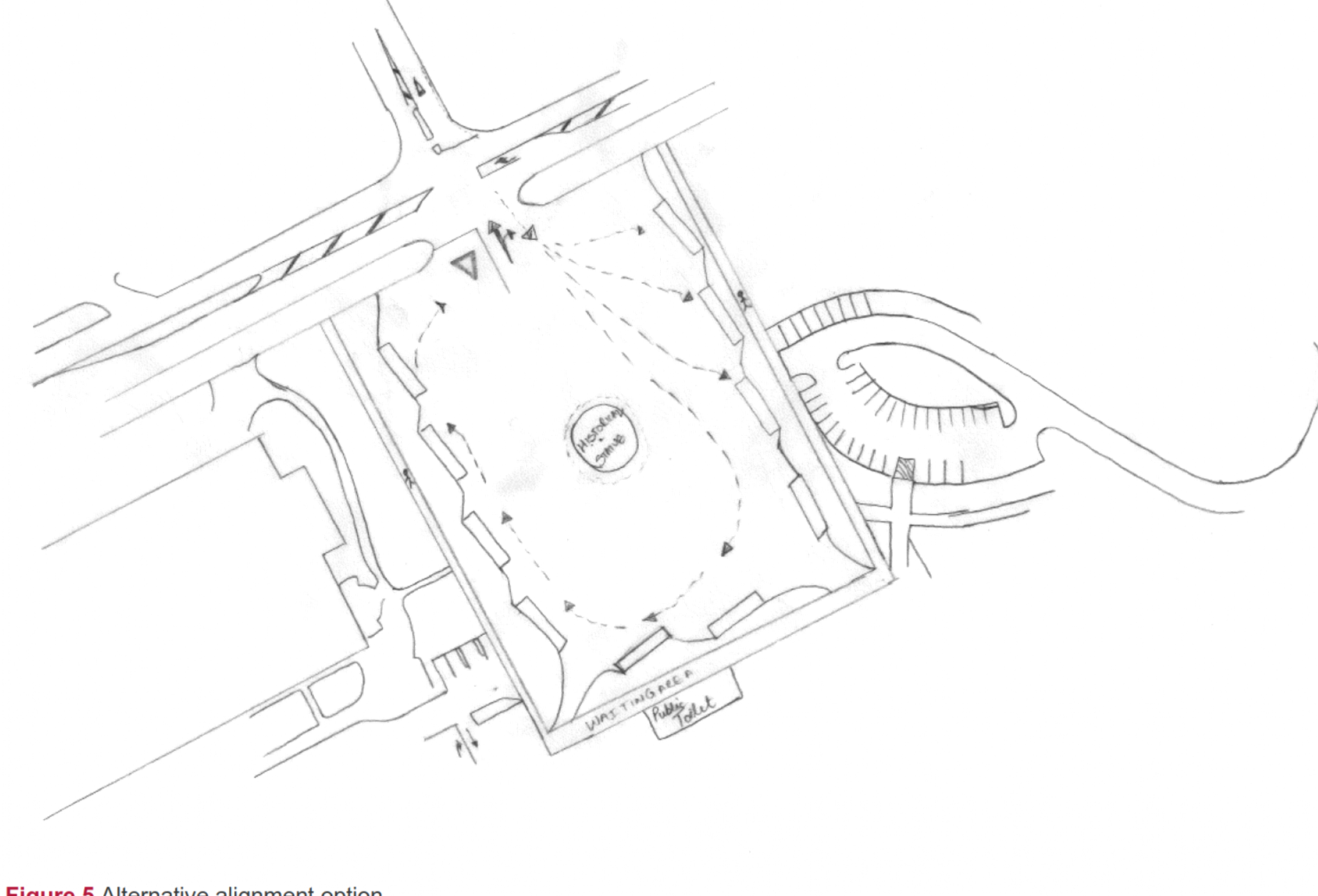|

|
|
AGENDA
Ordinary Council Meeting
Monday, 21 June 2021
|
|
I hereby give notice that an Ordinary Meeting of
Council will be held on:
|
|
Date:
|
Monday, 21 June 2021
|
|
Time:
|
10.30am
|
|
Location:
|
Tauranga City Council
Council Chambers
91 Willow Street
Tauranga
|
|
Please
note that this meeting will be livestreamed and the recording will be
publicly available on Tauranga City Council's website: www.tauranga.govt.nz.
|
|
Marty Grenfell
Chief Executive
|
Membership
|
Chairperson
|
Commission Chair Anne Tolley
|
|
Members
|
|
|
Quorum
|
Half of the members physically present, where the
number of members (including vacancies) is even; and a majority
of the members physically present, where the number of members (including
vacancies) is odd.
|
|
Meeting
frequency
|
As required
|
Role
·
To ensure the effective and
efficient governance of the City
·
To enable leadership of the City
including advocacy and facilitation on behalf of the community.
Scope
·
Oversee the work of all
committees and subcommittees.
·
Exercise all non-delegable and
non-delegated functions and powers of the Council.
·
The powers Council is legally prohibited from delegating include:
o Power to make a
rate.
o Power to make a
bylaw.
o Power to borrow
money, or purchase or dispose of assets, other than in accordance with the
long-term plan.
o Power to adopt
a long-term plan, annual plan, or annual report
o Power to
appoint a chief executive.
o Power to adopt
policies required to be adopted and consulted on under the Local Government Act
2002 in association with the long-term plan or developed for the purpose of the
local governance statement.
o All final
decisions required to be made by resolution of the territorial
authority/Council pursuant to relevant legislation (for example: the approval
of the City Plan or City Plan changes as per section 34A Resource Management
Act 1991).
·
Council has chosen not to delegate the following:
o Power to
compulsorily acquire land under the Public Works Act 1981.
·
Make those decisions which are required by legislation to be made
by resolution of the local authority.
·
Authorise all expenditure not delegated to officers, Committees
or other subordinate decision-making bodies of Council.
·
Make appointments of members to the CCO Boards of
Directors/Trustees and representatives of Council to external organisations.
·
Consider any matters referred from any of the Standing or Special
Committees, Joint Committees, Chief Executive or General Managers.
Procedural matters
·
Delegation of Council powers to Council’s committees and
other subordinate decision-making bodies.
·
Adoption of Standing Orders.
·
Receipt of Joint Committee minutes.
·
Approval of Special Orders.
·
Employment of Chief Executive.
·
Other Delegations of Council’s powers, duties and
responsibilities.
Regulatory matters
Administration,
monitoring and enforcement of all regulatory matters that have not otherwise
been delegated or that are referred to Council for determination (by a
committee, subordinate decision-making body, Chief Executive or relevant
General Manager).
7 Confirmation
of Minutes
7.1 Minutes
of the Council Meeting held on 31 May 2021
File
Number: A12623282
Author: Jenny
Teeuwen, Committee Advisor
Authoriser: Robyn
Garrett, Team Leader: Committee Support
|
Recommendations
That the Minutes of the Council Meeting held on 31 May 2021
be confirmed as a true and correct record.
|
Attachments
1. Minutes
of the Council Meeting held on 31 May 2021
|
 Ordinary
Council Meeting Minutes Ordinary
Council Meeting Minutes
|
31 May 2021
|
|

|
|
MINUTES
Ordinary Council Meeting
Monday, 31 May 2021
|
Order of Business
1 Opening
Karakia. 3
2 Apologies. 3
3 Public
Forum.. 3
4 Acceptance
of late items. 3
5 Confidential
business to be transferred into the open. 3
6 Change to
the order of business. 3
7 Confirmation
of Minutes. 4
7.1 Minutes,
Open and Publix Excluded, of the Council meeting held on 10 May 2021. 4
8 Declaration
of conflicts of interest 4
9 Deputations,
Presentations, Petitions. 4
Nil
10 Recommendations from Other
Committees. 4
10.1 Recommendation
from Ngā Poutiriao ō Mauao. 4
11 Business. 4
11.1 Executive
Report 4
11.2 Revocation
of Independent Hearings Commissioners Policy. 6
11.3 Bay
Venues Limited Board Remuneration Review 2021. 7
11.4 Traffic
& Parking Bylaw 2012 - Amendment No.29. 8
11.5 Amendment
to the Traffic and Parking Bylaw 2012 to prohibit heavy vehicles in Mt
Maunganui 8
11.6 Harington
Street Transport Hub - advice from Office of the Auditor-General 9
11.7 Hearing
of submissions on the draft Acquisitions and Disposals Policy. 10
12 Discussion of Late Items. 14
13 Closing Karakia. 14
MINUTES OF Tauranga City Council
Ordinary Council
Meeting
HELD AT THE Tauranga
City Council, Council Chambers, 91 Willow Street,
Tauranga
ON Monday, 31 May
2021 AT 9am
PRESENT: Commission
Chair Anne Tolley, Commissioner Shadrach Rolleston, Commissioner Stephen
Selwood and Commissioner Bill Wasley
IN
ATTENDANCE: Marty Grenfell (Chief Executive), Paul
Davidson (General Manager: Corporate Services), Barbara Dempsey (General
Manager: Regulatory & Compliance), Nic Johansson (General Manager:
Infrastructure), Christine Jones (General Manager: Strategy & Growth),
Gareth Wallis (General Manager: Community Services), Daniel Smith (Manager:
Environmental Planning), Janine Speedy (Team Leader: City Planning), Nick
Swallow (Manager, Legal & Commercial), Ariell King (Team Leader: Policy),
Brigid McDonald (Manager: Strategic Investment & Commercial Facilitation), Coral
Hair (Manager: Democracy Services), Robyn Garrett (Team Leader: Committee
Support), Raj Naidu (Committee Advisor) and Jenny Teeuwen (Committee Advisor)
1 Opening
Karakia
Commissioner
Shadrach Rolleston opened the meeting with a Karakia.
2 Apologies
Nil
3 Public
Forum
Nil
4 Acceptance
of late items
Nil
5 Confidential
business to be transferred into the open
Nil
6 Change
to the order of business
Nil
7 Confirmation
of Minutes
|
7.1 Minutes,
Open and Publix Excluded, of the Council meeting held on 10 May 2021
|
|
Resolution CO9/21/1
Moved: Commissioner Bill
Wasley
Seconded: Commissioner
Stephen Selwood
That the Council:
(a)
Confirms the open minutes of the Council
meeting held on 10 May 2021 as a true and correct record.
(b)
Confirms the public excluded minutes of the Council
meeting held on 10 May 2021 as a true and correct record.
Carried
|
8 Declaration
of conflicts of interest
Nil
9 Deputations,
Presentations, Petitions
Nil
10 Recommendations
from Other Committees
|
10.1 Recommendation
from Ngā Poutiriao ō Mauao
|
|
Resolution CO9/21/2
Moved: Commissioner Bill
Wasley
Seconded: Commissioner
Stephen Selwood
That the
Council accepts the recommendation to Council from Ngā Poutiriao ō
Mauao that Commissioner Shadrach Rolleston be appointed to the position of
Deputy Chair of Ngā Poutiriao ō Mauao.
Carried
|
11 Business
|
11.1 Executive
Report
|
|
Staff Marty
Grenfell, Chief Executive
Barbara Dempsey, General Manager:
Regulatory & Compliance
Christine Jones, General Manager:
Strategy & Growth
Paul Davidson, General Manager
Corporate Services
Nic Johansson, General Manager:
Infrastructure Services
Gareth Wallis, General Manager:
Community Services
Key
points
·
Strategy and Growth
-
An update on the Papamoa East Interchange project was provided.
·
Infrastructure Services
-
Kerbside Collection – the roll out of bins was on
track. Communication to the community via a range of media was now
focussed on education around how to use the bins.
-
Totara Street – as had been previously reported to the
Commission at the Strategy, Finance and Risk Committee meeting on 17 May,
funding from Waka Kotahi (New Zealand Transport Agency - NZTA) was not
available in this financial year and the project was now on hold.
·
People and Engagement
-
TCC were back in negotiations with PSA in terms of finalising
the collective employment agreement.
-
A successful health and safety site visit had been undertaken
of the Waiāri site.
·
Regulatory and Compliance
-
The work load for the Building and Environmental Planning teams
continued to increase and recruiting, training and retaining staff in these
areas continued to be challenging.
-
$330,000 in grants had been received to support TCC with the
management of freedom camping and for three emergency management projects
currently underway.
·
Community Services
-
Just under 50 applications had been received for directors for
Bay Venues Limited (BVL). Applications were now with the appointments
panel.
-
Elizabeth Street streetscape project was progressing well.
-
The final design for Kulim Park was now on TCC’s website
with work starting in August.
·
Corporate Services
-
The three external business activities - Airport, Marine
Precinct and Beachside Holiday Park – continued to perform strongly.
-
Finance staff were currently extremely busy with the LTP
submission process.
-
Cyber security – additional work to ramp up the
organisation’s cyber security (started prior to the Waikato District
Health Board incident) was continuing and would be ongoing.
In
response to questions
·
Strategy and Growth
-
Engagement with tangata whenua for the Tauriko for Tomorrow
project had been strong and was not identified as a risk so had not been
highlighted in the report.
-
Once technical work had been completed for the long term
transport options for the Tauriko for Tomorrow project, this would be brought
back to Council to seek endorsement for a formal Tauranga City Council (TCC)
position.
-
The Commissioners looked forward to receiving a comprehensive
briefing on options for the strategic route through Tauriko to ensure a
solution that worked strategically as well as locally.
·
Infrastructure Services
-
Kerbside collection – Staff had worked with multi-unit
dwellings to provide the best solution for them. There were bespoke
truck options.
-
The Waiāri water supply scheme – the scheme was
expected to be switched on by the end of 2022. Only 30% of the
consented volume would be used initially so there was capacity for future
growth.
-
Totara Street – it was frustrating and concerning that
this project was now on hold. Commissioners were scheduled to meet with
the regional manager of Waka Kotahi tomorrow and possible alternative options
for funding for the Totara Street project would be raised at that meeting.
·
Community Services
-
Some funding indicated from partners for the Kāinga Tupu
work was for a one year commitment, some for slightly longer. The
coordination function would remain with TCC in the short term, the next six
to twelve months. The TCC share of funding was contained within the
Long Term Plan (LTP).
-
Staff were working hard to influence TCC projects regarding
accessibility for disabled persons. $400,000 per annum over the next
ten years for Spaces and Places accessibility initiatives was in the LTP, not
just for TCC projects but also for projects happening in the community.
-
There were strong community views for and against the Kulim
Park and Omanawa Falls projects. Engagement with those communities
would continue so what was happening and why was clearly understood, and to
enable those communities to continue to put forward their views and ideas.
·
Corporate Services
-
Thousands of attempts to hack in to TCC systems were happening
on a weekly basis and capacity and focus was being increased in this
area. An external cyber review had been undertaken around six months
ago. The review report and TCC’s action plan would be brought
back to a future Strategy, Finance and Risk Committee meeting.
-
Modelling of potential Development Contribution (DC) funding
for future community infrastructure would be for both growth and existing
areas.
-
The Airport had a $2million per year return; the majority
coming through commercial property rather than the airport operation.
The Marine Precinct was comparable in the rates it offered; however, the
services it offered were not as complete as other facilities and therefore was
slightly behind in breaking even.
Overall comment from Commissioners
The Chief Executive report was a good commentary that
provided Commissioners with a clear oversight across each department of where
things were at; however, the following suggestions were made for other key
data to be included, preferably graphed:
-
Regulatory and Compliance - data on meeting consent timeline
requirements, consents received that were rejected as not fit for purpose,
and trends up and down for these.
-
Infrastructure services - On time, on budget data.
-
For each department - staff turnover rates, level of staff
engagement, sentiment of staff and trends up and down for these.
|
|
Resolution CO9/21/3
Moved: Commissioner
Shadrach Rolleston
Seconded: Commissioner
Stephen Selwood
That the Council receives the Executive Report.
Carried
|
|
11.2 Revocation
of Independent Hearings Commissioners Policy
|
|
Staff Barbara
Dempsey, General Manager: Regulatory & Compliance
Daniel Smith, Manager:
Environmental Planning
Janine Speedy, Team Leader: City
Planning
In
response to questions
·
Commissioner performance expectations and how those would be
measured would be stipulated as part of the contract agreement.
Timeframes had been pushed out in the past mostly due to the availability of
commissioners.
|
|
Resolution CO9/21/4
Moved: Commissioner Bill
Wasley
Seconded: Commissioner
Shadrach Rolleston
That the Council:
(a)
Receives the Revocation of Independent
Hearings Commissioners Policy report.
(b) Revokes
the current Independent Hearings Commissioners Policy effective from 31 May
2021, with the exception of clause 5.6 (Costs Associated with Independent
Hearings Commissioners) which will continue until the date the Council adopts
the Schedule of User Fees and Charges for 2021/22;
(c) Revokes
the current Delegations to Independent Hearings Commissioners;
(d) Makes
the delegations specified in Attachment 1 (titled Delegations to
Independent Hearings Commissioners) to all persons who are accredited to
conduct hearings in terms of sections 39A and 39B of the Resource Management
Act 1991 (other than local body elected members), as named on the Ministry
for the Environment’s list of ‘Making Good Decisions’ Certificate holders - non-local body elected members
or any equivalent list, as amended from time to time (“Independent
Hearings Commissioner”);
(e) Delegates
to the Chief Executive, General Manager: Regulatory and Compliance and
Manager: Environmental Planning (“Delegate/s”)* for resource consents:
(i) the
authority to select and appoint one or more Independent Hearings
Commissioner(s) to act in respect of any particular matter; and
(ii) where
there is more than one Independent Hearings Commissioner selected and
appointed for the particular matter, the authority to appoint the chair and
any deputy chair.
* For the purposes of this delegation,
the Delegate includes any staff member who performs or exercises the same or
substantially similar role or function to the Delegate’s position named
above, whatever the actual name of their position.
(f) For
Schedule One processes Council continues to determine on a case-by-case basis
the selection and appointment of persons for hearings on City Plan changes
and variations under Schedule 1 of the Resource Management Act 1991;
(g) Requests
that an administrative procedure to guide the selection and appointment of
Independent Hearings Commissioners be developed and adopted by the Executive
Leadership Team.
(h) Notes that resolutions (b) to
(e) are effective as of 1 June 2021.
Carried
|
|
11.3 Bay
Venues Limited Board Remuneration Review 2021
|
|
Staff Gareth
Wallis, General Manager: Community Services
In
response to questions
·
The assessment methodology used was TCC developed, but was
based on a model that Auckland Council used when they carried out the same
exercise for their council controlled organisations.
|
|
Resolution CO9/21/5
Moved: Commissioner
Stephen Selwood
Seconded: Commissioner
Bill Wasley
That the Council:
(a) Receives
the Bay Venues Limited Board Remuneration Review 2021 report.
(b) Agrees
that the remuneration for the directors of Bay Venues Limited Board should
remain the same, being:
(i) Base
director fee set at $33,000 per annum; and
(ii) Chair
fee at $66,000 per annum.
(c) Agrees
a remuneration review for the Bay Venues Limited Board be included in the
remuneration review for all council-controlled organisations, next scheduled
for 2023.
Carried
|
|
11.4 Traffic
& Parking Bylaw 2012 - Amendment No.29
|
|
Staff Nic
Johansson, General Manager: Infrastructure Services
|
|
Resolution CO9/21/6
Moved: Commissioner
Shadrach Rolleston
Seconded: Commissioner
Bill Wasley
That the Council:
(a) Receives the Traffic
and Parking Bylaw 2012 Amendments Report.
(b) Adopts the proposed amendments
to the Traffic and Parking Bylaw 2012 Attachment as per Appendix B, effective
from 1 June 2021.
Carried
|
|
11.5 Amendment
to the Traffic and Parking Bylaw 2012 to prohibit heavy vehicles in Mt
Maunganui
|
|
Staff Nic
Johansson, General Manager: Infrastructure Services
A copy of
the tabled map for this item can be viewed on Tauranga City Council’s
website in the Minutes Attachments document for this council meeting.
In
response to questions
·
Application of the new bylaw and what it meant for the network
would be monitored. Results from the monitoring exercise, along with
any associated recommendations, would be reported back to council within six
months after the bylaw had come into effect.
|
|
Resolution CO9/21/7
Moved: Commission Chair
Anne Tolley
Seconded: Commissioner
Bill Wasley
That the Council:
(a) Receives
the Amendment to the Traffic and Parking Bylaw 2012
to prohibit heavy vehicles in Mt Maunganui report.
(b) Specifies that pursuant to
clause 8.2 of the Traffic and Parking Bylaw 2012 heavy motor vehicles are
prohibited at all times from the following streets:
· Aintree
Place
· Ascot
Place
· Ascot
Road
· Berescourt
Place
· Berwick
Place
· Carter
Street
· Carysfort
Street
· Compton
Place
· Concord
Avenue
· Crane
Street
· Epsom
Road
· Kinross
Place
· Harris
Street
· Huia
Avenue
· Lachlan
Avenue
· Leander
Street
· Links
Avenue
· Paterson
Street
· Pukaki
Street
· Salt
Avenue
· Solway
Place
· Spur
Avenue
· Stawell
Avenue
· Surf
Road
· Part
of Farm Street between Farm Street and Concord Ave
· Part
of Taupo Avenue between Marlin Street and Paterson Street
· Part
of Oceanbeach Road between Golf and Girven Roads
Carried
|
|
Attachment
1 Map
- Heavy vehicles ban in Mount Maunganui
|
|
11.6 Harington
Street Transport Hub - advice from Office of the Auditor-General
|
|
Staff Nick
Swallow, Manager: Legal & Commercial
In
response to questions
·
It was suggested that the recommendation in the McHale Group
report regarding a regular independent probity auditor review, be included in
the recommendations of this report.
·
Implementation of the review recommendations, particularly in
the project governance management space, would be difficult and would take
some time. The report due back to council in September would be an
audit of progress made against the recommendations.
·
Supplier panels were set up to provide expertise in specific
areas and had a good place in the procurement ecosystem; however, it was not
ideal to appoint for expertise A, but actually engage for expertise B.
The Auditor General had advised that this needed to be reviewed.
·
If approved through the LTP process, the recruitment for two
additional procurement roles would begin in August.
|
|
Resolution CO9/21/8
Moved: Commissioner
Stephen Selwood
Seconded: Commissioner
Bill Wasley
That the Council:
(a)
receives the Harington Street
Transport Hub - advice from Office of the Auditor‑General report.
(b)
Implements a regular (e.g. annual)
independent probity auditor review of a sample of Council project governance
and a review of procurement processes to provide assurance that the
Council’s policies and procedures and probity expectations are being
complied with and probity-procurement risk exposure is being satisfactorily
managed.
Carried
|
|
11.7 Hearing
of submissions on the draft Acquisitions and Disposals Policy
|
|
Staff Ariell
King, Team Leader: Policy
|
|
Resolution CO9/21/9
Moved: Commissioner
Stephen Selwood
Seconded: Commissioner
Shadrach Rolleston
That the Council:
(a)
Receives the Hearing of submissions on the draft Acquisitions and
Disposals Policy report.
Carried
|
|
The following submitters to the draft Acquisitions and
Disposals Policy were then heard.
Barry Scott - Submission 102
A copy of the
additional submission information tabled by Mr Scott can be viewed on
Tauranga City Council’s website in the Minutes Attachments document for
this council meeting.
Key points
·
Believed proper and fair consultation had not taken place.
·
Suggested that council set up a Round Table type of mechanism
to go over the ground again and come back to the commissioners with more
rounded recommendations. The Round Table could consist of council staff
members, selected community representatives and members of tangata whenua.
·
Believed that the granting of a right of first refusal (RFR) to
Tangata Whenua was a badly thought out idea and could be open to a court
challenge.
·
Urged council to consider the establishment of community boards
in Tauranga, to provide consultation and involvement at a grass roots level.
In response to questions
·
Rather than making RFR mandatory in the policy it was suggested
that council reserve the right, and let circumstances at the time decide
whether it was appropriate to offer first right of refusal to iwi.
·
The Commission were keen to find ways to bring more community
feedback into council and would consider the Round Table idea.
|
|
Puhirake
Ihake – Ngati Tapu Hapu - Submission 054
Key
points
·
The policy was important for tangata whenua and was a long time
coming.
·
The whenua that this policy related to went back historically
to the way it originally came into council’s hands; the large majority
having been retained by the Crown who, via legislation, passed the land over
to territorial authorities. Very little had been given back to Tangata
Whenua and Council still had properties that had come through that original
process.
·
·
The Tangata Whenua collective was formed formally with council
in 2002, had evolved since then and had grown stronger over the years.
·
It had always been the main aspiration of Tangata Whenua to not
only get compensation for the land that was lost through the Crown but also
to try to get back the whenua.
·
RFR gave Tangata Whenua the opportunity of fairly getting the
land back, albeit having to purchase it back.
·
The policy gave Council the opportunity to clearly spell out
that it was honouring the principles of the Treaty of Waitangi, as well as
acknowledging the relationship with Tangata Whenua over the past 20 years.
·
Ngati Tapu were in absolute support of the policy.
|
|
Whitiora
Mcleod - Submission 008
Key
points
·
Ngati Kahu believed the policy was nothing but positive and
supported the policy as it read today.
·
Ngati Kahu fully understood the process and objectives of the
policy.
·
If no wahi tapu was identified through the property search
process, then the market value would be paid.
·
Acknowledged Danna Leslie for her contribution to developing
and writing the policy alongside tangata whenua.
·
Also acknowledged Carlo Ellis for providing key strategy advice
which should be used going forward.
·
Commended Tenby Powell, Heidi Hughes, Tina Salisbury, Jako
Abrie and Bill Grainger for their openness and vision to put the policy
forward.
·
Thanked past and present Te Rangapū Mana Whenua o Tauranga
Moana hapu representatives and the commissioners for their part in the
journey.
·
Believed the policy was good not only for Tangata Whenua, but
also for the city as a whole.
In
response to questions
·
Hapu boundaries were clear within the protocols developed by Te
Pou Takawaenga for council processes, however within those boundaries there
were historical overlapping interests. When dealing with these pieces
of land, generally mana whenua would take the lead, but in discussion with
other hapu leads. The main decisions would be made during these
discussions and generally before they came to council.
·
The way the land that was currently held by council had come to
council, either originally through the Crown or other processes, supported
the RFR being in the policy.
|
|
Buddy Mikaere – Ngai Tamarawaho - Submission 080 and
104
Key points
·
Spoke in support of the policy.
·
The policy provided the means for tangata whenua to acquire the
land that council found surplus to its needs.
·
Pleased that after many years and with the support of Te
Rangapū Mana Whenua o Tauranga Moana and other iwi and hapu in Tauranga,
this point had finally been reached.
|
|
Maureen
Anderson - Submission 031
Key
points
·
Ms Anderson did not support the policy and believed it was only
the squeaking minority who were being heard.
·
Land had been acquired by council in many different ways.
No matter how the land had been acquired, it had previously been owned by
someone who had paid rates on it and maintained it at their cost. When
the land came in to council ownership, it was the collective ratepayer who
paid the cost of maintaining and/or upgrading it. In Ms
Anderson’s opinion, it was untenable to give any one section of the
community a prior right to the purchase of that land. It should be
offered back to the prior owner at market value and if the offer was not
taken up, the land should go to the open market at market value.
·
The Commissioners were the best advocates to promote to
government that it was an unfair burden on ratepayers to pay for land that
was ultimately given to Māori, or any other section of the community,
because it had been maintained and sometimes paid for by the ratepayers of
the city generally.
In
response to questions
·
The sale of any land that was not under claim by Tangata Whenua
and had been purchased by the public, should go to referenda for the public
to decide if the land should be sold.
·
Any council land coming up for sale should first be offered
back to the previous landowner or the title holder at the time.
|
|
Jim
Sherlock - Submission 026
Key
points
·
If ratepayers assets were to be disposed of, this should be
done at market value.
·
The method of disposal should be by auction. It was a
transparent method that allowed for public participation and the sale price reflected
what market was prepared to pay. Most importantly, it allowed
ratepayers to know that the price paid on the day reflected what the assets
were really worth.
·
Suggested that once an asset had gone through the auction
process, then a RFR could be given to Tangata Whenua at the auction price,
with a 30 days option to buy the land post auction, otherwise the asset would
be disposed of to the successful bidder.
In
response to questions
·
The need to give due compensation to tangata whenua for land
that was confiscated, often without compensation, should be a matter for the
government, not a council matter. Ratepayers should not have to keep
paying for mistakes that were made 150 years ago.
|
|
Hayden
Henry – Hungahungatoroa 1B2B2 Trust - Submissions 074 and 61
Key
points
·
Spoke in support of the policy.
·
The connection to whenua was vital to Tangata Whenua.
·
It was about how to bring balance; and balance was about
people, not about economic gain.
·
Land that had been taken by council had, in cases, been abused
e.g. Whareroa and the management of air quality.
·
Traditional boundaries were governed by maunga and awa, not
boundaries imposed by council.
|
|
At
11.33am, the meeting adjourned.
At 1.12pm,
the meeting resumed.
|
|
John
Robson - Submission 055
Key
points
·
Spoke in support of the twin outcomes of policy.
·
Expressed concern that the report failed to provide the content
necessary for people to understand why the report recommendations were being
made.
·
·
None of the aspirations of Tangata Whenua spoken about today
had been outlined in the report.
·
Expressed concern that the policy did not help the community
understand why they needed to support the seeking of some process that
delivered the desired outcomes of the policy.
·
Recommended that the process was paused and more thought be
given to how to get informed consent from the community.
In
response to questions
·
There was an opportunity to inform the community of the
history/background of the issue and the commissioners were urged to take
this.
|
|
Rob
Paterson – Citizens Advocacy Tauranga Incorporated (CAT) - Submission
088
A copy of the additional submission information tabled by Mr
Paterson can be viewed on Tauranga City Council’s website in the
Minutes Attachments document for this council meeting.
Key
points
·
CAT did not support the merging of the three existing policies
– Strategic Acquisitions Fund Policy, Council Land Recognition of
Tangata Whenua Interests and Aspirations Policy (MAP) and Property
Acquisitions and Divestment Road Stopping Policy.
·
Considered that the current draft MAP policy financially
disadvantaged Tauranga ratepayers and residents, and believed the current
2014 MAP policy adequately addressed the matter.
·
The timeframes set were excessive and unworkable, effectively
allowing for an option to purchase for up to a year.
·
Requested that the status quo be retained and the three
policies remain separate, and that TCC retained the 2014 MAP Policy which was
working reasonably well.
In
response to questions
·
The current three policies had all gone through a submissions
process.
|
|
Richard
Prince - Submission 033
A copy of
the additional submission information tabled by Mr Prince can be viewed on
Tauranga City Council’s website in the Minutes Attachments document for
this council meeting.
Key
points
·
It appeared that the main reason why Tangata Whenua supported
the RFR was to make money.
·
Provided examples that clearly demonstrated problems with
valuations under RFR, including what had occurred at 60 Chapel Street.
·
Valuations were an art, not a science, which enabled valuers to
tailor a valuation to meet their client’s requirements, and for that
reason market valuations might have little validation and were likely to
short change ratepayers.
·
Council land was in essence privately owned and Council was
entrusted with the care of these assets on behalf of the community. It
was not for Council to gift or sell community assets at a discount, to the
disadvantage of ratepayers.
·
Recommended that land assets be put to auction or tender so
that all could participate and a true market value could be achieved.
·
Requested that the RFR be removed from the draft policy.
|
|
Rob
Paterson - Submission 101
A copy of
the additional submission information tabled by Mr Paterson can be viewed on
Tauranga City Council’s website in the Minutes Attachments document for
this council meeting.
Key
points
·
Did not support the merging of the three policies as previously
stated when speaking to submission number 88.
·
Did not support the current Maori Land Acquisitions Policy.
·
Supported other submissions in opposition, particularly those
of Richard Prince, Barry Scott and Maurice O’Reilly.
·
Provided the examples of Dive Crescent, 60 Chapel Street and 11
Mission Street as matters that impinged on the current policy proposals.
·
The flowchart indicated a timeline of up to 60 weeks. In
Mr Paterson’s view, it could be done in 14 days. An option to
purchase at an initial offer price that could then be delayed for up to a
year looked like a very good deal for the buyer, but not for the vendor; in
this case, Tauranga city residents and ratepayers.
·
Requested that the Commissioners reject the draft proposal in
its entirety and retain the status quo.
In
response to questions
·
It was suggested that buyers were presented with TCC’s
valuation in the first instance and then had 30 days to decide on whether to
purchase or not.
·
If the land was a straight sale, then it was suggested it go
out to the public with a very limited timeline to purchase. TCC could
always go back to tangata whenua to see if there was any interest to buy if
the offers that had been received were below TCC’s valuation.
|
|
Resolution CO9/21/10
Moved: Commissioner
Stephen Selwood
Seconded: Commissioner
Shadrach Rolleston
That the Council:
(b) Receives the verbal and written
submissions (Attachment A) to the proposed Acquisitions and Disposals
Policy.
Carried
|
|
Attachments
1 Tabled Item -
Barry Scott - Additional information in support of submission #102
2 Tabled item -
Rob Paterson - Information in support of submission #88
3 Tabled item -
Richard Prince - Information in support of submission #33
4 Tabled item -
Rob Paterson - Information in support of submission #101
|
12 Discussion
of Late Items
Nil
13 Closing
Karakia
Commissioner
Shadrach Rolleston closed the meeting with a Karakia.
The meeting closed at 1.58pm.
The minutes of this meeting were confirmed as a true and
correct record at the ordinary Council meeting held on 21 June 2021.
..................................................................
CHAIRPERSON
11 Business
11.1 Alcohol
Control Areas
File
Number: A12564997
Author: Jane
Barnett, Policy Analyst
Ariell King, Team Leader:
Policy
Authoriser: Barbara
Dempsey, General Manager: Regulatory & Compliance
Purpose of the Report
1. To consider the
request for an alcohol ban to be put in place in the Twelfth Avenue area.
|
Recommendations
That Council:
(a) Does not put in place an
alcohol ban in the Twelfth Avenue area as there is insufficient evidence that
the area has experienced a high level of crime and disorder caused or made worse
by alcohol consumption in the area.
(b) Continues to work with the
Police to investigate a potential action plan for Twelfth Avenue.
|
Executive Summary
2. Council
has received two petitions regarding homelessness and behaviour in the Twelfth
Avenue area. One of the petitions specifically requested an alcohol ban on
Twelfth Avenue. This report briefs Council on the legal requirements for
putting an alcohol ban in place. The legal conditions for introducing a new ban
are high.
3. The
available evidence is presented for Council to consider. This includes feedback
from the petitions, complaints received by Council and New Zealand Police data
and comments.
4. Police
report that there is no demonstrable link between alcohol and offending in and
around Twelfth Avenue. As a result, the Police do not support the imposition of
an alcohol ban in that area.
5. In
response to the key issue of some residents not feeling safe, Council and the
Police are investigating a potential action plan for the area.
Background
6. On the 10th
May 2021, two petitions were presented to Council. One requested that
‘Council stop all homeless people from being on our street’ –
Twelfth Avenue. The second petition requested an alcohol ban in the
Twelfth Avenue area. This report responds to the request for an alcohol ban in
the area.
7. Section 147 of the
Local Government Act 2002 (the Act) gives Council the power to make bylaws to
control alcohol in public places. The Alcohol Control Bylaw 2018 (the
‘Bylaw’) was made under this Act and sets alcohol-free areas across
the city.
8. Clause 8 of the
Bylaw allows Council, through publicly notified resolution, to put in place
alcohol-free areas for a specific time period and/or event (‘temporary
alcohol-free area’).
9. The Bylaw is
enforced by the New Zealand Police. The Act provides the enforcement powers to
the Police. Council’s Bylaw Officer’s do not have power to enforce
alcohol-free areas.
Requirements for making an Alcohol Control Bylaw and
Temporary Alcohol-free area
10. There are two options to consider
for making a new alcohol- free area. One is to review and amend the bylaw to
put in place a new area. The second option is to explore implementing a
temporary alcohol ban under clause 8 of the Bylaw.
11. Both options require a high
threshold for introducing a new ban. The criteria for making alcohol control bylaws changed in 2013
when the Local Government (Alcohol Reform) Amendment Act came
into effect.
12. The Act requires that before it
makes a new bylaw, continues an existing bylaw, or replaces an existing bylaw,
Council must be satisfied that:
· the
bylaw can be justified as a reasonable limitation on people’s rights and
freedoms (section 147A(1)(a));
· there
is evidence that any new alcohol-free areas have experienced a high level of
crime and disorder that can be shown to have been caused or made worse by
alcohol consumption in that area (section 147A(1)(b)(i));
· for
expiring bylaws, that a high level of crime or disorder made worse by alcohol
consumption is likely to arise in the area to which the bylaw is intended to
apply if the bylaw was not made (section 147A(3)(b)); and
· the
alcohol ban is appropriate and proportionate in the light of that crime and
disorder (section 147A(1)(b)(ii)).
13. All the conditions above must also
be met when putting in place temporary alcohol-free areas (under clause 8 of
the Bylaw) unless the area is part of a large-scale event.
Consideration
of evidence
14. To put in place a new alcohol-free
area in Twelfth Avenue Council must be satisfied that there is evidence that
the Twelfth Avenue area has experienced a high level of crime and disorder that
can be shown to have been caused or made worse by alcohol consumption in that
area.
Community Feedback
15. Feedback from the Twelfth
Avenue community presenting the petitions provided some evidence of crime
(break in) but there was no conclusive evidence that this crime was caused by
alcohol consumption in the area.
16. There was a strong message
that some residents felt threatened and intimated by the presence of people
gathering in the area: ‘Some people won’t go past them as they
are very intimidating’, ‘Staff felt unsafe and
intimidated’. They also reported (and provided photos) of the litter
and mess in the area: ‘The mess that is left behind is
terrible’.
Police data
17. The New
Zealand Police have compared the temporal and spatial distribution of calls for
service and incidents in the Twelfth Avenue area with Brookfield. Brookfield
has a permanent 24-hour 7 day a week alcohol ban in place under the current
bylaw. Brookfield is the same sized area of a similar use. It has a small
shopping centre close to residential areas. The Police report that: ‘Whilst
there are naturally differences in the jobs attended, the data at the Twelfth
Avenue site does not show any major inconsistencies with the compared
area’ (Brookfield)).
18. The evidence provided by the call
out data does not indicate a higher level of crime and disorder in Twelfth
Avenue when compared to a similar area with an existing alcohol ban. 33 calls
for service were received by the Police over the past 12 months compared with
30 for Brookfield.
19. It is also important to note that
not all the calls for service may be directly attributable to alcohol.
20. Police have reviewed the data and
conclude that ‘there is no demonstrable link between alcohol
and offending in and around Twelfth Avenue, as a result Police will not be in a
position to support the imposition of a liquor ban in that area’.
Council Complaints
21. Council has received four complaints
since March 2021 reporting incidents in Twelfth Avenue. These complaints
reported drinking in a public place, rubbish and at times obstruction of
entrances and aggressive behaviour.
22. Council’s Bylaws Officer
responded to three of these reports by visiting the area and asking those
drinking to relocate. The other compliant was regarding threatening aggressive
behaviour so the person reporting this was asked to contact the Police.
The Issue
23. The residents and business operators
in Twelfth Avenue do not feel safe and are frustrated with having to deal with
rubbish and mess left by those gathering in the area.
24. However, on balance, the available
evidence, does not indicate a high level of crime and disorder caused or made
worse by alcohol. Even if Council was satisfied that a high level of crime and
disorder caused by alcohol is currently occurring, it is important to
acknowledge that an alcohol ban may not be the most effective way of addressing
the community’s concerns.
25. The
concern is largely around the gathering of people on Twelfth Avenue. If an
alcohol ban was in place and alcohol was being consumed in the area, the Police
would have the power to seize and remove the alcohol. However, this may not
result in people leaving the area. And if they did leave Twelfth Avenue area,
they may cause an issue in another part of the community.
26. The issue is chronic and complex. It
impacts on the entire Tauranga community. Tauranga has many social service
agencies working to support individuals in need. Council has produced a flyer ‘He Awhina Mōu - Need a Hand’ that lists our local
support agencies.
27. Council also has a
resource that helps people work out who to contact when they are concerned for
someone’s wellbeing. This sets out the situations where Council can
assist and when Police are required. This resource is available on our website https://www.tauranga.govt.nz/Portals/0/data/community/homelessness/who-to-contact.pdf.
28. Council will
continue to raise awareness of these resources so that our community is aware
of where to go for help and support.
29. In response to the
concerns raised by the Twelfth Avenue community Police and our Safe and
Resilient Communities Advisor are investigating a potential action plan for the
community.
Options Analysis
30. The
key issue to be considered is whether Council is satisfied that Twelfth Avenue
has experienced a high level of crime and disorder that can be shown to have
been caused or made worse by alcohol consumption.
31. If
Council decide that there is evidence for an alcohol ban, there are two options
for putting it in place; a temporary ban or amending the current bylaw to
create a permanent ban for the area.
32. The
following options are provided for consideration:
(a) Do not proceed with work on a
new alcohol ban at this stage and continue to work with the Police to
investigate a potential community action plan
(b) Bylaw review to amend the
Bylaw
(c) Put in place a temporary
alcohol ban in Twelfth Avenue under clause 8 of the current Bylaw, with a view
to investigating if this helps address the issues raised by the community.
Option (a): Do not proceed with work on a new alcohol ban and
continue to partner with the Police to investigate a potential community action
plan (Recommended).
33. Under
this option, Council would continue to partner with the Police and other
community support organisations to investigate a potential action plan for the
Twelfth Avenue community. Council would also continue to inform the community
of where to get further help.
34. The
advantages and disadvantages of this option include:
|
Advantages
|
Disadvantages
|
|
· Allows Council
and the Police to focus and direct resources to addressing the fundamental
issue
· Legal compliance
with the requirements for putting in place an alcohol banAllows
Council’s Bylaw Officers to continue their work building relationships
with the community. If a ban was in place the Police would be required to
enforce it.
|
· The Twelfth
Avenue community may not feel their concerns have been addressed sufficiently
· The Police would
not have enforcement powers in respect of the Bylaw if people are drinking
alcohol in Twelfth Avenue.
|
|
Budget - Capex
|
$0
|
|
Budget - Opex
|
Within existing budget
|
|
Key risks
|
Risk that the community in
Twelfth Avenue may not feel Council is responding to their concerns
|
|
|
|
Option (b): Review the Alcohol Control Bylaw 2018
35. Under
this option, Council would review the Alcohol Control Bylaw 2018 with a view to
amending it to make Twelfth Avenue an alcohol-free area. Bylaw reviews must
follow the specific process set out in the Act. Community consultation would be
required.
|
Advantages
|
Disadvantages
|
|
· Police would
have enforcement powers under the Bylaw to stop or arrest people who
were drinking alcohol in the Twelfth Avenue area
· Alcohol related
harm and crime may be reduced in the Twelfth Avenue area
· The Twelfth Avenue
residents and business owners would be satisfied that Council had put in
place an alcohol-free area
· The review
allows other alcohol-free areas to be considered.
|
· Other policy and
bylaw work would need to be delayed to accommodate this bylaw review
into the work programme
· May not be
effective in addressing the fundamental issue
· May be seen to
not meet the legal requirements of an alcohol ban due to a lack of evidence
to demonstrate that a high level of crime and disorder has been caused or made
worse by alcohol consumption in that area (section 147A(1)(b)(i))
· The bylaw review
is a lengthy process so any potential ban would not take effect immediately
· Implementation
costs.
|
|
Budget - Capex
|
$0
|
|
Budget - Opex
|
$4 000 indicative estimate of
implementations costs – for required signage, public notification and
communications
|
|
Key risks
|
Delay of other policy and bylaw
work
May not be effective in addressing the fundamental
issue.
May not be seen as meeting the
legal requirements of the Act for alcohol bans.
|
|
|
|
Option (c): Activate a temporary alcohol ban in the Twelfth Avenue
area and examine if this helps address the issues raised by the community.
36. Under
this option, Council would put in place a temporary alcohol-free area in place
in the Twelfth Avenue area. This would be implemented by publicly notified
resolution under clause 8 of the Bylaw.
|
Advantages
|
Disadvantages
|
|
· Police would
have enforcement powers under the Bylaw to stop or arrest people who were
drinking alcohol in the Twelfth Avenue area
· This would allow
further data to be gathered to determine if the ban was effective in
addressing community concerns before considering a permanent ban
· Alcohol related
harm and crime may be reduced in the Twelfth Avenue area while the ban is in
place
· The Twelfth
Avenue residents and business owners would be satisfied that Council had put
in place an alcohol-free area.
·
|
· May be seen to
not meet the legal requirements of an alcohol ban due to a lack of evidence
to demonstrate that a high level of crime and disorder has been caused or
made worse by alcohol consumption in that area (section 147A(1)(b)(i)) May
not be effective in addressing the fundamental issue
· May require an
additional ban in other areas if people move away from Twelfth Avenue to
consume alcohol in other areas of the city.
· Implementation
costs.
|
|
Budget - Capex
|
$0
|
|
Budget - Opex
|
$4 000 indicative estimate of
implementations costs – for required signage, public notification and
communications
|
|
Key risks
|
May not be effective in
addressing the fundamental issue.
May not be seen as meeting the
legal requirements of the Act for alcohol bans.
|
|
|
|
Financial and Legal Considerations
37. The
financial and legal considerations are covered in the options analysis above.
Significance
38. The
Local Government Act 2002 requires an assessment of the significance of
matters, issues, proposals and decisions in this report against Council’s
Significance and Engagement Policy. Council acknowledges that in some
instances a matter, issue, proposal or decision may have a high degree of
importance to individuals, groups, or agencies affected by the report.
39. In
making this assessment, consideration has been given to the likely impact, and
likely consequences for:
(a) the current
and future social, economic, environmental, or cultural well-being of the
district or region
(b) any persons who are likely to be
particularly affected by, or interested in, the issue, proposal, decision, or
matter
(c) the capacity of the local authority to
perform its role, and the financial and other costs of doing so.
40. In
accordance with the considerations above, the recommended decision on how to
respond to the request for an alcohol ban in the Twelfth Avenue area, is
considered of low significance. However, the fundamental issue facing
the city (as outlined above) is significant.
ENGAGEMENT
Taking
into consideration the above assessment, that the recommended decision is
of low significance, officers are of the opinion that no further
engagement is required prior to Council making a decision. However, if
Council was to make a decision to proceed with either option two or three there
would be engagement and consultation requirements as set out by the existing
bylaw and the LGA.
Next Steps
41. If Council support the
recommendation not to put an alcohol ban in place Police and Council’s Safe and Resilient Communities Advisor will continue to investigate
an action plan for the Twelfth Avenue community.
42. If Council decide to review the
Alcohol Control Bylaw 2018, Council staff will report back with the
implications of this decision on the Policy and Bylaw’s current work
programme and a timeline for this work.
43. If Council decided to implement a
temporary alcohol-free area, staff will report back on the specific area
covered, the duration of the ban and what times of day the ban would apply.
Under the Act any alcohol ban must be justified as a reasonable limitation on
people’s rights and freedoms and be appropriate and proportionate in the
light of that crime and disorder.
Attachments
Nil
11.2 Strategy,
Finance and Risk Committee - Remuneration for appointed members
File
Number: A12601222
Author: Coral
Hair, Manager: Democracy Services
Authoriser: Susan
Jamieson, General Manager: People & Engagement
Purpose of the Report
1. This report
recommends remuneration for external members appointed to the Strategy, Finance
and Risk Committee.
|
Recommendations
That the Council:
(a) Receives the report “Strategy,
Finance and Risk Committee – Remuneration for appointed members”.
(b) Approves the remuneration of
$22,000 per annum for the external members appointed to the Strategy, Finance
and Risk Committee who have voting rights.
(c) Approves the remuneration of
$12,000 per annum for Te Rangapū Mana Whenua o Tauranga Moana
Chairperson appointed to the Strategy, Finance and Risk Committee.
(d) Approves the remuneration of
$26,400 per annum for the Deputy Chairperson of the Strategy, Finance and
Risk Committee.
|
Executive Summary
2. The
Council resolved on 27 April 2021 to establish the Strategy, Finance and Risk
Committee and set the interim remuneration for the externally appointed members
and requested that this be reviewed and reported back to the Council.
3. Strategic
Pay was engaged to undertake the remuneration review and have recommended that
the voting representatives be remunerated in the range $20,000 to $22,000 per
annum, the non-voting representative be remunerated in the range of $11,000 to
$12,000 per annum and the Deputy Chairperson be remunerated in the range of
$24,000 to $26,400 per annum.
4. It
is recommended that the remuneration be set at the higher end of the ranges.
Background
5. The
Council resolved on 27 April 2021:
(g) Requests
the Chief Executive review the remuneration for the external representatives
and reports back to the Council as soon as practicable.
(h) In
the interim until the remuneration has been reviewed, approves the remuneration
for the external members of the Strategy, Finance and Risk Committee as
follows:
· Tangata
Whenua Representatives $8,000 per annum
· Chairperson
Te Rangapū Mana Whenua o Tauranga Moana $8,000 per annum
· External
independent appointee - Chief Executive to negotiate an amount
(i) Delegates
to the Chief Executive the authority to determine the contractual terms and
conditions of appointment for the externally appointed members, excluding
remuneration.
6. Advice
has been sought from Strategic Pay on the appropriate level of remuneration for
the appointees to the Committee and their report is set out in Attachment
1.
7. Position
descriptions were provided to Strategic Pay and are attached to the report as
follows:
(a) Tangata Whenua representatives
– Attachment 2
(b) Rangapū Chair – Attachment
3
(c) External independent appointee
– Attachment 4
8. Strategic
Pay’s approach was to:
(a) Review the remuneration
Councillors receive and the relativity to Committee remuneration;
(b) Consider the broader
marketplace for governance fees including the Cabinet Fees framework and other
broader work they have conducted;
(c) Look at Committee fee levels
and overall fee levels compared to data collected and analysed in their annual February 2021 New Zealand Directors’
Fees Survey.
9. Strategic
Pay recommend that the voting representatives be remunerated in the range of
$20,000 to $22,000 per annum based primarily on the relationship between
Councillor remuneration and estimated time commitments for the externally
appointed members, which are estimated to be double that of the previous
appointed committee members. The fees of around 20% of the Councillors
remuneration without positions of responsibility of $105,628 per annum would
arrive at an annual fee of $21,125.
10. Strategic
Pay also considered that all roles, except the Chairperson of Te Rangapū
Mana Whenua o Tauranga Moana, are full voting members of the Committee and that
the Committee provides input into the long term strategic direction of Tauranga
City Council. The extent, context and scope of the workload was important
in setting the fee levels and they applied the State Services
Commission’s Fee Framework scoring methodology which positioned this as
median, with a base annual fee of $21,700.
11. Strategic
Pay also considered the Director Fee market. The roles were positioned in the
lower quartile with a base annual fee of $20,000.
12. Given
this consistency Strategic Pay has recommended a range of $20,000 to $22,000
per annum for the voting representatives.
13. The
Chairperson of Te Rangapu Mana Whenua o Tauranga Moana was appointed to the
Committee in an advisory position, without voting rights, designed to ensure
mana whenua discussions are connected to the committee. Strategic Pay has
recommended remuneration in the range of $11,000 to $12,000 per annum which
aligns with the State Services Commission Framework. This lower fee recognises
the role is advisory in nature and is similar to their previous recommendations
in 2019 for remuneration for Tangata Whenua representatives who were
appointed without voting rights at that time.
14. Dr
Wayne Beilby was elected as the Deputy Chairperson of the Committee. Strategic
Pay has recommended the remuneration for the Deputy Chairperson be in the range
of $24,000 to $26,400 per annum based on a ratio of 1.2 or 20% more than the
remuneration for the voting representatives.
15. In
2019 Strategic Pay reviewed and benchmarked remuneration levels for external
representatives of standing committees, including the independent chairperson
of the Finance, Audit and Risk Committee (with voting rights and casting vote)
and the Tangata Whenua representatives (without voting rights at that time).
Strategic / Statutory Context
16. Clause
31(1) Schedule 7 of the Local Government Act (LGA 2002) provides that Council
may appoint or discharge any member of a committee. Clause 31(3) provides
for the Council to appoint persons who are not members of the Council to its
committees if, in the
opinion of the local authority, that person has the skills, attributes, or
knowledge that will assist the work of the committee.
17. Section 14 of the LGA 2002 requires
a local authority, in performing its role, to act in accordance with the
principles specified. These principles include, in subsection 14(1)(d),
that a local authority should provide opportunities for Māori to contribute to its
decision-making processes.
18. Section 81(1)(a) and (b) of the LGA
2002 require that a local authority must (a) establish and maintain processes to
provide opportunities for Māori to contribute to the decision-making
processes of the local authority; and (b) consider ways in which it may foster
the development of Māori capacity to contribute to the decision-making
processes of the local authority.
Options Analysis
Option 1 – Set
remuneration based on Strategic Pay advice – Recommended option
19. In
this option the Council would accept the expert advice provided by Strategic
Pay and set the remuneration for voting members, the non-voting member and the
Deputy Chairperson based on the ranges supplied.
20. The
Council has the option of setting remuneration anywhere in the ranges provided
by Strategic Pay.
21. This
option would be consistent with the previous decisions regarding remuneration
for externally appointed members based on advice from Strategic Pay.
Option 2 – Set
remuneration not based on Strategic Pay advice
22. In
this option the Council could set remuneration at levels that are not based on
Strategic Pay advice.
23. This
option is not recommended as the Council would not be guided by expertise in
this matter.
Financial Considerations
24. The
current budget provides for remuneration for representatives appointed to
Council committees of $77,000 per annum. An increase of $27,400 per annum would
be required to accommodate the increases proposed in this report. This increase
can be absorbed into the current remuneration budgets.
Legal Implications / Risks
25. There
are no legal implications or risks associated with remunerating externally
appointed members to Council Committees.
Significance
26. The
Local Government Act 2002 requires an assessment of the significance of
matters, issues, proposals and decisions in this report against Council’s
Significance and Engagement Policy. Council acknowledges that in some
instances a matter, issue, proposal or decision may have a high degree of
importance to individuals, groups, or agencies affected by the report.
27. In
making this assessment, consideration has been given to the likely impact, and
likely consequences for:
(a) the current
and future social, economic, environmental, or cultural well-being of the
district or region
(b) any persons who are likely to be
particularly affected by, or interested in, the remuneration of externally
appointed representatives.
(c) the capacity of the local authority to
perform its role, and the financial and other costs of doing so.
28. In
accordance with the considerations above, criteria and thresholds in the
policy, it is considered that the decision is of low significance.
ENGAGEMENT
29. Taking
into consideration the above assessment, that the decision is of low significance,
officers are of the opinion that no engagement is required prior to Council
making a decision. Click here to view the TCC
Significance and Engagement Policy
Next Steps
30. Update the Agreements with the
representatives.
Attachments
1. Strategic Pay -
Review of remuneration for appointed members of Strategy, Finance and Risk
Committee - A12601111 ⇩ 
2. Position
Description - Tangata Whenua Representative to SFRC - A12633212 ⇩ 
3. Position
Description - Rangapu Chair to SFRC - A12633214 ⇩ 
4. Position
Description External Independent Appointee to SFRC - A12633213 ⇩ 
|
Ordinary Council
Meeting Agenda
|
21 June 2021
|











|
Ordinary Council Meeting Agenda
|
21 June 2021
|



|
Ordinary Council Meeting Agenda
|
21 June 2021
|



|
Ordinary Council Meeting Agenda
|
21 June 2021
|



11.3 Lime
e-scooter trial update
File
Number: A12543084
Author: Andy
Vuong, Programme Manager - Cycle Plan Implementation
Authoriser: Nic
Johansson, General Manager: Infrastructure
Purpose of the Report
1. Provide an update
on the progress of the Lime e-scooter trial
|
Recommendations
That the Council:
(a) Receives the report Lime
e-scooter trial update.
|
Executive Summary
2. The
one-year Lime e-scooter trial has surpassed the halfway point and the following
key insights have been observed through the first seven months of the trial
period:
(a) Demand for scooters has been
strong and usage higher than expected.
(i) 23,000 people have
taken at least one ride
(ii) 140,000 trips taken
totalling 220,000 kilometres travelled
(iii) Ridership is highest in the
Mount Maunganui area
(b) Opposition to the trial was
immediate and passionate, but the quantity and frequency of complaints has
reduced greatly as the trial progressed.
(i) Approximately 175
enquires/complaints in total received by Council
(1) 103
received in the first 8 weeks (Oct 29 – Dec 31)
(2) 10
received in the last 8 weeks (Apr 5 – May 31)
(ii) The most frequent
complaint is generally around how scooters are parked – either impeding
the use of a footpath or being placed on a berm outside of someone’s
property.
3. A high degree of
public interest has been observed during e-scooter trials in other NZ
cities. Accordingly, we will undertake public consultation in August to
obtain a broad spectrum of feedback from the community on their desires and
this feedback will be included in the final trial report.
Background
4. At
the Oct 6, 2020 Council meeting, a 12-month e-scooter trial with Lime NZ was
unanimously approved to proceed. Details on the operating conditions of the
trial and areas with usage restrictions can be found in Attachment A.
5. Lime
began a “soft launch” of e-scooters on October 29th,
gradually increasing the number of scooters available to hire over the next 72
hours. For purposes of the trial, November 1st is considered
the official start date.
6. For
the first 6 weeks, approximately 250 scooters were made available for hire. In
mid-December, that number increased to between 350-375 and has remained at
those levels till present day.
7. To
help analyse ridership information, Council has been utilising an online
software platform from Ride Report to collect and visualise trip data. Using
data from the first seven months of the trial, a sample of the types of
questions the tool can help answer are:
(a) How long do people ride an
e-scooter per trip?
(i) 33%
are less than 5 minutes, 25% are between 5 – 10 minutes, 23% are between
10 – 20 minutes, and 21% are greater than 20 minutes.

(b) Where do most people start
their trip?
(i) Trips
are most likely to begin in the Mount Maunganui and Tauranga CBD /
entertainment areas. Trip starts in the Mount are approximately double
that of the CBD/Strand.

(c) What time of day are scooters
used the most?
(i) 20% happen before
12PM, 10% happen after 9PM, with the remaining 70% split pretty evenly each
hour between 12PM – 9PM.

8. Reports
of injuries or accidents have been low, with Council receiving five reports of
an incident to date. To understand if under reporting has occurred, we
will work with ACC and Police to determine if their data paints a different
picture.
9. We
have been satisfied with Lime NZ’s performance as Council’s
operating partner for the trial. Lime NZ has:
(a) worked at pace with residents,
businesses, and schools to mitigate their specific concerns or complaints
(b) engaged with organisers of
large events (e.g. Bay Dreams, One Love, Tinman Triathlon, etc) and modifying
their operations to mitigate health and safety concerns
(c) supported Tourism Bay of
Plenty’s concept of a food tour by e-scooter (Dine on a Lime) and
provided free/discounted trips
(d) hosted new rider workshops and
pushed additional messaging via their app to promote safer rider behaviour
Financial Considerations
10. Revenue
and expenses of the trial are tied to the total number of trips taken, with a
$0.15 operator fee levied on Lime NZ and $0.0225 usage fee payable to Ride
Report for each trip taken. Through the first seven months of the trial:
(a) Operator fees have totalled
$21,000
(b) Ride Report usage fees have
totalled $3100
11. Aside
from staff time to manage the trial and respond to public feedback, no other
expenses have occurred to date.
Consultation / Engagement
12. Staff
are planning to undertake public consultation in August to obtain feedback from
the community on the impacts of the trial and what outcomes related to shared
e-scooters they prefer.
13. Results
of the consultation will be incorporated into the evaluation of the trial and
inform the recommendation on how to proceed.
Significance
14. The
Local Government Act 2002 requires an assessment of the significance of
matters, issues, proposals and decisions in this report against Council’s
Significance and Engagement Policy. Council acknowledges that in some
instances a matter, issue, proposal or decision may have a high degree of
importance to individuals, groups, or agencies affected by the report.
15. In
making this assessment, consideration has been given to the likely impact, and
likely consequences for:
(a) the current
and future social, economic, environmental, or cultural well-being of the
district or region
(b) any persons who are likely to be particularly
affected by, or interested in, the issue, proposal, decision, or matter
(c) the capacity of the local authority to
perform its role, and the financial and other costs of doing so.
16. In
accordance with the considerations above, criteria and thresholds in the
policy, it is considered that the issue is of medium significance,
however the general update provided in this report is of low
significance.
Next Steps
17. We will:
(a) Continue to monitor the trial
over the remaining 5 months, focusing on demands and impacts over the winter
which is expected to be the lowest period to e-scooter usage.
(b) Prepare for and undertake
public consultation with the community in August.
(c) Complete an evaluation of the
full trial and public consultation feedback to inform a recommendation on what
Council should do with shared e-scooters.
Attachments
1. Attachment
A - Lime e-scooter trial approval report - Oct 6 2020 - A12616106 ⇩ 
|
Ordinary Council
Meeting Agenda
|
21 June 2021
|



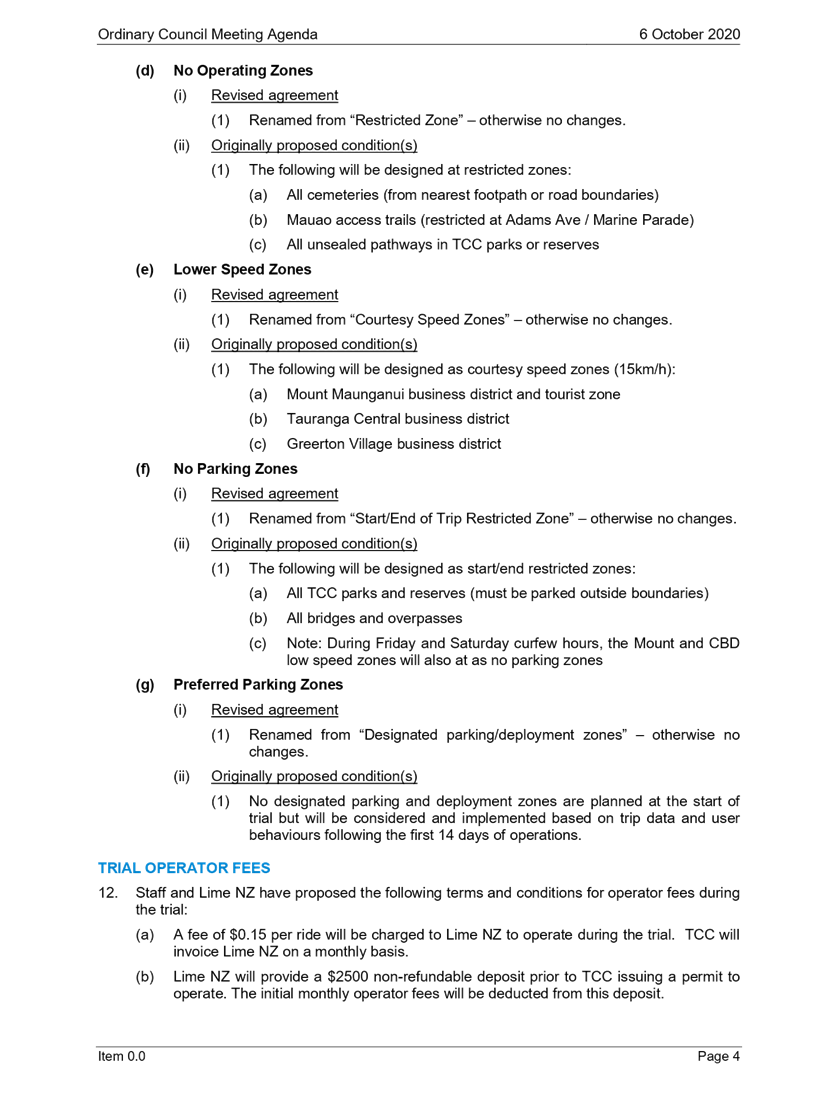
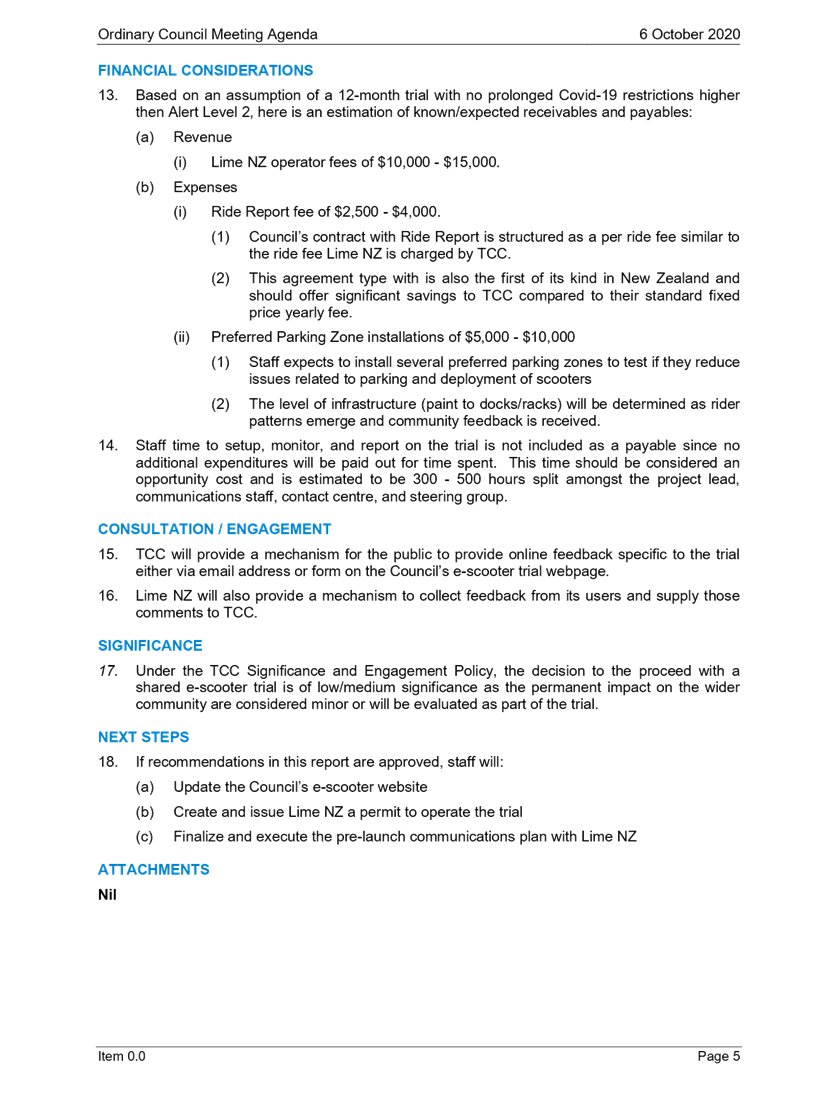
11.4 Arataki
Bus Facility
File
Number: A12550571
Author: Alistair
Talbot, Team Leader: Transport Strategy & Planning
Peter Siemensma, Senior
Transport Planner
Authoriser: Christine
Jones, General Manager: Strategy & Growth
Purpose of the Report
1. To provide an
overview of the Arataki Bus Facility project, a summary of the issues
associated with this, and set out the next steps for the project including
their estimated timeframes.
|
Recommendations
That the Council:
(a) Receives the report
“Arataki Bus Facility”.
(b) Notes that Waka Kotahi New
Zealand Transport Agency co-investment to develop a business case to identify
a preferred site for a facility has been confirmed.
(c) Notes the Next Steps, Issues
and Estimated Timeframes associated with developing the business case to
support funding decisions, and likely statutory consents and approvals for a
bus facility at the preferred site.
|
Executive Summary
2. Quality public
transport infrastructure that is integrated with its surrounding urban
environment and the transport network supports the objectives of the Urban Form
& Transport Initiative (UFTI) and the Western Bay of Plenty Transport
System Plan (WBTSP).
3. The current temporary
bus facility on Farm Street in the Arataki area is the second busiest public
transport facility in Tauranga but is not satisfactory for bus users or local
residents and creates issues from a bus network operations perspective. It is
difficult to make significant further transport network improvements in the
broader area until a permanent location for the facility has been determined.
4. Sites for a
permanent facility throughout Arataki have been assessed with the area around
Farm Street generally performing best as it provides good access to key
destinations as well as the residential catchment north of State Highway 2.
5. Previous
investigations have shortlisted two sites for further investigation, these are:
(a) Part of Arataki Park currently
used by St. John Ambulance on Girven Road; and
(b) A location within the Bayfair shopping
centres site accessed from Farm Street.
6. The previous
investigations have identified that the Bayfair site performs better than the
Arataki Park site. However, both sites have advantages and disadvantages from a
bus user, community and network operations perspective.
7. Co-funding from
Waka Kotahi to develop a Single-stage business case (business case) to further
investigate the two sites to identify a preferred site has now been
confirmed.
8. The next steps for
the Arataki Bus Facility project (the Project) is to develop the business case
to:
(a) Identify a preferred site or
sites for a permanent bus facility;
(b) Develop the preliminary design
for the preferred bus facility;
(c) Identify and develop the
preliminary design for associated nearby network improvements (e.g.
intersection improvements, walking & cycling connections) required to
support the safe and effective operation of the facility.
9. Community
consultation and engagement is required as part of developing the business case
and is proposed. A detailed consultation and engagement plan is to be
developed. The outcomes of the consultation and engagement are also used to support
applications for statutory approvals required to implement the preferred
option.
10. This report is intended to update
Council on the next steps, issues and timeframes for the project.
Background
11. The temporary bus facility on Farm
Street (operational since mid-2018) is not satisfactory for bus users or local
residents and creates issues from a network (e.g. bus service operations) and
local community perspective.
12. Some Farm Street residents are
concerned about volume and speed of buses and traffic as well as social issues
occurring at the bus facility. There are wider concerns for the safety of other
road users, particularly those on bikes and walking to local schools. Whilst
some issues have been addressed, it is difficult to make significant further
improvements within the wider Arataki area without determining the long-term
location and format of the bus facility.
13. The existing temporary facility does
not perform from a network perspective, as there is no ability for buses to
turn around safely, necessitating a loop around local streets (increasing the
impact of the facility on residents). Currently, 31 buses per hour depart from
the existing bus facility, although without the need for looping, this would
represent 21 movements per hour (since many “terminating” services
layover for a few minutes and become a departing service). Bay of Plenty
Regional Council have identified that a facility allowing buses to turn around
would allow them to remove all buses from Leander Street and almost halve the
number of current movements along Farm Street.
14. The current facility has the second
highest boarding numbers for the city. This reflects the key destinations
nearby as well as being a location serving a significant residential catchment.
Non-transfer boardings at the facility have consistently exceeded 20,000 people
per month with total boardings (including transfers) exceeding 30,000 pre-Covid.

Strategic / Statutory Context
15. Quality public transport
infrastructure is important and aligned to the strategic direction provided by
the UFTI. In addition, the Western Bay of Plenty Transport System Plan
identifies a public transport facility in the Arataki area.
Options Analysis
16. The
purpose of the business case is to investigate and identify a preferred site
for a permanent bus facility in the Arataki area. It is noted that this
investigation may find that the preferred facility is provided over two sites
(e.g. partly on Girven Road and partly on Farm Street). In addition to this the
business case will include:
(a) Development of the preliminary
design for the preferred facility;
(b) Investigate and identify
associated necessary nearby network improvements (e.g. intersection
improvements, walking & cycling connections) required to support the safe
and effective operation of the facility.
17. Investigations
undertaken to date have assessed a number of sites throughout the Arataki area.
This work identified the area around Farm Street as generally performing best
as it serves the key destinations in the area as well as the residential
catchment.
Sites
Investigated

18. The Transport System Plan (TSP)
‘Combined Public Transport Services and Infrastructure business
case’ is currently being scoped. That business case is expected to
address matters like the future bus service operating model and confirm the general
location, scale and timing of infrastructure (like a bus facility) to support
this. It is not expected to identify that there is no facility required in the
Arataki area. It is noted that both UFTI and the TSP have confirmed the need
for a facility in this area. There will however need to be close integration of
these two business cases as they develop.
19. It is noted that regardless of the
location of the permanent bus facility, Grenada Street, Farm Street and Links
Ave continue to form the key route for public transport through the Arataki
area. Whilst State Highway 2 is expected to carry some express services, the
local street network provides the permeability for Arataki residents from
Sandhurst Drive to Golf Road to access public transport within a convenient
walk distance.
20. The investigations undertaken to
date have also confirmed the need to progress a broader project to manage
transport movements through the Arataki area, provide for the safe movement of
all road users and improve amenity. Confirming the long-term location for the
Arataki bus facility is essential to successfully progressing this.
21. The investigations undertaken to
date have shortlisted two sites (refer to Attachment 1 for Site Plans for each
short-listed site):
· Part of Arataki Park currently
used by St. John ambulance on Girven Road; and
· A location within the
Bayfair Shopping Centre site accessed from Farm Street.
22. Of these two shortlisted sites the
Bayfair site has been identified as performing better than the Arataki Park
site option. From a transport network, bus service operations and customer
perspectives the key reasons for this relate to:
(a) the likely bus and pedestrian
demand on the planned signals at the Farm Street / Marlin Street intersection;
(b) the manoeuvring and potential
bus and pedestrian conflict point issues relating to either possible layout for
the St. John site.
(c) The Arataki Park site would
require greater provision of facilities for both drivers and passengers, but it
would be feasible to include these in the design development.
(d) Personal safety and social
issues for the Arataki Park site could be problematic due to the lack of
passive surveillance from pedestrians and traffic. Mitigation can be provided
but it would not perform as well as the Bayfair site which is busier and
overlooked by residents as well as the day/night activity of the Mall.
(e) Both likely layouts for the
Arataki Park site would create issues for transferring passengers, in terms of
the likely walk distance and number of crossing points within the facility to
access different stops.
(f) A survey of bus users
undertaken in 2019, identifies a strong preference for the facility to be
located at or very close to the existing facility. The survey also identified
that Bayfair (or a home within a short walk) are the key destinations for trips
ending at the facility (rather than other destinations around Girven Road).
23. However, it should be noted that the
Arataki Park site does allow a greater scope for future expansion of the facility
if required and would have the benefit of being developed on publicly
controlled land.
Business case
and Consenting & Approval processes
24. A business case is required by Waka
Kotahi for an activity (above $2m cost) to be eligible for National Land
Transport Fund (NLTF) investment at the Councils Funding Assistance Rate of 51%
of the total project cost. In addition, the business case process provides
analysis and information to support other consenting and approval processes
(e.g. under the Resource Management Act) that are required to establish a bus
facility on either of the two shortlisted sites.
25. Prior to commencing a business case
Waka Kotahi require that a ‘Point of Entry’ (PoE) be agreed. This
assessment sets out the reason for the need to develop a business case, the
process for its development and the associated costs. It is the document on
which Waka Kotahi base their decision to invest in a business case.
26. Developing and agreeing the PoE with
Waka Kotahi is an iterative process. It includes ongoing discussion and
feedback to allow the document to be finalised. Once finalised the PoE is
submitted to decision-makers within Waka Kotahi. Developing and agreeing the
PoE for this project has taken considerable time, 10 months, and delayed
earlier progress of this project.
27. The investigations undertaken to
date have identified that:
(a) The Bayfair site would require
resource consent, which could be a lengthy and contested process due to likely
opposition from affected residents. It is possible that any resource consent
decision by Council could be appealed to the Environment Court.
(b) The Arataki Park site would
require the reserve status of the site to be revoked, a lengthy public process
requiring Ministerial approval (Minister of Conservation).
Arataki Park is zoned “Active Open Space” in the City Plan. Also,
the majority of the Park site, excluding the area where the St Johns activity
is located, is designated for the purpose of “Sub regional multisport
park”. A bus facility may be permitted as a “community
facility” in the Active Open Space zone but would still require resource consent
for access onto the “strategic road network” (i.e. Girven Road).
The business case would further assess and confirm the resource consent
requirements for the Arataki Park site.
28. The business case development,
including community consultation and engagement, and statutory consenting and
approval processes to enable the establishment of a bus facility is estimated
to take around 2 years to complete. This timeframe is influenced by the issues
(e.g. technical option development, consultation, planning and land ownership
issues) associated with each of the short-listed sites and the need for robust
community consultation and engagement on the options to identify a preferred
site.
29. The estimated business case and
statutory approval timeframes are broken down in Table 1, below.
Table
1: Estimated Timeframes
|
Activity
|
Estimated Timeframe
|
Comments
|
|
Procurement
|
2-months
|
· Open market
procurement approach to confirm a supplier.
· Appoint supplier(s) to
deliver the business case and support public consultation and engagement.
|
|
Business case
development to identify the preferred option
|
6-8 months
|
· Options development
and analysis
· Community consultation
& engagement
· Preliminary design
development
· Benefit cost analysis
Note: This timeframe
will be influenced by feedback received to the consultation and engagement
and the issues that this raises which need to be addressed.
|
|
Decision-making
on the preferred option
|
1-2 months
|
· Council
decision-making on recommended preferred option.
· Waka Kotahi
decision-making on the preferred option and next stage investment (i.e.
statutory approvals; detailed design & implementation)
Note: Likely
that Waka Kotahi will stage or condition its funding approval in that
Implementation / Construction funding will be subject to first confirming all
necessary statutory approvals and consents.
There is also
some risk that Waka Kotahi funding for delivery will not be available due to
their wider funding pressures.
|
|
Statutory
consents & approvals
|
4-12 months
|
· Resource consent for
bus facility
· Arataki Park site:
Reserve status revocation or reclassification from Recreation reserve to
Local Purpose Reserve
Notes:
There is a
risk that a Local Purpose Reserve status is too restrictive and would not
allow the range of activities that a bus facility involves meaning only
revocation of the Reserve status is a viable option.
For a Reserve
re-classification, whilst it does require the Minister’s approval, this
approval is delegated to TCC as the administering body of the Reserve, so
wouldn’t need to be sent to the Minister of Conservation. However, that
doesn’t mean that TCC as the administering body can make a decision
that is inconsistent with the Reserves Act function and purpose.
|
Fast-track Option
30. Given the timeframes identified
above an option of developing a ‘fast-track’ business case has been
considered. A fast-track option would focus primarily on the ability to
condense the estimated 6-8 month business case development phase identified in
Table 1.
31. However, on balance it is considered
that condensing the analysis and engagement phase will expose Council to risk
in that that we won’t be able to demonstrate through any potential legal
challenge process that we have robustly assessed and engaged on the options.
Also, condensing this phase of work will introduce risk that could prevent
Council from securing funding from Waka Kotahi which would result in that cost
being transferred to the ratepayer.
32. As the business case develops and
feedback (e.g. level of support or otherwise) on the options is received the
estimated timeframe for the statutory consents and approvals process will be
able to be further considered.
Financial Considerations
33. Funding to undertake the Business
case has now been agreed (April 2021) with Waka Kotahi. The scope of the
business case is now being developed further to support procurement of a
supplier to undertake the investigation.
34. Waka Kotahi have informally
identified that they are unlikely to fund lease costs for Bayfair site or any
relocation costs for St. John’s ambulance from the Arataki Park site.
Bayfair are working to progress with a next stage of their development, and
they wish to have an indication from Council as to next steps in relation to
the proposed lease of a portion of their site, should that become the preferred
location.
35. The current Long Term Plan includes the
Arataki Bus Facility project and this is also included in the draft LTP as two
projects:
(a) Arataki Bus Facility investigation
– planning, business case, engagement, consenting & preliminary
design is scheduled for Years 1 to 3 of the LTP with an estimated budget of
approximately $1.2m.
(b) Arataki Bus Facility construction
– scheduled for Years 3 to 4 of the draft LTP with an estimated budget of
approximately $14m. It is noted that this is an early cost estimate that will
require further development as the options are assessed and developed through
the business case.
Consultation / Engagement
36. Council has been keeping the Arataki
community informed via e-newsletter and drop-in sessions with staff. In
addition, a pilot engagement approach has been developed for the Arataki area
by the Engagement team in partnership with Transport and other teams within
Council. This approach has sought to create an
overarching stakeholder reference group where projects like the Arataki Bus
Facility can be presented for feedback. Broader general community consultation
and engagement on the Project will also be required to support the business case
development and any subsequent statutory consenting or approval process.
Significance
37. The
Local Government Act 2002 requires an assessment of the significance of
matters, issues, proposals and decisions in this report against Council’s
Significance and Engagement Policy. Council acknowledges that in some
instances a matter, issue, proposal or decision may have a high degree of
importance to individuals, groups, or agencies affected by the report.
38. In
making this assessment, consideration has been given to the likely impact, and
likely consequences for:
(a) the current
and future social, economic, environmental, or cultural well-being of the
district or region
(b) any persons who are likely to be
particularly affected by, or interested in, the issue, proposal, decision, or
matter
(c) the capacity of the local authority to
perform its role, and the financial and other costs of doing so.
39. In
accordance with the considerations above, criteria and thresholds in the
policy, it is considered that the matter is of medium to high significance
due to a potentially high level of public interest.
ENGAGEMENT
40. Taking
into consideration the above assessment, that the matter is of medium-high
significance, officers are of the opinion that further consultation and
engagement is appropriate. As outlined earlier in the report this will
occur as part of the business case process.
Next Steps
41. The Projects next steps are
identified in Table 1 of this report and are focussed on procuring a
supplier(s) to develop the business case and support community consultation and
engagement on the Project.
42. In addition, staff will continue to
work together with Bay of Plenty Regional Council on the development of the TSP
Public Transport Combined Services and Infrastructure business case to further
inform and refine the requirements for the Arataki Bus Facility.
Attachments
1. Indicative
drawings for the Arataki Park site - A11630516 ⇩ 
2. Indicative
drawings for the Bayfair site - A11630511 ⇩ 
|
Ordinary Council
Meeting Agenda
|
21 June 2021
|
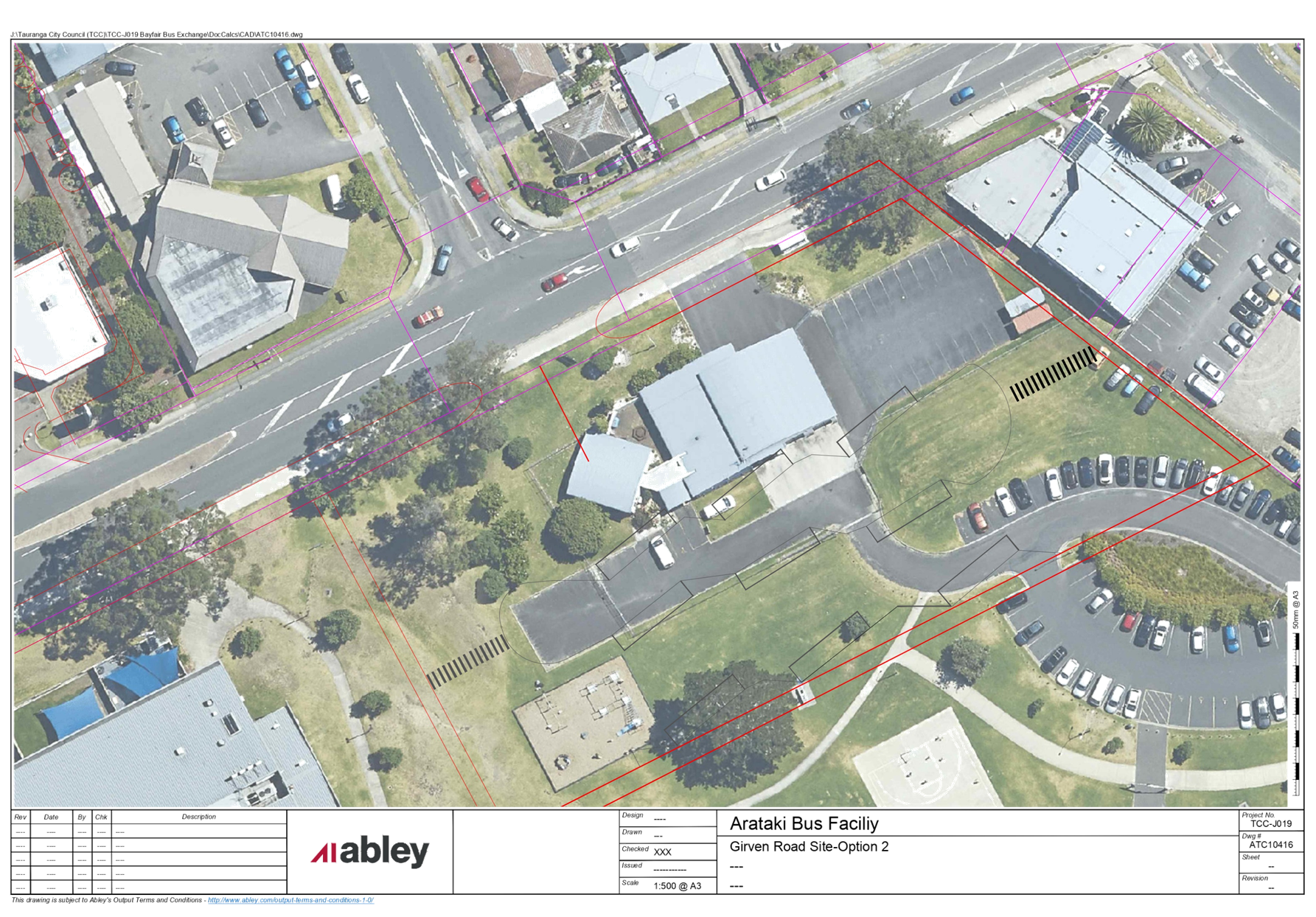
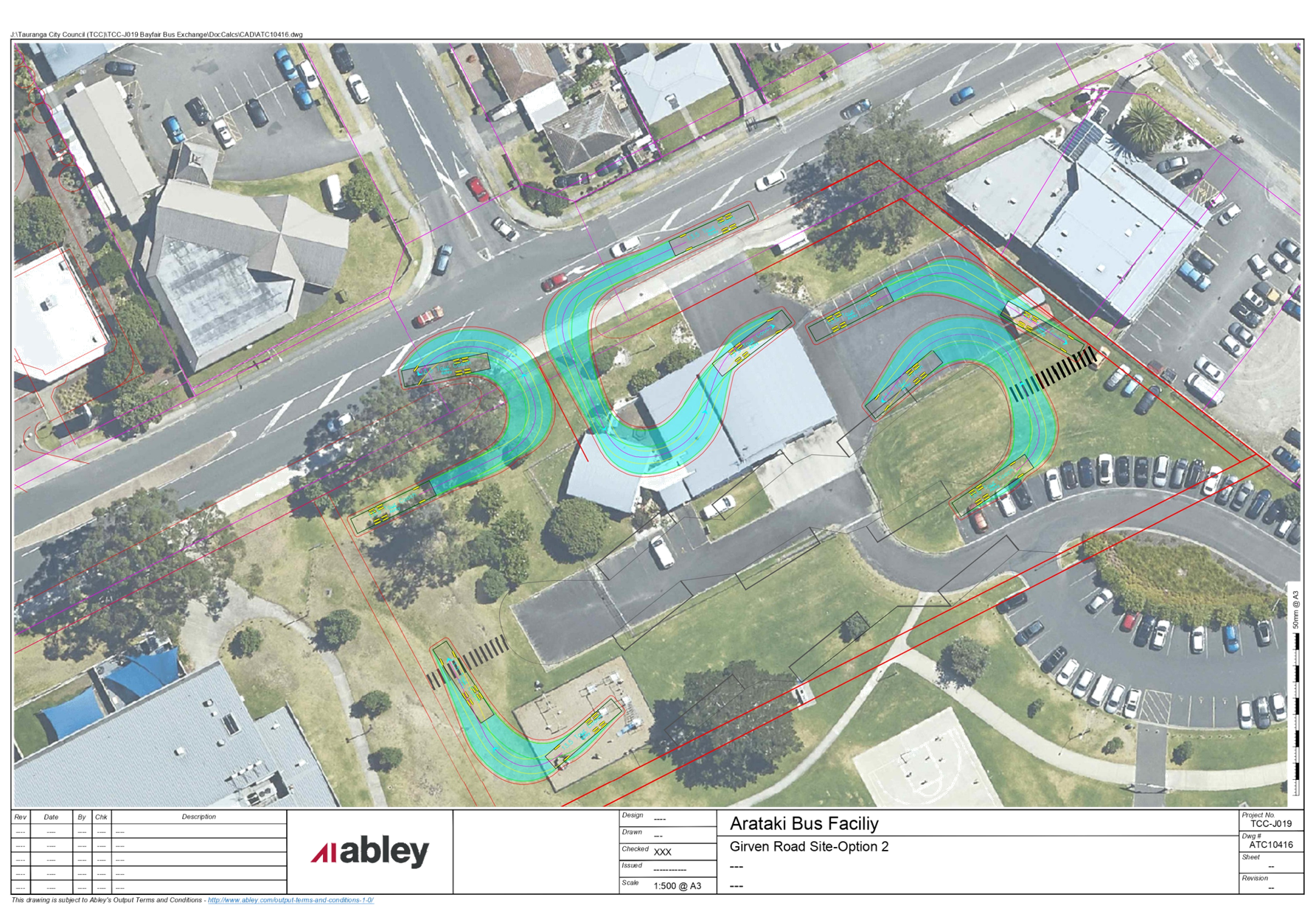
|
Ordinary Council
Meeting Agenda
|
21 June 2021
|
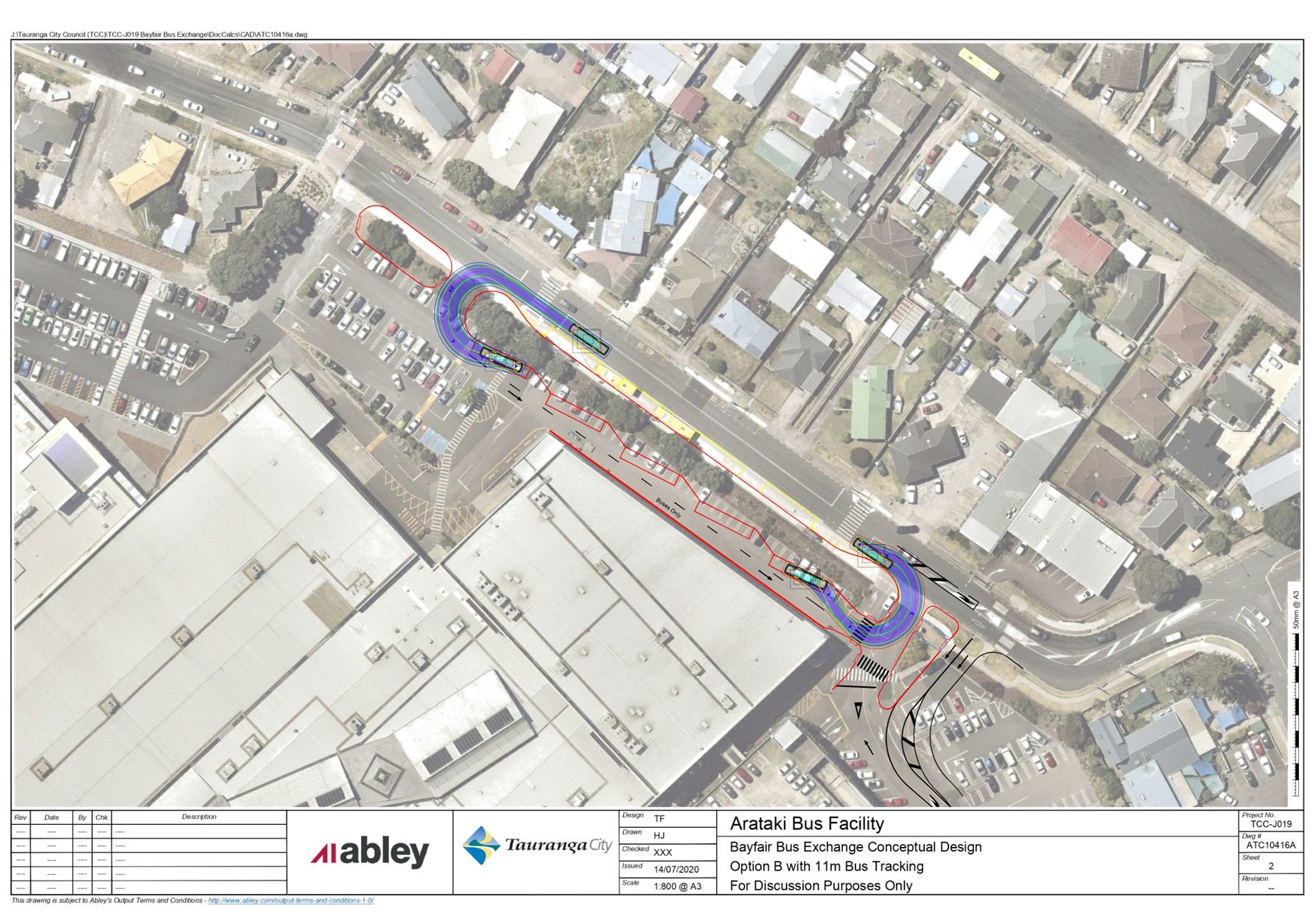
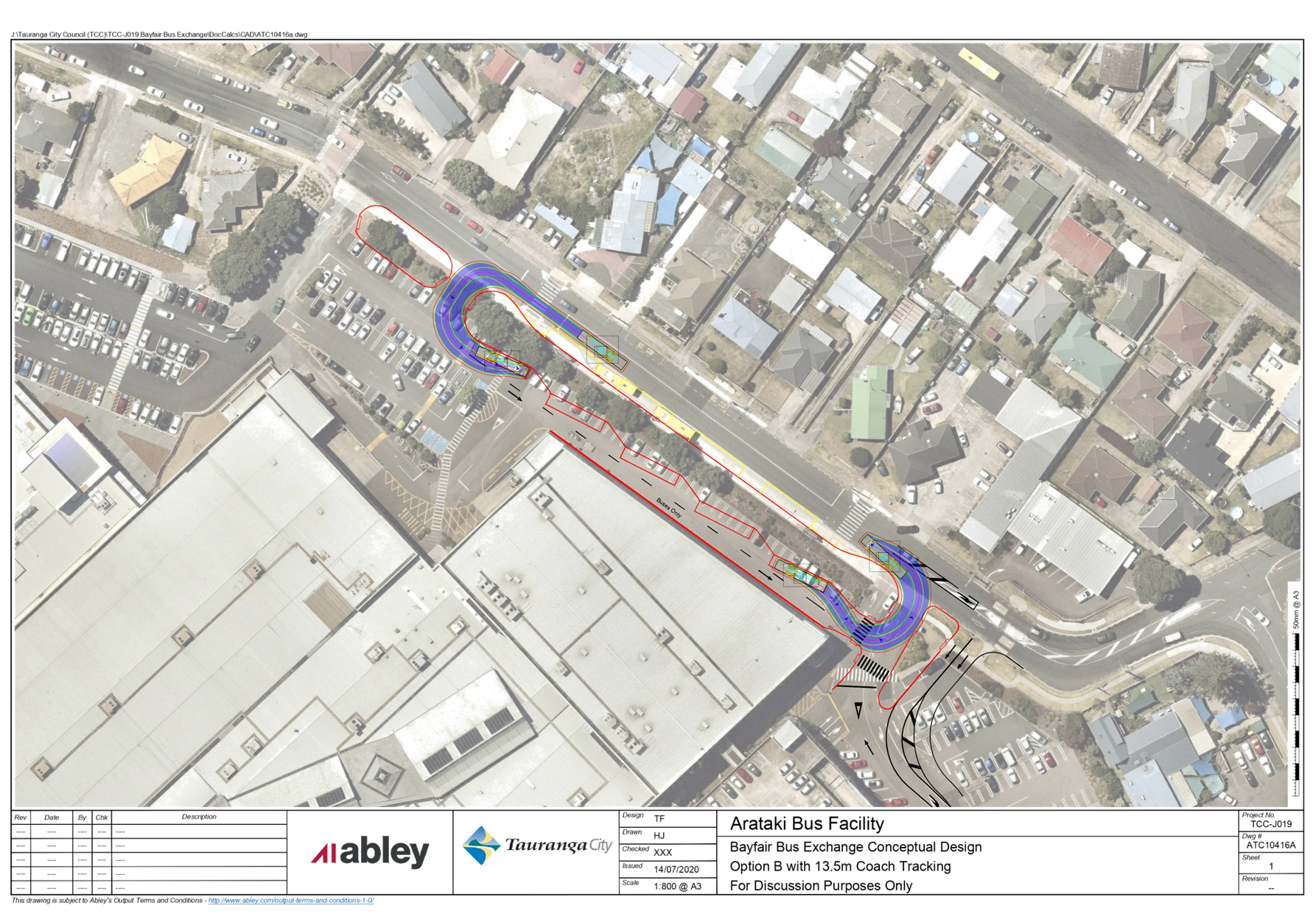
11.5 Draft
submission to Transport Emissions: Pathways to Net Zero by 2050
File
Number: A12609704
Author: Alistair
Talbot, Team Leader: Transport Strategy & Planning
Gregory Bassam, Principal
Transport Planner
Jeremy Boase, Manager:
Strategy and Corporate Planning
Authoriser: Christine
Jones, General Manager: Strategy & Growth
Purpose of the Report
1. To present, for
approval, a draft submission to the Ministry of Transport’s Green Paper
titled ‘Transport Emissions: Pathways to Net Zero by 2050’.
|
Recommendations
That the Council:
(a) Approves the draft
submission to ‘Transport Emissions: Pathways to Net Zero by
2050’, included as Attachment 1 to this report, for
submission to the Ministry of Transport.
(b) Authorises the Chief
Executive to approve any minor typographical or textual amendments identified
as being necessary prior to submission.
|
Background
2. On
6 May 2021 the Ministry of Transport issued a Green Paper titled Hīkina
to Kohupara – Transport Emissions: Pathways to Net Zero by 2050
(“the Green Paper”).
3. A
summary of the Green Paper, created by staff, is included as Attachment 2
to this report.
4. Submissions
on the Green Paper have been invited. The submission period closes on 25
June 2021.
5. The
Green Paper covers, by chapters:
(1) Introduction
(including principles)
(2) Transport
emissions – our current state and pathway
(3) The
Government’s role and levers for reducing transport emissions
(4) The
role of innovation in the transport system
(5) The
Avoid, Shift, Improve framework
(6) Theme
1 – Changing the way we travel
(7) Theme
2 – Improving our passenger vehicles
(8) Theme
3 – Supporting a more efficient freight system
(9) Supporting
a Just Transition
(10) Four
potential pathways – What it could take to meet a zero carbon by 2050
target for transport?
(11) What
opportunities should the Government progress over the first three emissions
budget periods?
(12) Where
to next?
6. Within
most chapters there are specific prompt questions where the Ministry of
Transport is looking for feedback.
7. Council’s
draft submission has focused on the early stages of the Green Paper up to and
including Chapter 6. This is because these are the issues that are most
directly relevant to council and its role.
8. Staff
have not provided advice on the appropriate ‘pathway’ under Chapter
10. This reflects the fact that council has yet to be given an
opportunity to provide direction on its own approach to meeting carbon zero by
2050 targets. This opportunity will arise through the development of a
climate change plan as part of the proposed revised strategic framework
project, details of which will be presented to the Strategy, Finance and Risk
Committee on 28 June.
Strategic / Statutory Context
9. The
Climate Change Response Act 2002
(“the Act”) sets a target of net accounting emissions of greenhouse
gases in a calendar year to be zero by 2050.
10. The
Act also requires the Government to prepare an emissions budget and an
emissions reduction plan by 31 December 2021.
11. On
2 December 2020, the New Zealand Government declared a climate emergency and
committed to taking urgent action to reduce emissions.
12. In
Tauranga, a report titled Community Carbon Footprint
shows that 61% of the city’s emissions relate to transportation, 97% of
which relate to road transport.
Options Analysis
13. Council
has four broad options in regard to the draft submission:
(a) Approve the submission as
drafted and submit to the Ministry of Transport
(b) Amend the submission and
submit to the Ministry of Transport
(c) Reject the submission in toto
and provide direction on a revised submission
(d) Decide not to make a
submission.
Significance
14. The
Local Government Act 2002 requires an assessment of the significance of
matters, issues, proposals and decisions in this report against Council’s
Significance and Engagement Policy. Council acknowledges that in some
instances a matter, issue, proposal or decision may have a high degree of
importance to individuals, groups, or agencies affected by the report.
15. In
making this assessment, consideration has been given to the likely impact, and
likely consequences for:
(a) the current
and future social, economic, environmental, or cultural well-being of the
district or region
(b) any persons who are likely to be
particularly affected by, or interested in, the matter
(c) the capacity of the local authority to
perform its role, and the financial and other costs of doing so.
16. In
accordance with the considerations above, criteria and thresholds in the
policy, it is considered that the matter of transport emissions is of high
significance. However, the decision on whether or not to submit, and on the
contents of that submission, are of low significance as council is just a
submitter to another agency’s process.
ENGAGEMENT
17. Taking
into consideration the above assessment, that the decision is of low
significance, officers are of the opinion that no further engagement is
required prior to Council making a decision.
Click
here to view the TCC Significance and Engagement Policy
Next Steps
18. If council decides to make a
submission, that submission will be lodged with the Ministry of Transport to meet
the deadline of 25 June 2021.
Attachments
1. TCC submission
to Ministry of Transport re Transport Emissions - June 2021 - A12609673 ⇩ 
2. Summary of MoT
transport emissions plan - May 2021 - A12568040 ⇩ 
|
Ordinary Council
Meeting Agenda
|
21 June 2021
|
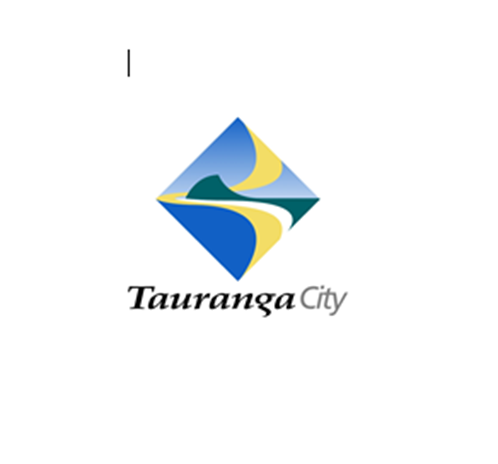
Submission
to
Ministry
of Transport
Te Manatū Waka
Transport
Emissions: Pathways to Net Zero by 2050 – Green Paper
June
2021
Introduction
1. Tauranga
City Council (“TCC”) welcomes the opportunity to submit to the
Transport Emissions: Pathway to Net Zero by 2050 Green Paper (“the Green
Paper”).
2. We are
happy to discuss our submission further with you or provide additional
information and evidence that would be of assistance. Enquires should be
directed to:
Alistair Talbot, Team Leader: Transport
Strategy & Planning
027 457 1017
alistair.talbot@tauranga.govt.nz
Overview
3. In
general, TCC considers the Green Paper to be a comprehensive document that sets
out, at a high level, the complex issues of transport emissions.
4. In
considering the issues raised, the key issue for TCC (and for New Zealand) is
that a one-size-fits-all pathway approach is not appropriate. Any
approach needs to reflect the complexity and diversity of a community, a place,
or a region, and then to target responses that are appropriate in that
context.
5. For
Tauranga, any targeted pathway would clearly need to reflect the fact that the
city is a growth city as recognised by TCC being classed as a ‘tier 1
local authority’ as that term is used in the National Policy Statement on
Urban Development, meaning that it is an area undertaking significant urban
development in the coming years.
6. To
achieve a targeted and contextual response require an evidence-based approach
at the appropriate local level. This will enable robust debate and
testing and will ensure informed trade-off decisions are made on what is and is
not the right set of interventions and their priorities.
7. We
welcome ongoing dialogue with the Ministry and other government partners to
establish the appropriate mix of targets and interventions for Tauranga and the
wider western Bay of Plenty sub-region.
8. In our
response to the Green Paper we have focussed our attention on the matters most
relevant to Tauranga and other growth councils.
Consultation
question 1: principles
9. TCC
broadly agrees with the Commission’s proposed principles.
10. TCC believes there
is an opportunity for a further principle related to evidence-based
decision-making. Currently evidence-based decision-making is referenced
within Principle 6 as follows:
‘We base our advice on evidence as
much as possible. However, we also need to recognise that we will never
have all the evidence we need about the future, and that future modelling is
often based on experience.’ (page 11)
11. While the above is
true, in an area of policy making that is likely to be contentious in coming
years, a principle that actively and strongly supports evidence-based
decision-making is critical. We do not believe the above words fulfil this
requirement.
12. With regard to ‘Principle
2: We need to focus on moving to a zero carbon transport system, rather than
offsetting emissions’ (page 10), TCC submits that this might be
unachievable by 2050 in some circumstances. This is an example of the
need to find responses that reflect complex local scenarios, as identified in
the Overview section above.
13. Emissions modelling
prepared for the Western Bay of Plenty Transport System Plan[5] suggests that moving to a zero
carbon transport system is unachievable in a 2050 timescale. Because of
this, a plan for offsetting transport emissions will also need to be
developed. Below is a graph from the Western Bay of Plenty Transport System
Plan emissions report showing 2048 projections.
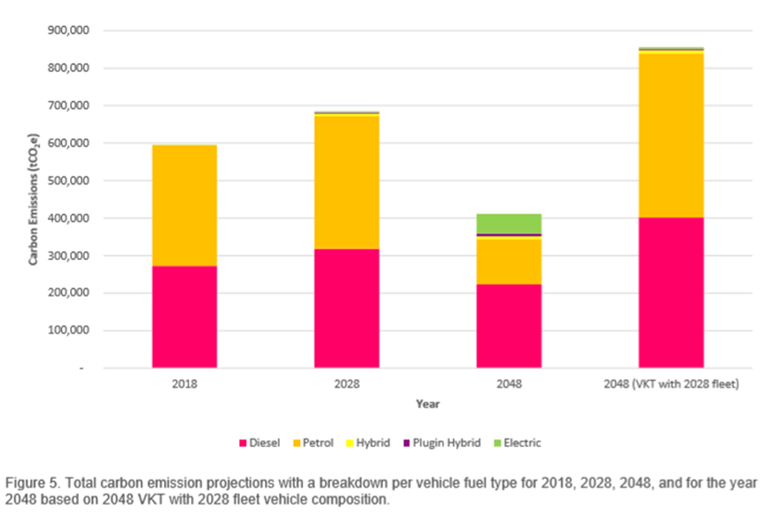
Consultation
question 2: Government’s role and levers available
14. TCC is supportive of
the levers identified to reduce transport emissions but notes that they are
generic levers that could arguably be applied to any public policy
decision-making process. What will be important to all stakeholders is to
understand the relative weight that government applies to each of these levers.
15. TCC strongly
supports the following statements in the Green Paper:
‘Achieving emissions reduction
targets will require a combined effort from all New Zealanders including
central and local government, iwi, communities and businesses.’ (page 20)
‘Stronger collaboration between
central and local government will be important to ensure there is a joined up
systems approach to mitigating transport emissions. This should include
clear signals from Government regarding how Aotearoa will be stepping towards
the net zero goal.’ (page 22)
16. Understanding the
approach that central government intends to take towards collaborating with
local government will have a strong influence on the ability of local
government to contribute to the nation-wide approach to emissions reduction.
17. TCC also strongly
supports the following ‘key point’ in the Green Paper:
‘Central government has a
particularly important role to play, given its influence in the transport
system. Leadership will be required for the significant changes necessary
to shift our transport system onto a zero emissions pathway.’
18. In particular, for a
growth city where more people and more journeys are inevitable, leadership on
national issues such as the decarbonisation of the vehicle fleets will be
critical to our success.
Consultation question 3: Government support for innovation
19. TCC supports central
government’s role in promoting and supporting innovation that will lead
to reduced transport emissions.
20. TCC recommends
further central government support for community-led initiatives and trials,
not just trials led by local government or the private sector. Supporting
community-led innovative initiatives that can be scaled up or down depending on
local circumstances is likely to deliver good, sustainable outcomes.
21. Government could
support such initiatives through, for instance, subsidies, education drives, or
by identifying and removing regulatory barriers.
Consultation
question 4: Integration of transport, land use and urban development
22. TCC acknowledges
that the list of possible key actions in the Green Paper is comprehensive and
reflects what is already considered to be good practice. Many of these
actions are embedded in strategic growth management approaches such as
SmartGrowth here in the western Bay of Plenty sub-region.
23. The key issue for
many stakeholders, including TCC, is the provision of consistent government
direction in respect to transport and transport funding. The current
approach utilising short-term, three-year government policy statements does not
provide this certainty.
24. Development of a
long-term infrastructure strategy with cross-party political support will help
enable true progress on land use and infrastructure projects which sometimes
have lead-times stretching into decades.
25. Similarly, there is
a strong need for government policy making across a number of areas to be
aligned in order to meet shared objectives. Tauranga has experience of
multiple instances of key government policy direction in the area of transport,
land use and urban development that are at best unaligned and at worse
contradictory. Examples include, but re not limited to, carbon zero targets,
the National Policy Statement – Urban Development, the National Policy
Statement – Freshwater Management, and the Government Policy Statement on
Land Transport.
26. With regard to
possible key actions under the heading ‘Placemaking and inclusive
street design’ (page 44) consideration should be given to initiatives
that allow local authorities greater ability to progress emission-reducing
projects at pace. This may include reducing consultation requirements,
reducing the lengthy business case process to secure funding, or by the removal
or amendment of other regulatory requirements.
27. TCC also supports
the concept of setting higher Funding Assistance Rates where there is agreement
that the primary objective (or one of the primary objectives) of the project is
to reduce emissions.
Consultation
question 5: Other travel options
28. TCC considers that
the travel options noted in the possible key actions section of the Green Paper
(pages 54-56) are appropriate.
29. The key issue in
implementing these options will be funding, including funding to support the
initiatives where there is community uncertainty, particularly as it affects
the community’s own willingness to fund the change.
30. The need for
evidence-based decision-making noted earlier in this submission is also
relevant here as it will support the type of trade-off discussions across
different outcomes that communities will need to undertake. At a local
level it is recognised that while emissions reduction is important, so too are
a number of other environmental outcomes that support and enhance
liveability. Evidence-based discussions across these outcomes will
ultimately enable better decision-making.
Consultation
question 6: Role of pricing in demand management
31. TCC supports further
investigation into the issue of pricing. Economic levers have a track
record of success in influencing behaviours and achieving outcomes and may be
used to achieve broader urban form and transport system outcomes beyond just
emissions reductions.
32. As noted in the
Green Paper (pages 62-63), there are a number of different pricing mechanisms;
it is important that in each scenario the right mechanism is used to generate
the desired outcome.
33. It should be noted
that from a public policy perspective, it is easier to implement a new pricing
regime if the proceeds from the pricing are hypothecated to develop appropriate
solutions. This approach would be similar to, for example, the Auckland
regional fuel tax and London’s congestion charge.
34. TCC also notes that
pricing ‘solutions’ should not be implemented alone. They
should only be implemented once it is understood how they will complement other
interventions in a broader package that supports the overall achievement of
outcomes. Implemented alone, the risk of pricing initiatives creating
unintended consequences is significant.
Please do not hesitate to contact us if you would like to
discuss the matters raised in this submission further.
|
Ordinary Council Meeting Agenda
|
21 June 2021
|
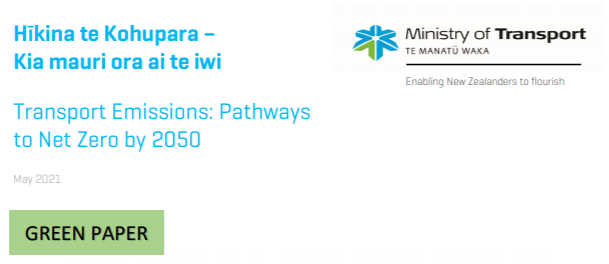
Summary pulled
from the 158-page document that can be found at: https://www.transport.govt.nz//assets/Uploads/Discussion/Transport-EmissionsHikinateKohuparaDiscussionDoc.pdf
Hīkina te
Kohupara identifies opportunities to reduce emissions across three themes,
based on the ‘Avoid, Shift, Improve’ framework.
Theme 1
– Changing the way we travel:
We need to
shape our towns and cities to make it easier, safer, and more attractive for
people to access work, schools, shops, and other opportunities by public
transport, walking, and cycling. This will reduce dependence on private
motorised vehicles, and avoid/reduce emissions. Transport needs to be
integrated with land-use planning to encourage quality compact mixed-use urban
development, while providing better transport options. Transport pricing, and
other demand management tools, could also play an important role.
Theme 2
– Improving our passenger vehicles:
67 percent of
Aotearoa’s transport emissions currently come from light vehicles
(including cars, small vans, and SUVs). Decarbonising the light vehicle fleet
is crucial. We need to increase the supply of clean vehicles, increase demand
for them, and provide supporting infrastructure. Biofuels could also play an
important role in reducing emissions from the current fleet (and other modes).
Public transport fleets, particularly buses, also need to shift to being
cleaner vehicles. Cleaner aviation technologies are in the early stages of
development, but there are opportunities to reduce emissions by using
sustainable aviation fuel.
Theme 3
– Supporting a more efficient freight system:
23 percent of
Aotearoa’s transport emissions currently come from heavy vehicles (mostly
trucks). While light vehicles currently produce the most emissions, trucks will
produce the most emissions by 2055 without further interventions. Emissions
could be reduced by improving the efficiency of supply chains, shifting freight
to low emission modes, and improving the fuel efficiency, and carbon intensity
of freight modes and fuel. Trucks will need to be decarbonised through the
uptake of alternative fuels such as biofuels, electrification, and/or green
hydrogen.
Chapter
1 - Introduction
Purpose
of Hīkina te Kohupara
• This discussion paper identifies what
Aotearoa could do to shift our transport system on to a zero emissions pathway
and seeks feedback on options to achieve this.
• While Government will play a leading
role in making the shift, it needs to work closely with iwi, communities,
businesses, and councils to reduce transport emissions
• Hīkina te Kohupara has dual
purposes – to inform the Government’s first Emissions Reduction
Plan and support a 10-15 year transport emissions action plan
• The Government must prepare an
Emissions Reduction Plan under the CCRA
• The Climate Change Commission has
issued draft advice on its first three emissions budgets
• Our transport system needs to shift to
a low carbon pathway very rapidly to meet our targets
• The transition towards zero emissions
will deliver many social, economic, and environmental benefits
• We need to make a Just Transition
• Te Tiriti o Waitangi will underpin
policy development to reduce emissions
Principles
used in Hīkina te Kohupara that shaped our advice
• Principle 1. The transport sector will
play a lead role in meeting our 2050 net zero carbon target
• Principle 2. We need to focus on
moving to a zero carbon transport system, rather than offsetting emissions
• Principle 3. We need to take a
strategic approach to reducing transport emissions
• Principle 4. Co-ordinated action is
required across the transport system to avoid and reduce emissions
• Principle 5. To ensure a Just
Transition we need to manage the impacts and maximise the opportunities brought
about by changes to the transport system
• Principle 6. We need to forge a path
to zero transport emissions by 2050, while recognising that there is not one
way to get there
• Principle 7. Innovation and
technologies will play an important role in reducing emissions, but people are
the key to our future
Consultation question 1
Do you support the principles in Hīkina te Kohupara? Are there any
other considerations that should be reflected in the principles?
Chapter
2 – Transport emissions – our current state and pathway
Background
– no specific question
Chapter
3: The Government’s role and levers for reducing transport emissions
Key
points
• Achieving emissions reduction targets
will require a combined effort from all New Zealanders including central and
local government, iwi, communities and businesses.
• Central government has a particularly
important role to play, given its influence in the transport system. Leadership
will be required for the significant changes necessary to shift our transport
system onto a zero emissions pathway.
• Government must build and strengthen
its relationships with key stakeholders and partners to ensure success. This
will include collaboration between central and local government, Iwi and
hapū, the private sector, industry associations and advocacy groups.
• Sectors connected with the transport
sector have a significant impact on transport emissions. Collaboration with
these sectors will be important. The interdependencies between key sectors and
transport include the planning system, housing and urban development, the
energy sector, and the tax system.
• Many sectors and individual players,
public and private, will need to align their settings and priorities to reduce
emissions from the transport system.
• Government has a range of levers it
can use to influence emissions reductions in the transport system including
investment, regulation, and economic and education tools.
Levers
within the transport sector that the Government can use to reduce transport
emissions
• Investment
• Regulation
• Economic and educational tools to
influence behaviours
• Analytics and modelling
• Monitoring, evaluation and oversight
• International standards
Consultation question 2
Is the government’s role in reducing transport emissions clear?
Are there other levers the government could use to reduce transport emissions?
Chapter
4: The role of innovation in the transport system
Key
points
• Innovation has always been an inherent
driver of change in the transport system. Innovative ideas, policies, business
models and new technologies can improve the way people and goods move around.
The best innovations add value to the transport system by improving
environmental, social and economic outcomes, which can include reducing
emissions.
• Electrification, shared mobility and
automation are likely to have a significant impact on how people and goods
travel. Electrification and shared mobility will have a significant impact on
emissions but the impact of automation is less certain.
• Exploring different approaches for
reducing emissions in the transport system should include the role of urban
design and placemaking.
• Government has a key role to implement
policies that support transport innovation, including decarbonisation.
Regulatory policies that encourage transport innovation with positive outcomes,
building strong connections between government and nongovernment players in the
innovation sector, leveraging the skills and expertise of the private sector
and targeted investment can help direct innovation towards new products or
services that can contribute to reducing emissions.
Consultation question 3
What more should Government do to encourage and support transport
innovation that supports emissions reductions?
Chapter
5: The Avoid, Shift, Improve Framework
Key
points
• Hīkina te Kohupara uses the
Avoid-Shift-Improve (ASI) framework to identify opportunities to reduce
emissions across the transport system.
• Transport emissions are driven by
transport activity (number of trips and kilometres travelled), mode share
(percentage share of different modes), energy intensity (quantity of fuel used
per kilometre) and carbon intensity (emissions from quantity of fuel per
kilometre).
• The ASI framework addresses each of
these four elements:
o Avoid – improve the overall
efficiency of the transport system through interventions to reduce the need to
travel and trip lengths.
o Shift – improve the efficiency
of trips by promoting mode shift to low carbon modes, such as walking, cycling,
public transport, coastal shipping and rail freight.
o Improve – lower the emissions of
transport vehicles and fuels.
• The Ministry has developed three
themes to group together opportunities within this framework and highlight
interdependencies within different parts of the system. Theme 1 and 2 focus on
people and Theme 3 on freight.
Background
– no specific question
Chapter
6: Theme 1 – Changing the way we travel
Key
points
• Shaping our cities and towns is key to
improving the overall efficiency of the transport system. We need to integrate
land-use, urban development and transport planning to reduce emissions,
especially over the medium to long term.
• To encourage mode shift to low
emissions transport modes such as walking, cycling, and public transport, we
need appropriate urban form. Quality compact, mixed-use urban development can
reduce trip distances, reduce car dependence and encourage the uptake of
walking, cycling and public transport.
• From an emissions reduction
perspective, the need to orient urban development towards compact urban form is
most pressing in our largest and fastest-growing cities where emissions are
highest. This includes Auckland, Hamilton, Tauranga, Wellington, and
Christchurch. However, we also need to encourage compact urban form, and
multi-modal transport options in smaller cities and towns to avoid car use,
especially as these places grow over time.
• Transport infrastructure investments
have a major impact on urban form, and how people travel. For example,
investments to expand urban state highways and roads encourage urban
dispersal/sprawl and car use. In contrast, investments in frequent public
transport services and rapid transit could support more compact urban form. To
reduce and avoid transport emissions, central and local government have to
reconsider planned investments in major urban highway and road expansion
projects if they would induce more vehicle travel.
• We can influence how people travel by
providing better travel options that are energy efficient and generate low or
no emissions. This includes providing quality public transport services, safe
and accessible walking and cycling networks, and shared mobility options such
as car sharing and shared micromobility.
• We can design and manage our streets
to be more inclusive of different people and to encourage travel by active
modes and public transport. This includes applying multi-modal street layouts,
lower speed limits, tactical street changes, and universal design principles.
We can also discourage single-occupant vehicle trips through measures such as
traffic calming and parking management.
• Street changes to support public
transport and active travel could potentially be made swiftly, as it is
possible to reallocate space on existing streets to deliver mode shift without
building major new infrastructure. Regulatory and funding settings need to
support rapid street changes.
• Placemaking is critical for supporting
higher density urban developments, to create places that people want to live
and work in, and that are good for people’s wellbeing.
• Transport demand management, including
transport pricing, is critical for supporting more liveable cities and
encouraging people to make sustainable transport choices.
Shaping
our towns and cities: possible key actions
The
responsibility for reducing transport emissions does not rest with transport
decisionmakers alone, as many of the following possible actions require a
coordinated approach by different agencies involved in land use, urban
development and transport policy.
Quality
compact, mixed use urban development:
• Through the proposed Strategic
Planning Act (part of the RMA reforms), require spatial plans to be developed
and implemented to better integrate land use, urban development and transport
planning to achieve quality compact, mixed use urban development. Both central
government and local government need to work together to improve capabilities
for spatial planning. (Underway through RMA reforms)
• Integrate land use and transport
planning and investment as part of the RMA reforms.
• Make transport investments conditional
on having clear links to land use and urban development plans that support
quality compact, mixed use urban development. This will affect the types of
projects that are included in Regional Land Transport Plans.
• Require transport GHG emission impact
assessments for proposed urban developments (including the transport GHG
emissions of residents and business owners that would be located in the
development). Developments that would result in high emission generation could
potentially be required to undergo redesign and/or an acceptable form of
durable mitigation.
• Develop clear guidance and
expectations to link urban density and mixed land use with accessibility
(particularly by way of public transport, walking, and cycling).
• Enable Waka Kotahi, Local Government,
KiwiRail and Kāinga Ora to take more active roles in developing sites
around frequent public transport stations.
Placemaking
and inclusive street design:
• Remove barriers and improve funding
for tactical urbanism and innovative approaches to street design (e.g. expand
on Waka Kotahi’s Innovating Streets for People Programme).
• Develop design guidance and
expectations for quality high-density environments (including streets, public
spaces, buildings, and green space).
• Invest in placemaking and urban design
capability and capacity of transport agencies and transport functions within
local government.
• Clarify the principles of living
infrastructure, and set expectations that living infrastructure is incorporated
into transport plans and projects.
• Review standards and guidance for
street design, and develop nationally applicable consistent sets of standards
for Aotearoa.
• Prioritise the need to reallocate
street space and to create connected networks for delivering transport mode
shifts in the next GPS on land transport, and/or for any additional funding for
active modes and public transport.
• Set higher Funding Assistance Rates
for walking and cycling investments and dedicated/priority bus lanes to
strongly incentivise Road Controlling Authorities to prioritise and accelerate
street changes.
• Investigate if regulatory changes are
needed to empower Road Controlling Authorities to more easily consult on and
make street changes to support active travel, public transport, and
placemaking.
• Set targets for councils to deliver
public transport and active travel networks that require street changes (e.g.
dedicated/priority bus lanes on some routes; connected cycling networks) by a
specific date. There could be funding consequences if Road Controlling
Authorities do not deliver these changes within these timeframes.
• Make changes to policy and funding
settings to ensure Waka Kotahi and Road Controlling Authorities maximise
opportunities to ‘build back better’ when doing street renewals (to
improve streets for people walk, cycling, and using public transport).
(Ministry of
Transport and Waka Kotahi have some projects underway that support placemaking
and street design e.g. Aotearoa Urban Street Guide, the One Network Framework,
and Reshaping Streets scoping project)
Consultation question 4
Do you think we have listed the most important actions the government
could take to better integrate transport, land use and urban development to
reduce transport emissions? Which of these possible actions do you think should
be prioritised?
Providing
better travel options: possible key actions
For all of
these possible actions, we need to consider where they are appropriate. Some of
them should be targeted at our major urban growth areas where they are most
viable, and where they can make the biggest impact on reducing emissions.
Public transport could be improved in all of our cities, and is most needed in
our largest and fastest growing cities where most people live. Walking and
cycling improvements could be made in towns and cities throughout Aotearoa.
Shared mobility schemes could be provided in a range of settings, depending on
population levels and urban density.
Note: this
section should be read in combination with the possible key actions from
Shaping our towns and cities (above), which includes options to accelerate
street changes to support public transport and active travel.
Public
transport:
• Further invest in public transport
infrastructure to increase the capacity, frequency, quality, and reliability of
services. (Some investment currently occurring through GPS on land transport,
NZ Upgrade programme, and local Government)
• Increase incentives to use existing
public transport (such as reduced fares or service improvements). (Councils
already provide some incentives to specific users e.g. students, children. The
Government’s SuperGold card provides free travel to over 65s off-peak)
• Invest in improving public transport
operations (e.g. bus priority measures, and more efficient payment options
etc.).
• Invest in additional public transport
services (e.g. increasing service frequencies, extending existing services,
adding new routes).
• Invest in better passenger amenities
(e.g. better shelters/terminals, improved access and facilities at stops, and
better connections with walking and cycling).
• Clarify the roles of agencies to
deliver large frequent public transport systems in Aotearoa, and ensure that
there are legislative settings in place to enable them (e.g. land acquisition
and consenting).
• Review the Public Transport Operating
Model to ensure that it remains fit for purpose and contributes to the
Government’s transport priorities. (Underway)
Walking
and cycling:
• Invest in high quality cycling
infrastructure (connected urban cycling networks, as well as secure bike
parking and storage at key journey points). (Some investment currently
occurring through GPS on land transport, NZ Upgrade Programme, and by local
Government)
• Invest in better walking
infrastructure, include including improvements to footpaths and intersections,
and reducing severance between places that are difficult to access by walking.
(As above)
• Invest in and support walking and
cycling for utility journeys, including to/from school and work (develop clear
travel planning guidance including expectations around secure bike parking
facilities).
• Invest in and support public education
campaigns to promote walking and cycling (including supporting cycle skills
training).
• Develop clear and nationally
consistent guidance for wayfinding for walking and cycling.
• Require greater network planning for
walking and cycling to support network connectivity.
• Investigate whether there are
regulatory barriers, or historic design practices that pose barriers, in
relation to walking and cycling (following on from the Accessible Streets work
currently underway).
• Investigate legislation that defines
and regulates the use of E-bikes to remove potential barriers.
• Support road controlling authorities
to develop integrated plans for schools and education sites that enable
students to walk and cycle to school (including for example, speed reduction,
travel planning, infrastructure delivery, training for pupils and parents,
etc.).
Shared
mobility:
• Provide dedicated on/off street
parking for shared mobility in convenient, highly visible locations and
encourage shared mobility parks to be incorporated in new and existing
facilities (e.g. through national car parking guidance). (Some Councils already
provide dedicated parking for car sharing)
• Provide car share companies with
grants, loans or other incentives or subsidies (e.g. providing on street
parking at low or no cost to help reduce car sharing operator costs and rates
for users). (Some car share companies have received funding through the Low
Emission Vehicle Contestable Fund)
• Increase incentives to use shared
mobility (e.g. reduced rates).
• Develop procurement guidelines and
expectations for the All of Government vehicle fleet (e.g. to encourage greater
use of car share by Government in place of having a fleet or permit the fleet
to be used by car share businesses at night and on weekends to reduce costs).
• Enable and support shared
micromobility hire schemes, including investing in appropriate infrastructure,
parking, and local government capability to support the safe and effective
operation of shared micromobility).
• Partner with employers and carpooling
providers to support local carpooling efforts (e.g. providing tools to make it
easier for employees to match with others for carpooling).
• Define a national vision/strategy for
MaaS in Aotearoa and invest in pilots.
• Regulate for data access/data sharing
between public and private transport providers.
Consultation question 5
Are there other travel options that should be considered to encourage
people to use alternative modes of transport? If so, what?
Transport
pricing and management: possible key actions
Transport
pricing:
• Consider congestion pricing. (Already
being investigated for Auckland through Congestion Question project)
• Investigate distance pricing as a
means to encourage mode-shift, dis-incentivise discretionary travel, and
address the rebound effects caused by public transport investment.
• Consider incentives (subsidies or
rewards) that could encourage alternative modes of travel. Low emission zones:
• Enable and implement low emission
zones to reduce CO2 (based on GHG emissions).
Parking
management:
• Require councils to continue to
develop and implement parking pricing strategies.
• Introduce maximum parking
standards/requirements in some areas, e.g. for new high-rise buildings and
shopping centres.
• Enable and implement workplace/private
property/commuter parking levies.
• Implement car parking regulations in
the land use planning system as per the NPS-UD. (Underway)
Carbon
charges:
• Increase rates of fuel excise duty
after 2023.
• Implement an increased transport fuels
only carbon tax. (Already small charge through the Emissions Trading Scheme)
Consultation question 6
Pricing is sometimes viewed as being controversial. However,
international literature and experiences demonstrate it can play a role in
changing behaviour. Do you have any views on the role demand management, and
more specifically pricing, could play to help Aotearoa reach net zero by 2050?
Chapter
7: Theme 2 – Improving our passenger vehicles
Key
points:
• Passenger vehicles include light
vehicles (e.g. cars, vans, SUVs), public transport, planes, and associated
infrastructure
• Decarbonising the light vehicle fleet
is critical for meeting our emission reduction targets. We need to increase our
supply of clean cars and increase demand for them, as well as provide
supporting infrastructure.
• Given the slow turnover of vehicle
fleets, we need to consider options to decarbonise the existing fleet. This
includes removing fossil-fuelled vehicles from the fleet and transitioning to
biofuels.
• As we encourage mode-shift to public
transport, we also want to ensure our public transport modes are low emission,
including transitioning our bus fleet to cleaner fuels and electrifying more of
the passenger rail network.
• Cleaner aviation technologies are in
the early stage of development but there are still opportunities to reduce
emissions, including with sustainable aviation fuel.
Decarbonising
the light vehicle fleet: possible key actions
Increasing
the supply of clean cars:
• Introduce and implement the fuel
efficiency standard agreed by Government. (Agreed by Cabinet and underway)
• Consider the potential for a rolling
age limit for used vehicles.
• Investigate how a maximum CO2 limit
would improve the fleet.
• Consider a schedule for phasing out
the importation of fossil fuelled vehicles.
• Investigate how Aotearoa could mandate
a market share of zero emission vehicles.
Encouraging
the demand for clean and safe cars:
• Investigate and implement a vehicle
feebate/subsidy. (Government is considering options for an incentive scheme)
• Investigate introducing a Government
subsidy to support the uptake of cleaner cars. (As above)
• Further investigate potential tax
incentives (including Fringe Benefit Tax, Depreciation and Tax Grants and RUC).
• Further investigate infrastructure
funding. (Some infrastructure has already been funded through the Low Emission
Vehicle Contestable Fund, and the Ministry of Transport is doing a strategy to
consider future infrastructure needs)
• Pursue the standardisation of charging
infrastructure.
• Consider how parking and priority use
on roads for low emission vehicles can encourage uptake, or reduce the use of
ICEs.
• Encourage acceleration of Government
procurement of low emission light vehicles, including encouraging the
procurement of safe low/zero emitting vehicles. (Underway through Carbon
Neutral Government Programme)
Decarbonise
the existing fleet:
• Investigate the use of a vehicle
scrappage scheme to encourage the removal of inefficient, unsafe vehicles.
• Consider basing vehicle licensing on
emissions.
Consultation question 7
Improving our fleet and moving towards electric vehicles and the use of
sustainable alternative fuels will be important for our transition. Are there
other possible actions that could help Aotearoa transition its light and heavy
fleets more quickly, and which actions should be prioritised?
Decarbonising
the public transport fleet: possible key actions
• Implement the mandate for local
government to procure only electric buses by 2025. (Underway)
• Provide support for the
decarbonisation of the bus fleet and its required infrastructure.
• Extend the RUC exemption for electric
buses (which is due to expire in 2025). (Under consideration)
• Consider how to fund foregone revenue
for the National Land Transport Fund if road user charges exemptions are
extended for heavy electric vehicles or expanded to include hydrogen or other
low carbon fuels.
• Examine if the Public Transport
Operating Model can be adjusted to enable accelerated decarbonisation of the
public transport bus fleet. (Underway)
• Consider the further electrification
of existing parts of the passenger rail network.
• Consider future investment needs to
ensure existing rail networks are fit for purpose.
Consultation question 8
Do you support these possible actions to decarbonise the public
transport fleet? Do you think we should consider any other actions?
Decarbonising
the aviation fleet: possible key actions
• Invest in, produce and mandate
sustainable alternative fuels that can also be used by the aviation sector.
(This has commenced with work on a biofuels mandate)
• As technology advances, consider its
implementation for Aotearoa, e.g. wider use of electric planes.
• Support research, development and
production of sustainable aviation fuel.
• Examine if the current air navigation
system is effective or could be more efficient. (Partially underway through New
Southern Skies and Performance Based Navigation)
• Implement operational improvements
such as better air traffic flow management and improved navigation to reduce
fuel burn. (As above)
Consultation question 9
Do you support the possible actions to reduce domestic aviation
emissions? Do you think there are other actions we should consider?
Chapter
8: Theme 3 – Supporting a more efficient freight system
Key
points:
• The Ministry is starting work on a
National Supply Chain Strategy that will provide strategic direction and set
out priorities amongst the various objectives for the supply chain, one of
which being the reduction of emissions.
• Given the market-led nature of the
supply chain system, initiatives to reduce emissions would have to be carried
out in close consultation with the freight industry and/or be private
sector-led, with government providing a vision and direction for change and/or
supporting infrastructure. Concerted effort by industry has the potential to
drive rapid emissions efficiency gains, with the right incentives.
• Shifting some of the freight task to
less carbon intensive modes will help reduce emissions, including to rail and
coastal shipping. The Government already has work underway to support
improvements in rail and coastal shipping.
• Decarbonising freight vehicles will be
critical for reducing transport emissions. This could include increasing the
uptake of alternative green fuels, such as biofuels, electrification and/or
green hydrogen. There is a high degree of uncertainty around the timeframe in
which zero emission freight vehicles will be commercially available, more rapid
than expected technological progress could accelerate decarbonisation of this
sub-sector.
• Our international obligations will
help to drive emission reductions in shipping, including through encouraging
cleaner, more efficient ships and ports. The Government is also investing to
improve our rail network, including through renewing locomotives and the
inter-island ferries which will support reductions in the emissions from rail.
• Aviation plays a role in our freight
system through its movement of people and freight domestically and internationally
and efforts to decarbonise it must be considered given our trade and social
connection needs and Pacific responsibilities.
• Improving the efficiency of our supply
chain considering the role that all modes play could also help to avoid and
reduce emissions. There are a range of possible initiatives trialled overseas
and the feasibility of applying them in Aotearoa could be studied in more
depth. These include optimising freight routes, equipment and vehicles, and
through making better use of data and supporting information sharing and
collaboration.
Improving
the efficiency of our overall freight supply chain: possible key actions
Optimising
freight routes, logistic nodes, equipment and vehicles:
• Undertake an examination of the
efficiency of the spatial organisation of supply chain nodes (e.g. location of
ports and freight hubs).
• Examine the potential to improve the
efficiency of first and last-mile delivery centres (e.g. urban consolidation
centres, drop-off/pick-up consolidation points, use of micro-freight, pilot of
concessions).
• Consider if there is potential to
optimise payloads, e.g. load maximisation and back loading.
• Support the further use of Intelligent
Transport Systems (ITS).
• Analyse if there is opportunity or
restrictions to the further expansion of the weight and length limits of
high-productivity motor vehicles (HPMVs).
• Further promote eco-driving and driver
training programmes. (Promoting work already being implemented by
industry)
Information
sharing and collaboration:
• Examine opportunities for the
collection and better use of data to improve efficiencies in the freight
system.
• Consider encouraging/supporting
voluntary business collaborations to reduce emissions in logistics. (Many of
these actions will be considered through the National Freight Strategy)
Consultation question 10
The freight supply chain is important to our domestic and international
trade. Do you have any views on the feasibility of the possible actions in
Aotearoa and which should be prioritised.
Decarbonising
freight modes: possible key actions
Cleaner
trucks:
• Introduce vehicle CO2 standards.
• Implement EURO 6 to improve air
pollutants from trucks.
• Consider if the current RUC exemption
for heavy electric trucks should be expanded to other low emission fuels used
by heavy trucks. (Under consideration)
• Consider expanding the scope of the
existing low emissions vehicles technology funding to accelerate the uptake of
proven low emissions vehicle technology.
• Investigate the viability of
introducing a penalty or financial disincentives system for high GHG emitting
heavy trucks.
• Investigate the viability of providing
upfront grants or other incentives (such as changing depreciation rates) for
low and zero emissions trucks.
• Investigate and introduce Green
freight procurement through third party contractor rules for government
activities.
• Phase out the registration of diesel
heavy vehicles beyond a certain date, e.g. from 2035 or banning diesel trucks
in certain cities or zones
• Invest in domestic industry to
refurbish diesel trucks with zero emissions options
• Implement a biofuels mandate
Cleaner
rail:
• Investigate the use of biofuels for
rail. (Included in biofuels mandate, which is under development)
• Explore the feasibility of future
electrification of rail (i.e. non-metro rail) or other low emission alternatives.
Cleaner
ships and ports and associated activities:
• Introduce targets, rewards, incentives
for energy efficient ships using Aotearoa ports.
• Apply MARPOL Annex VI energy
efficiency requirements to the Aotearoa domestic fleet. (Aotearoa is acceding
to MARPOL Annex VI)
• Introduce a target /mandate for
renewable fuel (biofuels, hydrogen, ammonia) for ships that applies to the
domestic fleet. (underway)
• Consider introducing a mandatory speed
limit (i.e. impose slow steaming) for ships transiting around Aotearoa.
• Electrify Aotearoa’s fleet
(ferries, tugs, cement carriers and fuel tankers). (Some private electric
ferries already built/procured)
• Improve the ship/port interface by
implementing Just-in-Time arrival guidance.
• Incentivise or invest in renewable
shore-side power supply for ships.
• Incentivise or invest in renewable
energy for port operations.
• Consideration of a large dry dock in
Aotearoa.
• Invest in future technologies (e.g.
autonomous shipping that provide low carbon alternatives to road freight).
• Introduce decarbonisation as a
criterion in government procurement of ships and shipping services.
Improving
existing infrastructure and vehicles:
• Investigate potential for adoption of
more efficient vehicle design.
• Investigate the impacts of better road
design and maintenance.
Decarbonising
fuels:
• Consider implementing a carbon
intensity standard for all transport fuels.
• Incentivise and/or provide financial
support to expedite the uptake of renewable fuels.
• Investigate and implement renewable
fuel targets.
• Incentivise or invest in
infrastructure for alternative fuels and/or electrification, including ultra fast
charge. (Some Government investment has already taken place e.g. for hydrogen
production)
Consultation question 11
Decarbonising our freight modes and fuels will be essential for our net
zero future. Are there any actions you consider we have not included in the key
actions for freight modes and fuels?
Chapter
9: Supporting a Just Transition
Key
points
• Government has committed to taking a
‘Just Transition’ approach to becoming carbon free – this
means making the transition fair, equitable and inclusive.
• The transition to a low carbon economy
will create significant economic opportunities for businesses, and job creation
in the transport and energy sectors.
• Some parts within the transport sector
may be more affected by the transition than others, especially if they face
rising transport costs, and/or find it difficult to adapt. Government could
assist the sector to adopt new technologies to encourage an earlier transition,
and support education and upskilling.
• Many people will benefit from the
transition to a zero carbon transport system. For example, many New Zealanders
will benefit from better transport options, better health, and lower and more
stable transport costs over time.
• People who already experience
social/economic disadvantages are likely to be disproportionately affected by
any rise in transport costs (as already occurs when fuel prices rise). To make
a Just Transition, Government needs to mitigate the impacts of interventions
that could increase transport disadvantage. There are also opportunities for
the Government to improve transport equity during the transition.
• The speed of change is an important
consideration for a Just Transition. We urgently need to transition to a zero
carbon system, so Government needs to clearly signal changes to give businesses
and consumers time to prepare and make the necessary changes. Government also
needs to work collaboratively with industries to ensure the transport sector
can adapt and overcome challenges associated with the transition.
Consultation question 12
A Just Transition for all of Aotearoa will be important as we
transition to net zero. Are there other impacts that we have not identified?
Chapter
10: Four potential pathways – What could it take to meet a zero carbon by
2050 target for transport?
The pathways
place a different weight on avoid, shift and improve initiatives In all pathways,
electrification of the vehicle fleet is important to achieve as close to zero
carbon as possible by 2050. Where these pathways differ is the relative weight
given to ‘avoid’, ‘shift’ and ‘improve’
initiatives within each theme (see Figure 8).
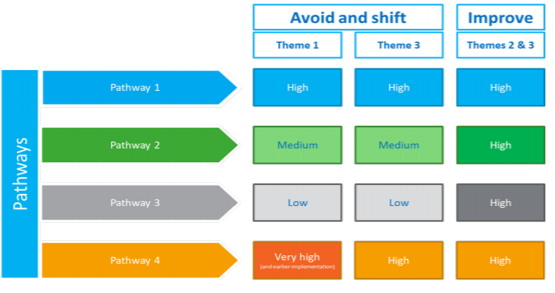
Figure 8.
Relative weight given to avoid, shift, and improve interventions in each
pathway
• Pathway 1 assumes ‘avoid’
and ‘shift’ initiatives (Theme 1) play a significant role in
reducing transport GHG emissions. This pathway requires reducing nearly 30 percent
of the light vehicle kilometres travelled by 2050 through reducing trip
distances and encouraging mode shift to public transport, walking and cycling.
It also requires higher mode-shift from road to rail and coastal shipping.
• Pathway 2 assumes
‘improve’ initiatives (Theme 2) play a significant role in reducing
emissions than Pathway 1. This pathway requires a larger number of electric
vehicles with greater use of biofuels in the short to medium terms. There is
also emphasis on ‘improve’ initiatives for freight.
• Pathway 3 assumes
‘improve’ initiatives (Theme 2) play a more significant role in
reducing emissions than the other pathways. In this pathway, bringing more EVs
into New Zealand transport system compensates for the limited avoid and shift
changes. There is also much more emphasis on ‘improve’ initiatives
in freight.
• Pathway 4 gives even stronger weight
to ‘avoid’ and ‘shift’ initiatives (Theme 1) than all
other pathways. This includes assuming that ‘avoid’ and
‘shift’ interventions happen more swiftly, bringing forward their
impact on emissions and that the clean car policies will be very successful in
accelerating the uptake of electric vehicles. This pathway requires reducing
nearly 40 percent of the light vehicle kilometres travelled by 2035 and over 55
percent by 2050. In the long term, the greater impact of ‘avoid’
and ‘shift’ initiatives reduces the number of vehicles that need to
be electrified.
The pathways
with more emphasis on ‘avoid’ and ‘shift’, such as
Pathway 1 and 4 are more effective at reducing emissions (Figure 9). Avoiding
activities that produce emissions is, on balance, a more effective strategy
than minimising the emissions from those activities.
Policy
implications from the pathways chosen in Hīkina te Kohupara
The pathways
in this chapter clearly illustrate that deep and widespread changes will be
required to reach a zero carbon target for the transport sector by 2050. To
inform thinking on which opportunities the government should pursue, this
section highlights policy implications that became evident while modelling the
different pathways and through research for Hīkina te Kohupara. It
identifies implications for the short-term (up to five years), medium-term
(five to 15 years), and long-term (15 years plus).
(note: the
following are just headings, there is more detail in the document)
Policy
implications from Theme 1 ‘Changing the way we travel’
· Quality compact, mixed use urban
development and placemaking
· Public transport, walking, cycling and
shared mobility
· Transport pricing
Policy implications of Theme 2
‘Improving our passenger vehicles’
· Decarbonising light vehicles
· Decarbonising public transport
· Decarbonising aviation
Policy
implications of Theme 3 ’Supporting a more efficient freight
system’
· Optimising freight routes, equipment
and vehicles
· Shifting road freight to rail and
coastal shipping
· Cleaner trucks
· Cleaner rail
· Cleaner ships
Investment
costs
Decarbonising
our transport system through influencing energy and travel choices and demand
would require substantial and sustained investment but, more importantly, such
investment will need to commence soon.
We can classify
the investment required into four broad categories:
• Growth
enabling – this includes basic infrastructure expansion to manage
population and economic growth and additional investment to change demand.
• Mode
choice provision – this includes investment in sustainable transport
choices to manage demand.
Pricing
systems – this includes parking pricing and a distance based charging
system to replace the current system that is tied to petrol use and other
additional pricing strategies to manage demand during specific times and
locations or by different vehicle types.
• Energy
infrastructure – this includes electricity system and grid upgrade,
additional renewable energy production plants and alternate energy
refilling/charging infrastructure (including biofuel, electricity and
hydrogen).
Consultation question 13
Given the four potential pathways identified in Hīkina te
Kohupara, each of which require many levers and policies to be achieved, which
pathway to you think Aotearoa should follow to reduce transport emissions?
Chapter
11: What opportunities should the Government progress over the first three
emissions budget periods?
Includes some
big tables on pages 126 to 134 setting out the policy interventions over each
of the next three five-year periods. Too big to summarise here.
Please have a look at the document at: https://www.transport.govt.nz//assets/Uploads/Discussion/Transport-EmissionsHikinateKohuparaDiscussionDoc.pdf
Consultation question 14
Do you have any views on the policies that we propose should be
considered for the first emissions budget?
Chapter
12: Where to next?
Hīkina te
Kohupara was produced to help inform the Government’s strategic approach
to reducing GHG emissions from transport. It is the first step towards fully
understanding how the transport sector can reduce its GHG emissions. It will be
used to facilitate discussions with Ministers, Iwi/Māori, stakeholders and
our wider communities on potential policies that we will carry forward in 2021
through to the first ERP under the CCRA.
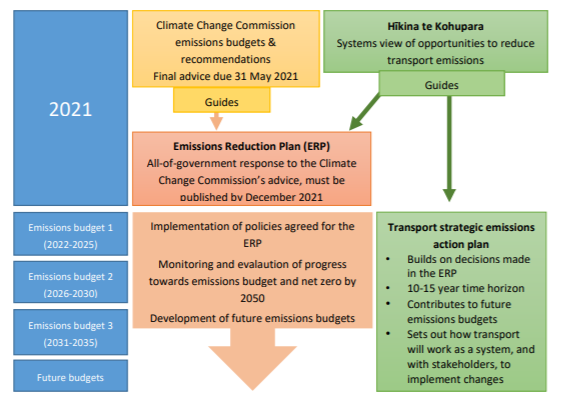
Hīkina
te Kohupara will underpin a 10-15 year strategy and action plan
Hīkina
te Kohupara has highlighted that Aotearoa must implement a broad range of
policies to achieve meaningful change and reductions in our GHG emissions from
the whole transport system. Aotearoa cannot afford to cherry pick policies, nor
are there policies that are silver bullets. In addition to informing the
policies for the first ERP, Hīkina te Kohupara will be the foundation
document from which a 10-15 year time horizon strategy and action plan will be
developed. A strategy and action plan will be agreed with Government and used
to inform future ERPs and future investment and resource needs.
How can
you help?
Thank you for
taking the time to read this paper. The Ministry invites your views on the
opportunities outlined in this paper to reduce transport emissions and put us
on a pathway to zero carbon emissions by 2050. Your views will help us to shape
the advice we put forward to Ministers for the ERP, and for the development of
transport strategic action plan for the next 10 to 15 years.
11.6 Links
Avenue Safe System Review and Recommendations
File
Number: A12570389
Author: Brendan
Bisley, Director of Transport
Authoriser: Nic
Johansson, General Manager: Infrastructure
Purpose of the Report
1. The Commissioners
requested staff undertake a safe system review of Links Avenue following a
deputation from a group of residents. This review was undertaken by Colin
Brodie, Director, Colin Brodie Consulting Ltd and Hamish Mackie, Director,
Mackie Research Ltd.
2. This report
outlines the finding and recommendations of the review. The report also
outlines the next steps that could be undertaken, the local safety benefits and
the implications for the wider community as a result of the recommendations.
|
Recommendations
That the Council:
(a) Receives the safe system
review report on Links Avenue.
(b) Directs staff to undertake
consultation with the wider community on the recommendations of the report.
(c) Sets aside a $400,000 budget
in the LTP to undertake an innovative streets style consultation with the
community regarding trialling the recommended solution.
|
Executive Summary
3. The Council engaged
the services of Colin Brodie and Hamish Mackie to undertake a safe system
review of Links Avenue. A safe system review looks at only the safety aspects
of a street or road. A safe system review does not consider wider network
issues or consequences to the safety and congestion on adjacent streets if
changes were made to the street being reviewed.
4. The review
concluded that due to the mix of traffic and volumes there is a “belief
of a tangible risk to pedestrians and cyclists using the shared use path along
the length of Links Avenue”.
5. The review
indicated there was merit in Council trialling an option of a cul-de-sac on
Links Ave that would prevent the rat running along the street and substantially
reduce traffic volumes past the school to reduce the risk of conflict between
users, allowing the removal of the bus lane between Golf Road and Ascot Avenue,
but still allow buses to travel along the street.
6. The safe system
review team were provided a copy of a staff report presented to Council in
October 2020. Councillors did not make a recommendation at the time for which
option or options should be progressed. The earlier staff report is appended to
this report along with the Safe System Review.
7. The key issue in
Links Avenue is the volume and mix of traffic using the street. Due to the high
volumes, changes have been needed to create separate space for the PT and
walking and cycling modes. This creates little separation for users in the
current configuration.
8. A cul-de-sac is the
recommended option that would reduce the traffic volume back to a level that
vulnerable users can mix with traffic. The other options in the Council report
address specific aspects of the conflict between modes but cannot achieve the
safety improvements that can be achieved with a reduced traffic volume
9. There are other
actions already underway to improve safety in the wider area. These actions
are:
(a) to implement a heavy vehicle
ban in the residential areas of Arataki and the Mount
(b) to install a 30km/h variable
speed zone in Links Avenue near the school
(c) provide an additional
pedestrian crossing on Golf Road to encourage students coming from the west to
access the school via Lodge Avenue rather than Links Avenue.
The last two
actions are still in progress but will be implemented as soon as possible.
10. Links Ave is an important part of
the bus network and in the TSP has been identified as a primary PT and cycle
corridor. The bus had earlier been routed down Maunganui Road, but this is
disconnected from the origin and destination locations that bus passengers use.
In Links Avenue, non-residential traffic using the street is the lowest
priority under the TSP plan.
Background
11. Links Avenue was a relatively quiet
local road (approximately 2,000vpd) prior to the start of the construction
works on the Baylink to Bayfair (B2B) construction.
After the B2B construction got underway, significant congestion on the State
Highway meant buses were shifted off Maunganui Road to improve service
reliability as well as address significant safety concerns with bus passengers
needing to cross the 4-lane highway to get to and from the bus. A student using
the buses had been hit by a vehicle on Maunganui Road prior to the relocation
to Links Avenue so the continued use of Maunganui Road for buses is not
considered a safe option.
12. There are approximately 6,000
passengers that get on the bus in Links Avenue each month, with 2/3 of those
being students.
13. Traffic volumes are now over 5,000
vehicles per day, and still rising, along with the heavy vehicles that were
starting to use the street as a shortcut.
14. Bus services were unable to maintain
travel time reliability due the traffic queue extending along Links Ave and
moving slowly in the morning peak. As a result, a bus lane was installed on the
southern side. This required the removal of parking on one side of Links Avenue
and the two general traffic lanes to be shifted over to be against the kerb on
the opposite side.
15. A shared use footpath was installed
to provide better facilities for pedestrians and cyclists.
16. When initially started the B2B
project was planned to be complete in late 2020, so the changes in Links Avenue
were expected to be in place for 18months to 2 years. The B2B project has been
delayed a number of times since construction commenced and now is not expected
to be complete until late 2022.
17. Some residents on Links Avenue have
been expressing concern about the safety of the users on Links Avenue. Council
had safety reviews completed by internal staff and independent safety auditors.
In addition, Waka Kotahi have undertaken a review. Minor improvements were
identified, and changes made, but overall, the street was not found to be
unsafe.
18. The Arataki area has only three
east/west connection options (Oceanbeach Road, Links Avenue and SH2 Maunganui
Road) so any changes to one of these routes that reduces traffic capacity has
significant impact on the other two.
19. In late 2020, Councillors asked
staff to prepare a report that presented options that could be undertaken in
Links Ave to address the resident’s safety concerns. This report was
presented in October 2020.
20. Councillors did not make a decision
on a preferred option but asked that the community be consulted on the options
presented in the report. As a result, the report was considered by the Arataki
Community Liaison Group which had recently been formed. This group discussed
the staff report and recorded the following in the meeting minutes:
The options to address the safety concerns on Links Ave
were discussed in detail including the impact the new completion date of the
Baylink project will have. A shorter list of the more
practicable/achievable options were identified (below) to take to the wider
community for feedback.
· Street scaping – to give the
street a more ‘residential’ feel that would hopefully dissuade
‘rat-runners’ and enhance the amenity and connection for residents
(confirmation of existing underground services would be necessary for this to
be viable)
· Speed limits – reduce the speed
limit of this area through the upcoming city-wide consultation
· Adding an on-road cycle lane and
removing the existing bus lane – this would mean all parking would be
removed to make way for the cycle lane (extra research would be required by Bay
of Plenty Regional Council (BOPRC) first)
· Alternative bus routes –
redirecting some bus routes to exclude Links Ave (BOPRC are currently working
on the feasibility of this)
· Undergrounding – services e.g. powerlines could be
moved underground to allow for more shared space and amenity
Options Analysis
21. In relation to the options included
in the staff report, the best solution to address safety for all users is to reduce
the traffic volumes in Links Avenue. The only practical way to reduce traffic
volume is through a cul-de-sac, which is why the safe system review recommended
this being trialled.
22. Removing buses from the street will
not significantly improve safety and will impact the 6,000 bus users each month
that catch a bus on Links Avenue.
23. A cul-de-sac can be trialled before
it is permanently implemented to see if it achieves the safety improvements
expected and to accurately assess the other network implications.
24. Independent to the TCC reviews
underway, NZTA also had staff recently review options to improve safety along
Links Ave. This review recommended a cul-de-sac treatment as the best solution
to achieve a safety improvement which aligned with the safe system review.
IMPLEMENTATION
25. 24/7 enforcement of the bus lane
bypass utilising License Plate Recognition Camera’s (LPRC’s) would
be required to ensure traffic volumes remain low. Illegal use of a bus
lane is a $150 ticket per offense.
26. It is expected the traffic unable to
travel along Links Avenue would divide evenly between Maunganui Road and
Oceanbeach Road, so an additional 2,000 vehicles per day could be expected on
each road. In the morning peak, this will increase the congestion and make add
an additional 5-10 minutes in travel time for vehicles. At times this could be
up to 20 minutes in severe congestion.
27. The cul-de-sac trial would need to
be in place for 6 months to allow time for traffic behaviours to change and
allow for an accurate impact assessment on both safety in Links Avenue and the
wider traffic network to be completed.
28. An innovative streets style
consultation process is very effective at engaging with the wider community on
changes. This was recently done for a proposal on Marine Parade. The
process requires significant communications and engagement and staff resources
to be done well and experienced facilitators to ensure all the wider community
views are captured and reflected in the outcomes. We anticipate there would be
very different views about what should happen. An estimate of the cost of this
process from recently completed innovative streets style consultation processes
is $350,000 - $400,000 and it could take 3-6 months to be fully completed.
Financial Considerations
29. The installation of a temporary
trial of a cul-de-sac option could be undertaken quickly via a Temporary
Traffic Management Plan being implemented, but a permanent installation would
require budget to be set aside in FY22 or 23. The LRPC cameras would be
installed at the same time and could be reused on other projects.
30. The council currently has no
specific funding set aside for changes to Links Avenue. There is a minor safety
budget in each financial year, but this is fully allocated to other projects in
FY22 so other projects would need to be delayed to accommodate Links Avenue.
31. One consequence of this traffic
volume is that the pavement is now in poor condition and needs to be renewed as
soon as possible to prevent it failing and needing expensive rehabilitation
that could be up to 10 times the renewal cost.
Legal Implications / Risks
32. A Traffic Management Plan will be
required to trial a cul-de-sac option as it will be changing the road layout
for general traffic while it is in place.
33. The bus lane would need to be
amended in the current bylaws register to allow a two-way movement of buses if
a cul-de-sac trial is undertaken.
34. Enforcement of the bus lane would be
required during the duration of any trial to prevent other vehicles from
continuing to use Links Avenue as a through route.
35. Advance signage on approaches to
Links Avenue would be required to advise traffic that Links Avenue is no longer
a through route. A No Exit sign would be placed at Golf Road while the cul-de-sac
is in place.
Consultation / Engagement
36. The Arataki Community Liaison Group,
which are representatives of the Arataki Community have considered the earlier
staff report on options that could be consulted on Links Avenue so are aware of
options that could be considered. They discounted the cul-de-sac option due to
the impact on traffic volumes
37. To expedite an immediate safety
improvement, the trial of the cul-de-sac could be implemented almost
immediately while the wider consultation is undertaken with the community.
Significance
38. The Local Government Act 2002
requires an assessment of the significance of matters, issues, proposals, and
decisions in this report against Council’s Significance and Engagement
Policy. Council acknowledges that in some instances a matter, issue,
proposal, or decision may have a high degree of importance to individuals,
groups, or agencies affected by the report.
39. In making this assessment,
consideration has been given to the likely impact, and likely consequences for:
(a) the current and future social,
economic, environmental, or cultural well-being of the district or region
(b) any
persons who are likely to be particularly affected by, or interested in, the
changes to the street layout
(c) the
capacity of the local authority to perform its role, and the financial and
other costs of doing so.
40. In accordance with the
considerations above, criteria and thresholds in the policy, it is considered
that the issue/decision/matter/proposal is of med significance due to the
potential impact on surrounding streets and the impact this would have on
congestion in the area.
Next Steps
41. A cul-de-sac trial could be
implemented in Links Avenue reasonably quickly. The scope of any wider
consultation with the community and different users’ groups would
determine the timing for any changes and trials.
Attachments
1. Links Ave Safe
System Assessment FINAL pdf - A12593807 ⇩ 
2. Links Avenue
Options Investigations - A11850925 ⇩ 
|
Ordinary Council
Meeting Agenda
|
21 June 2021
|
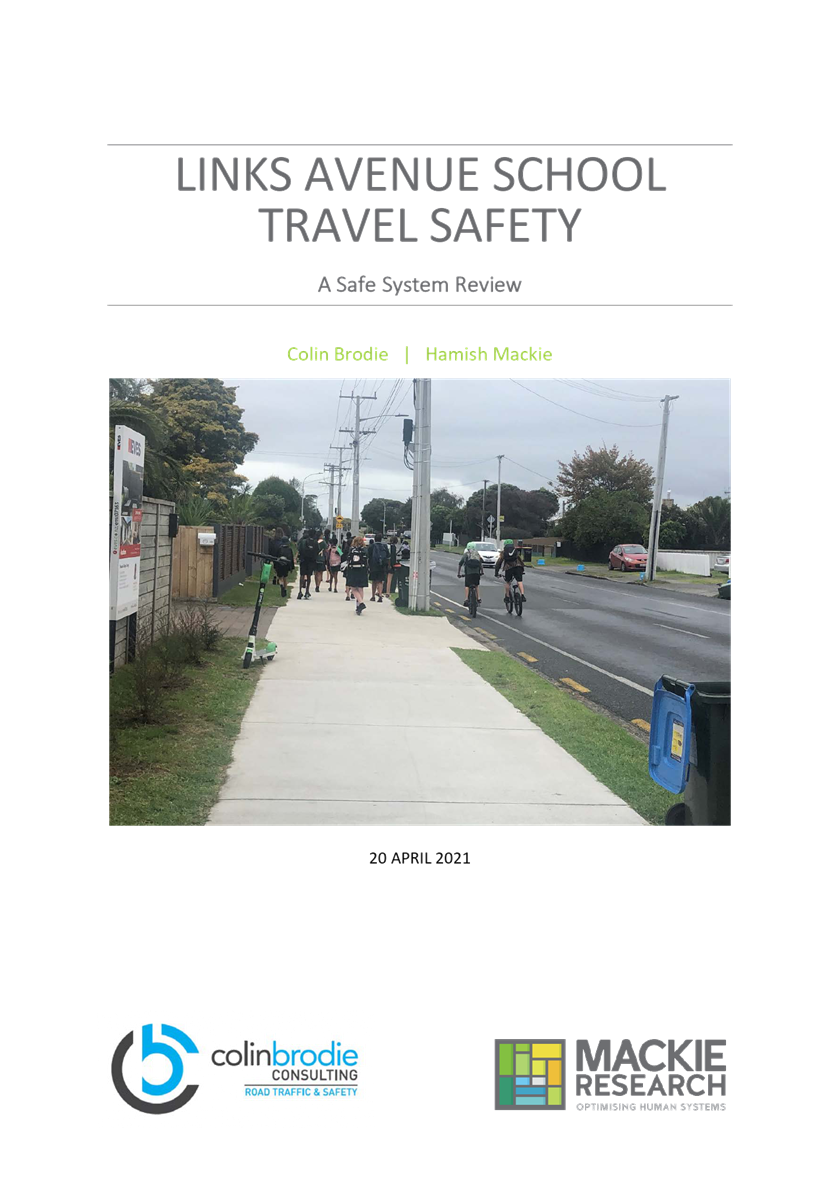
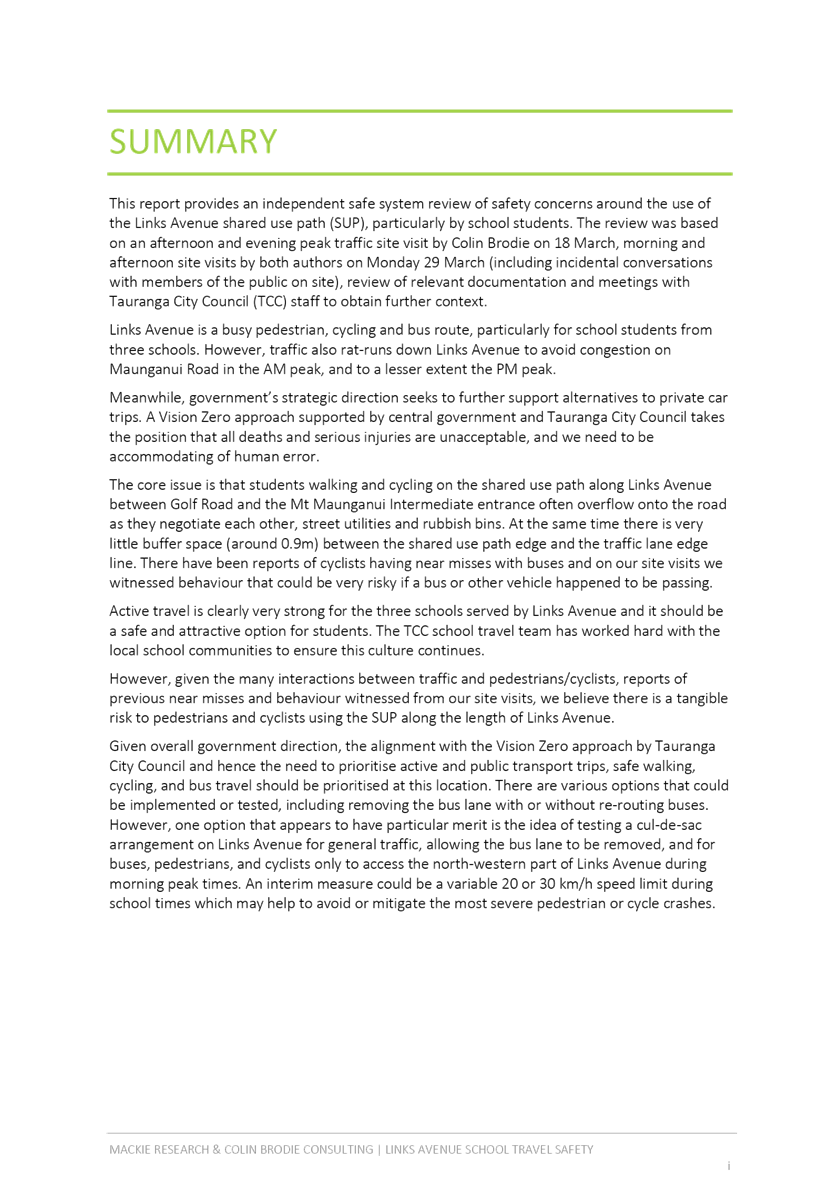
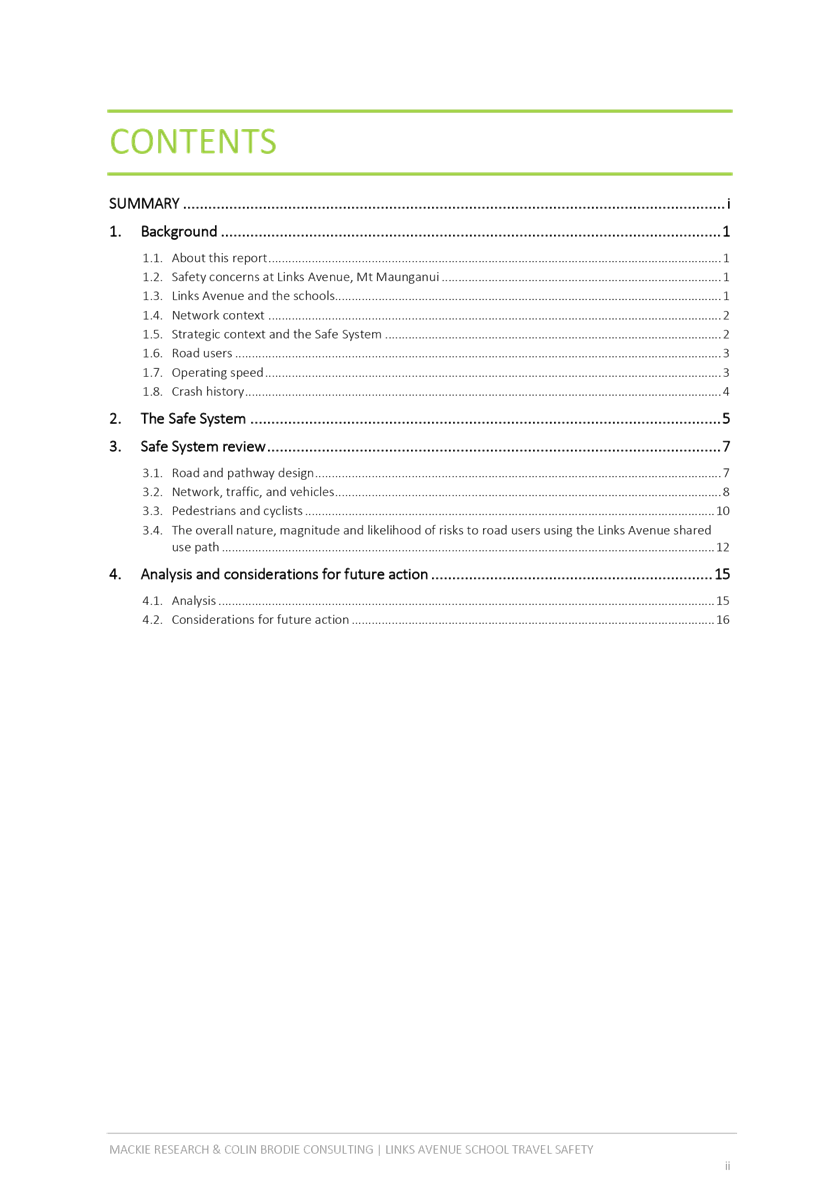
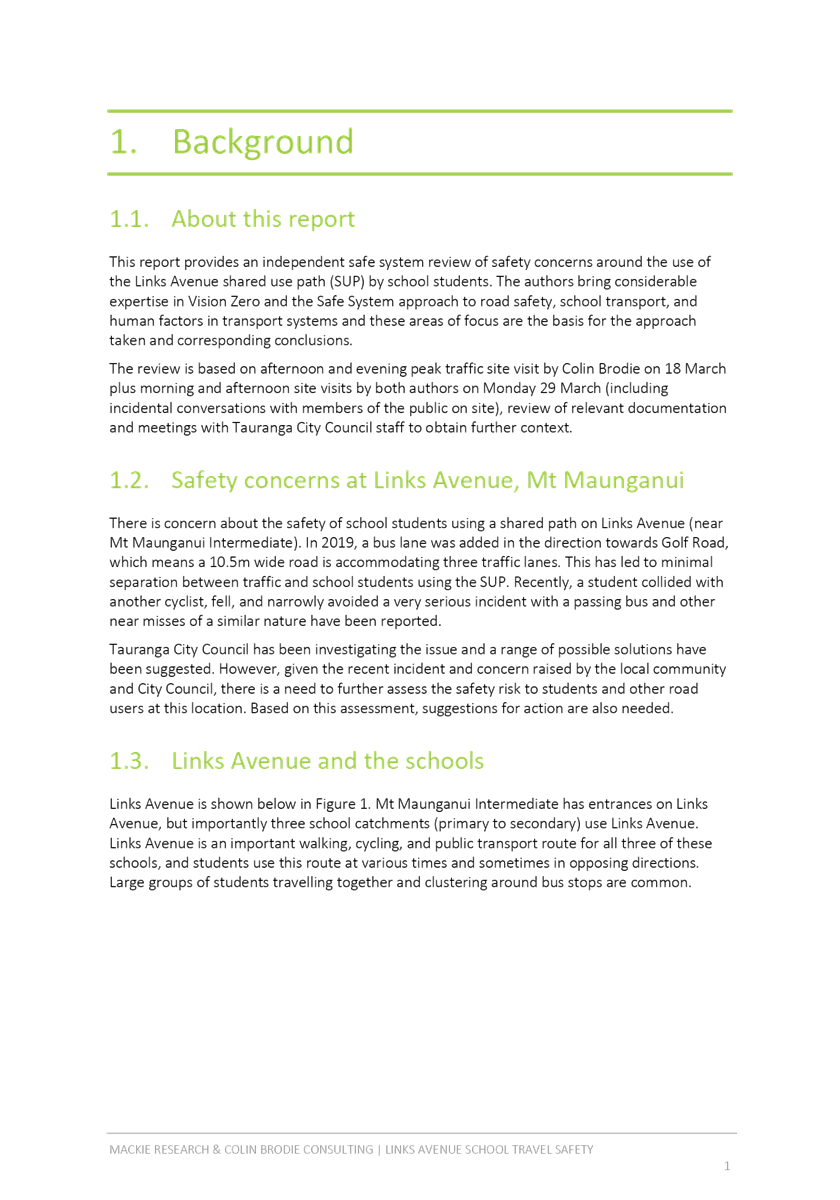
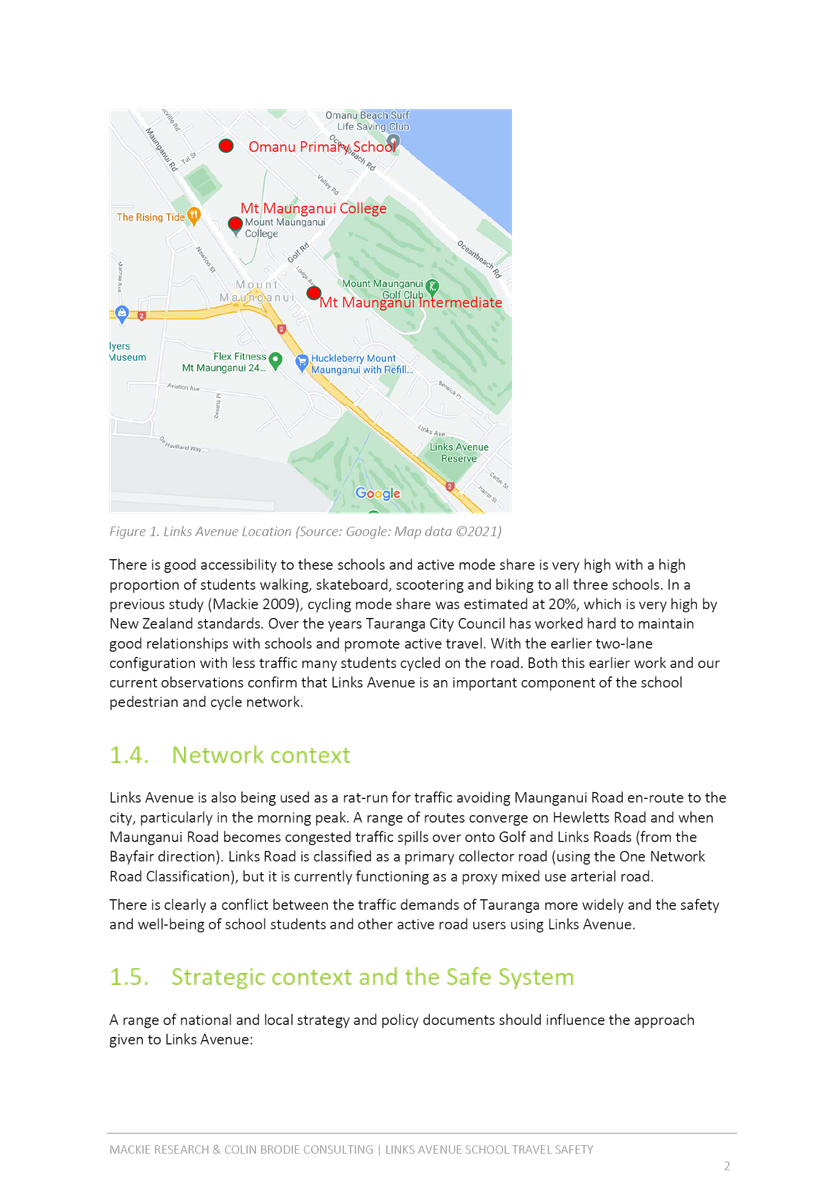
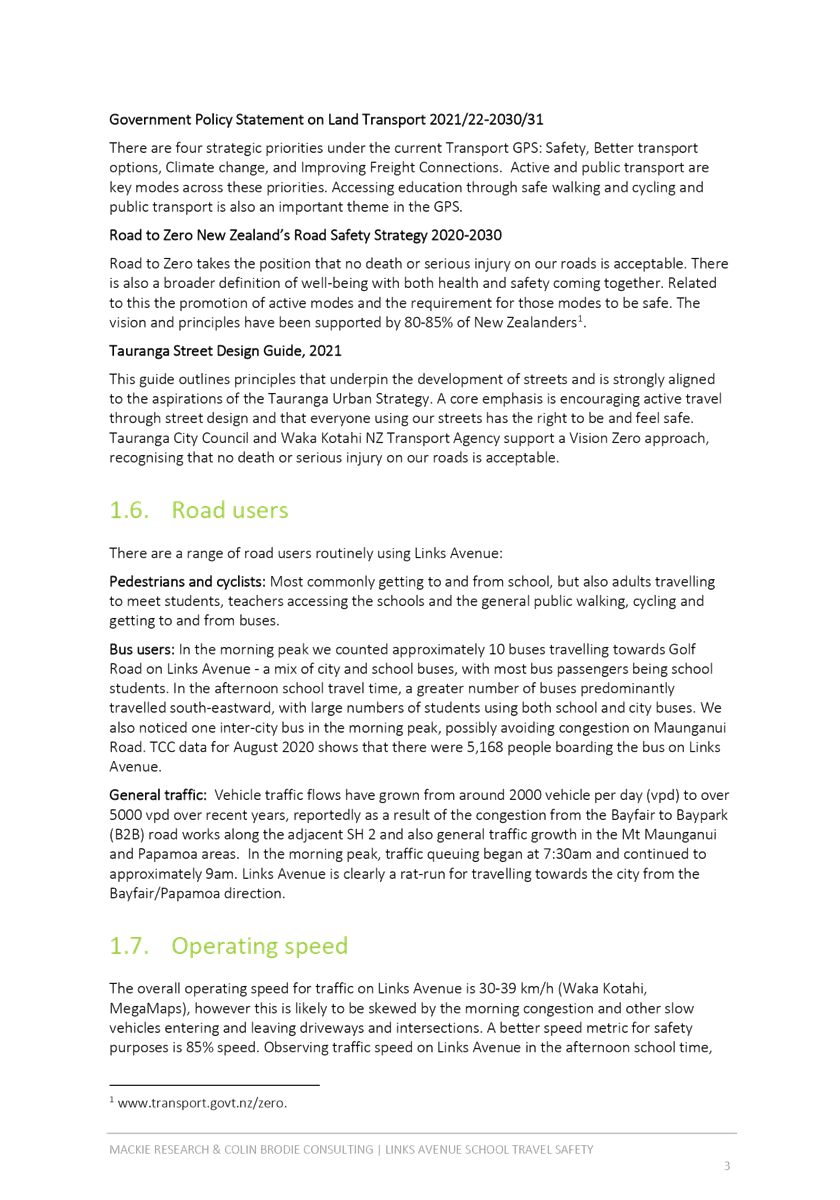
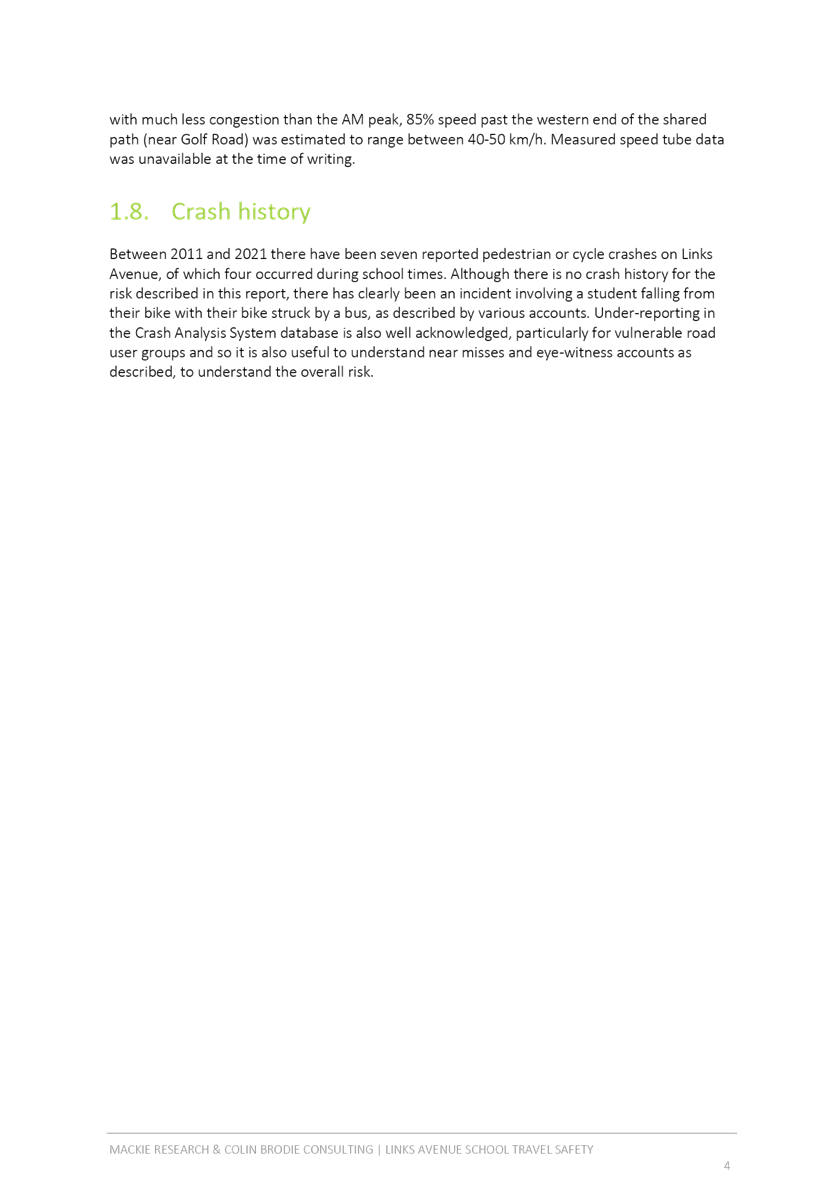
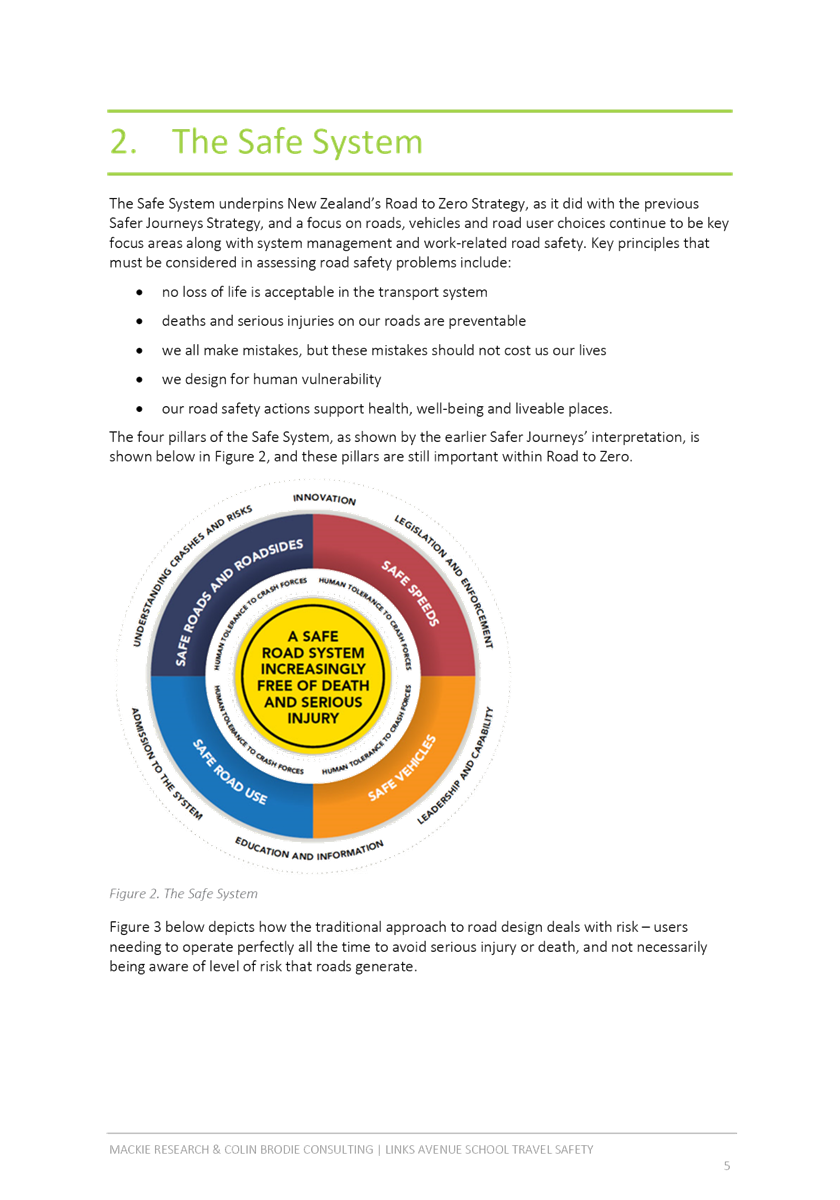
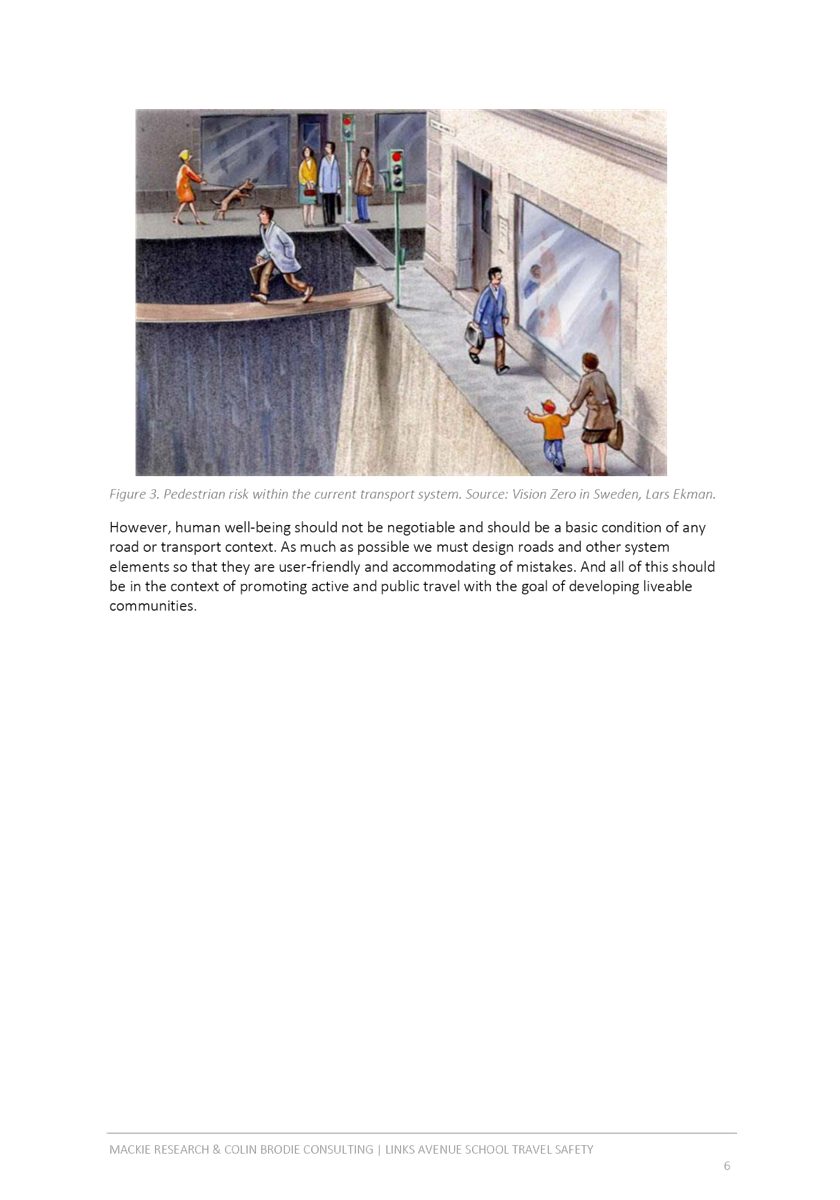
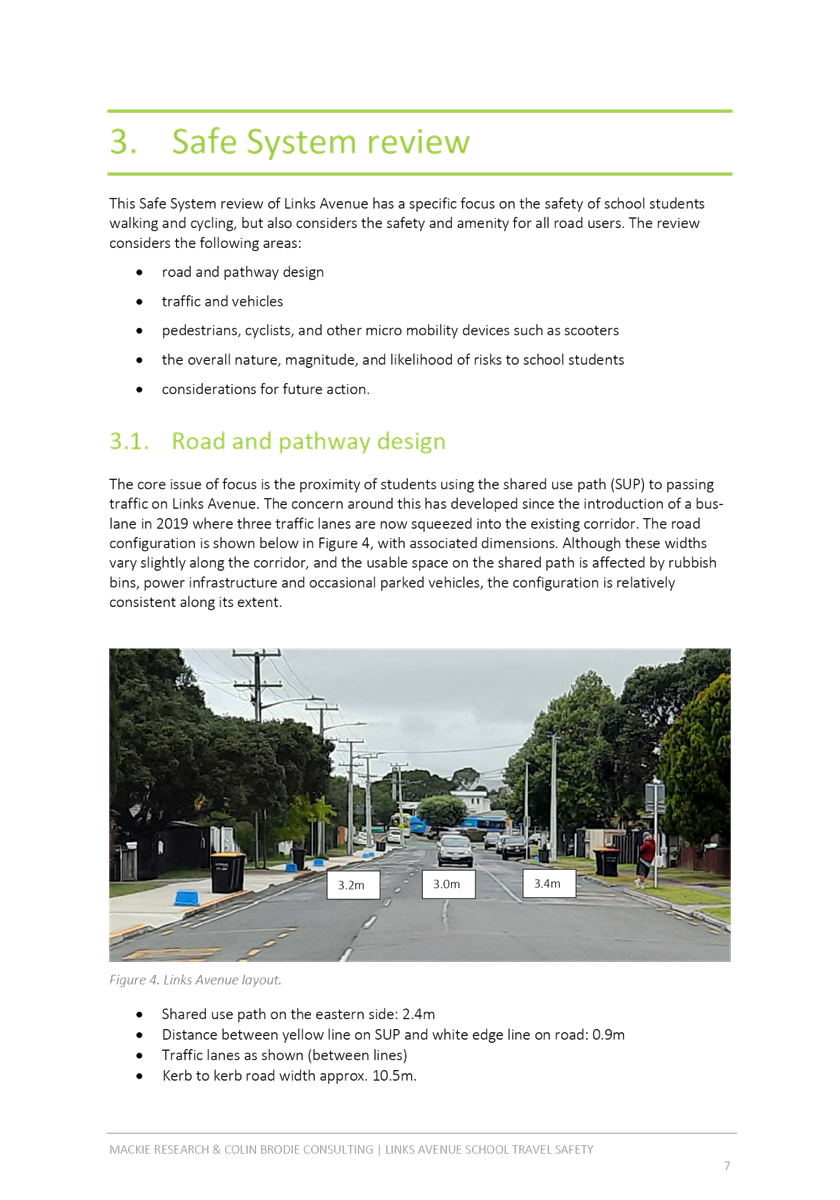
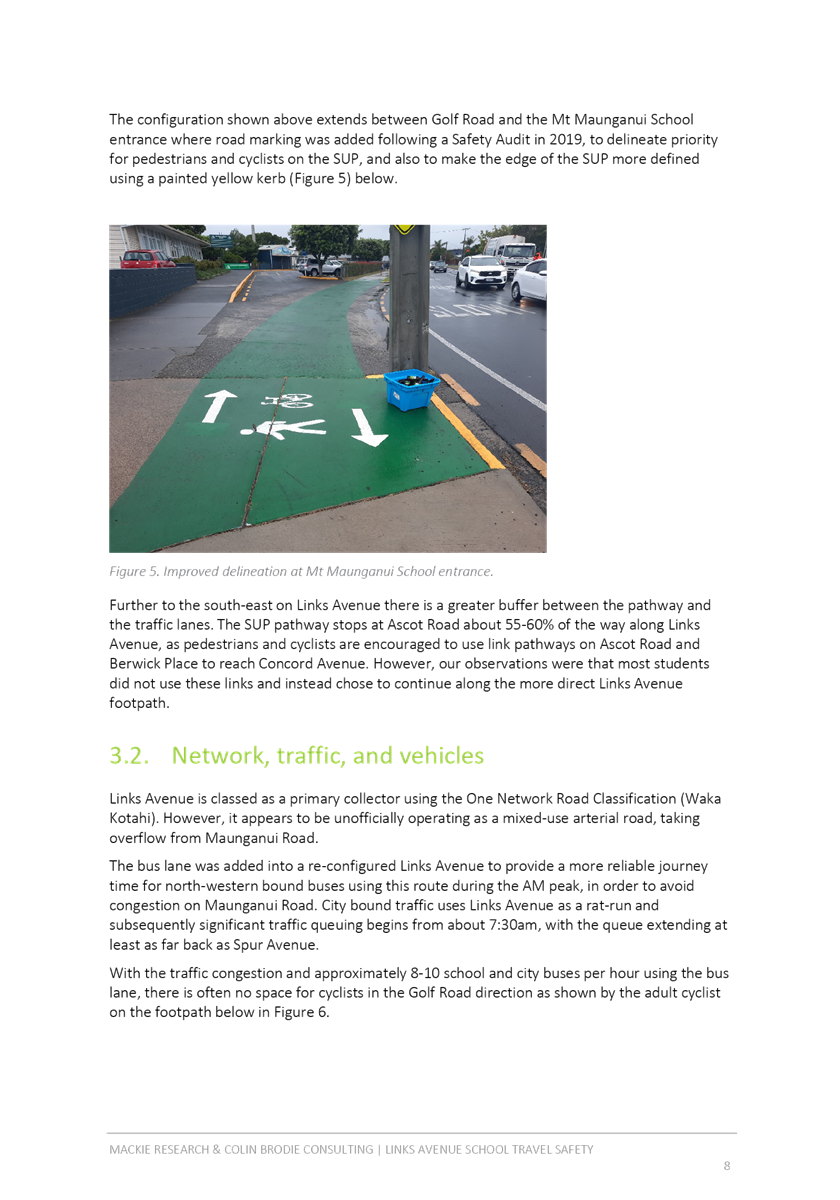
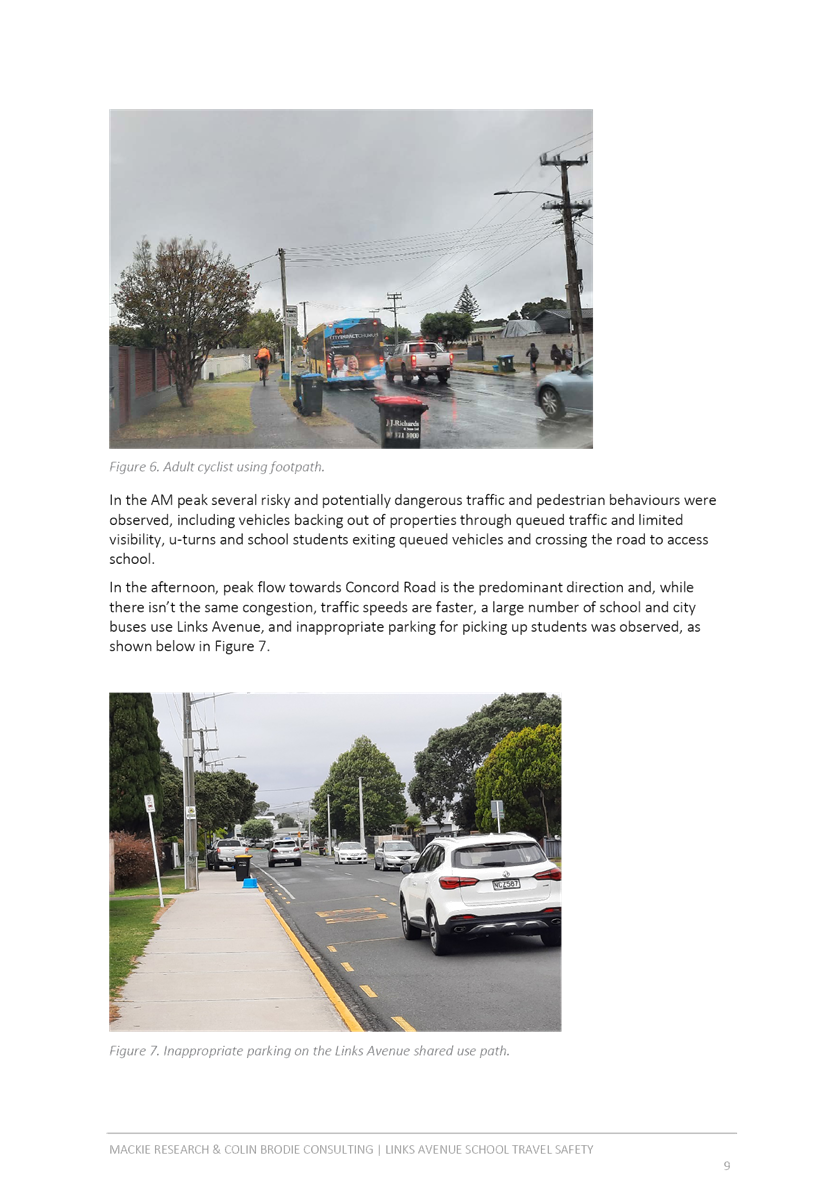
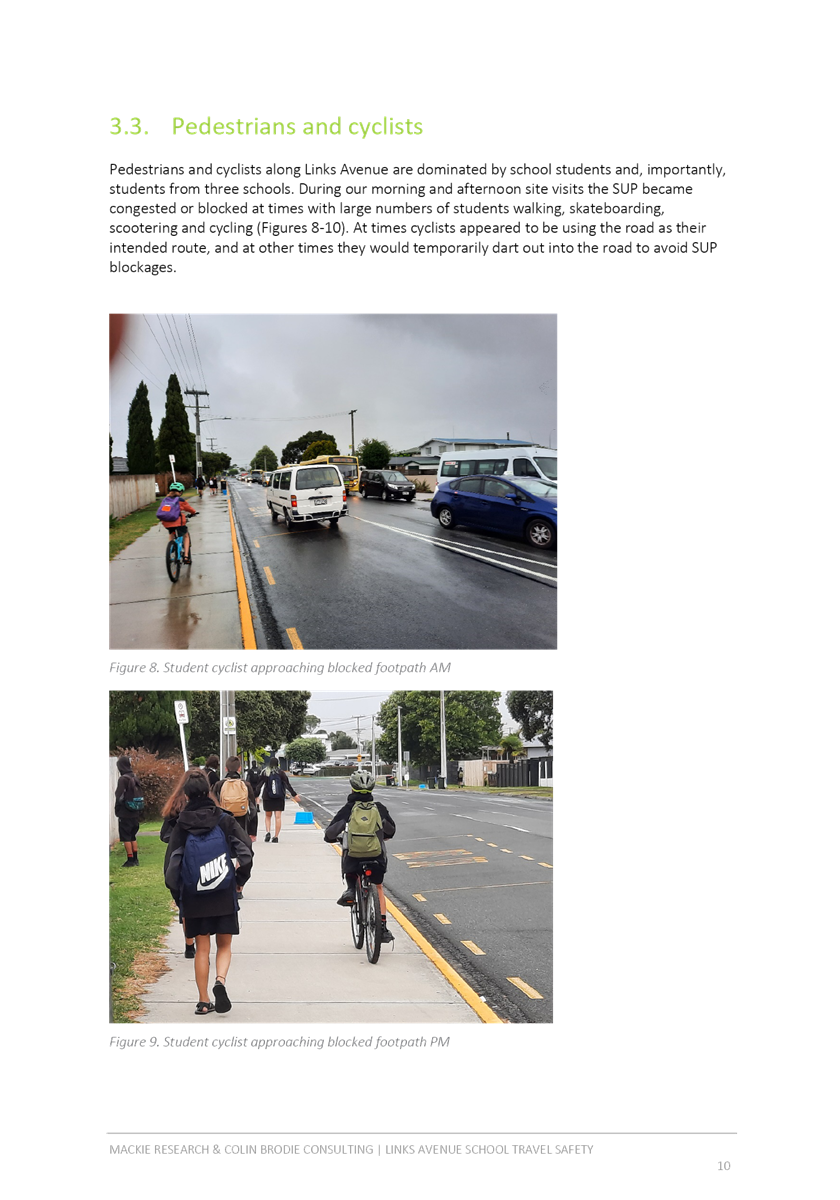
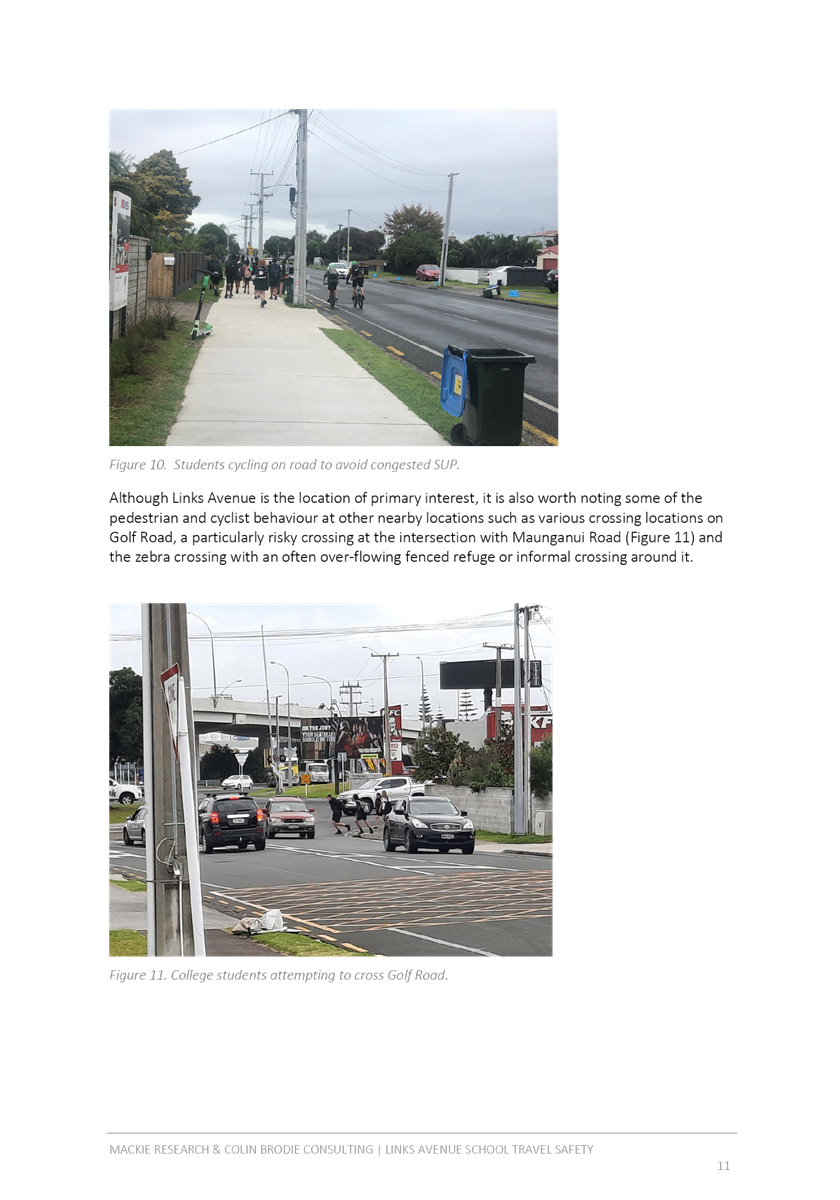
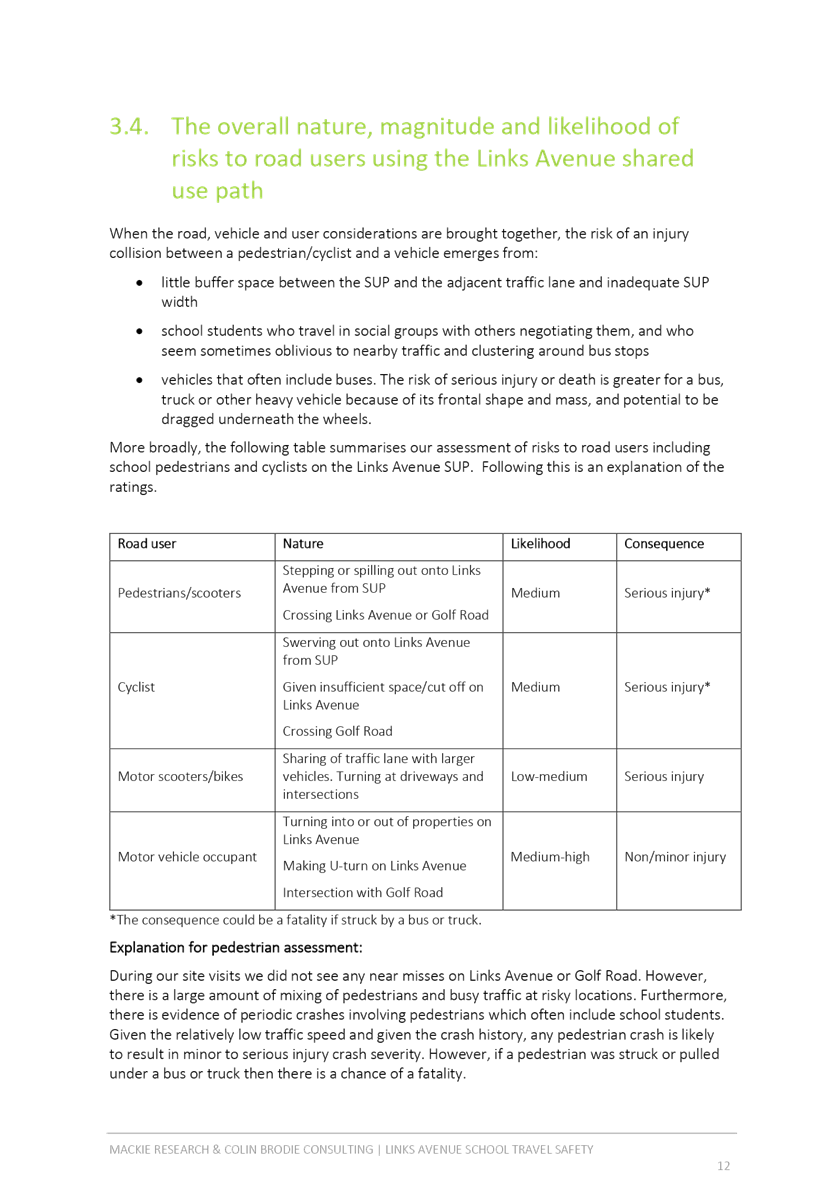
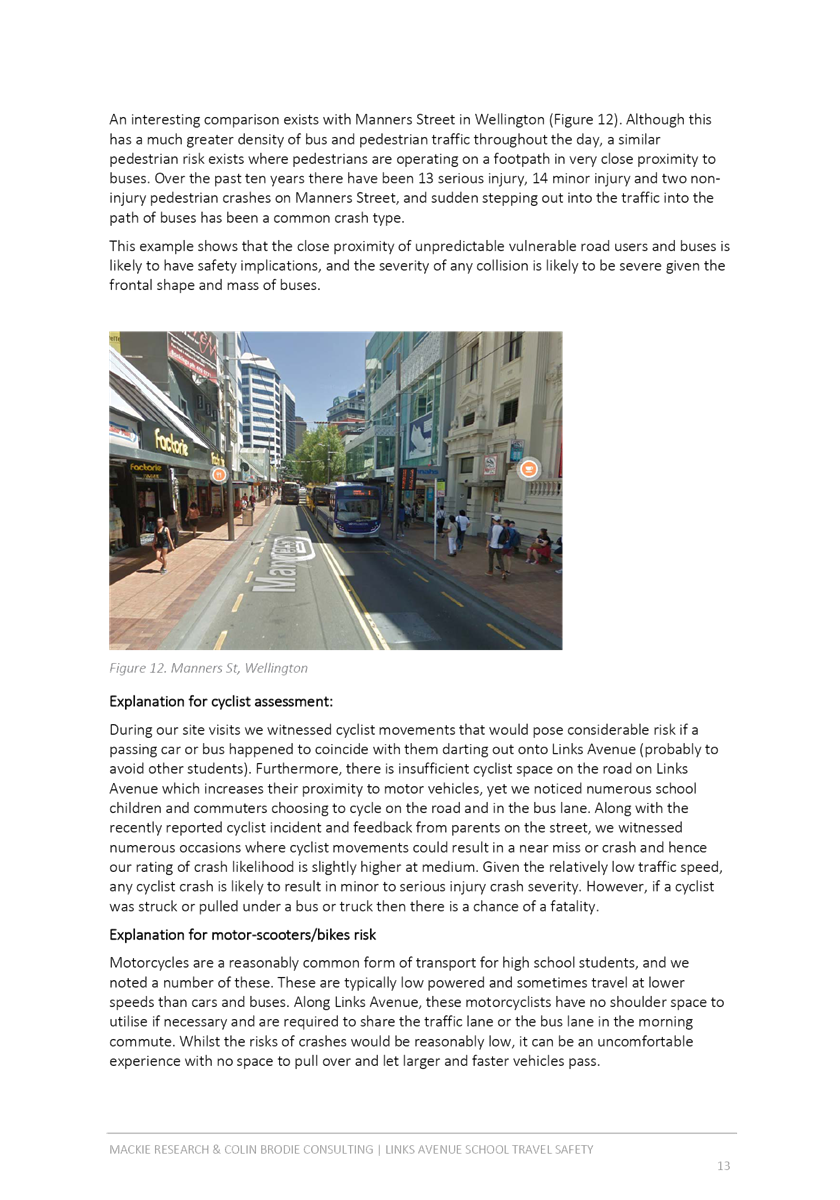

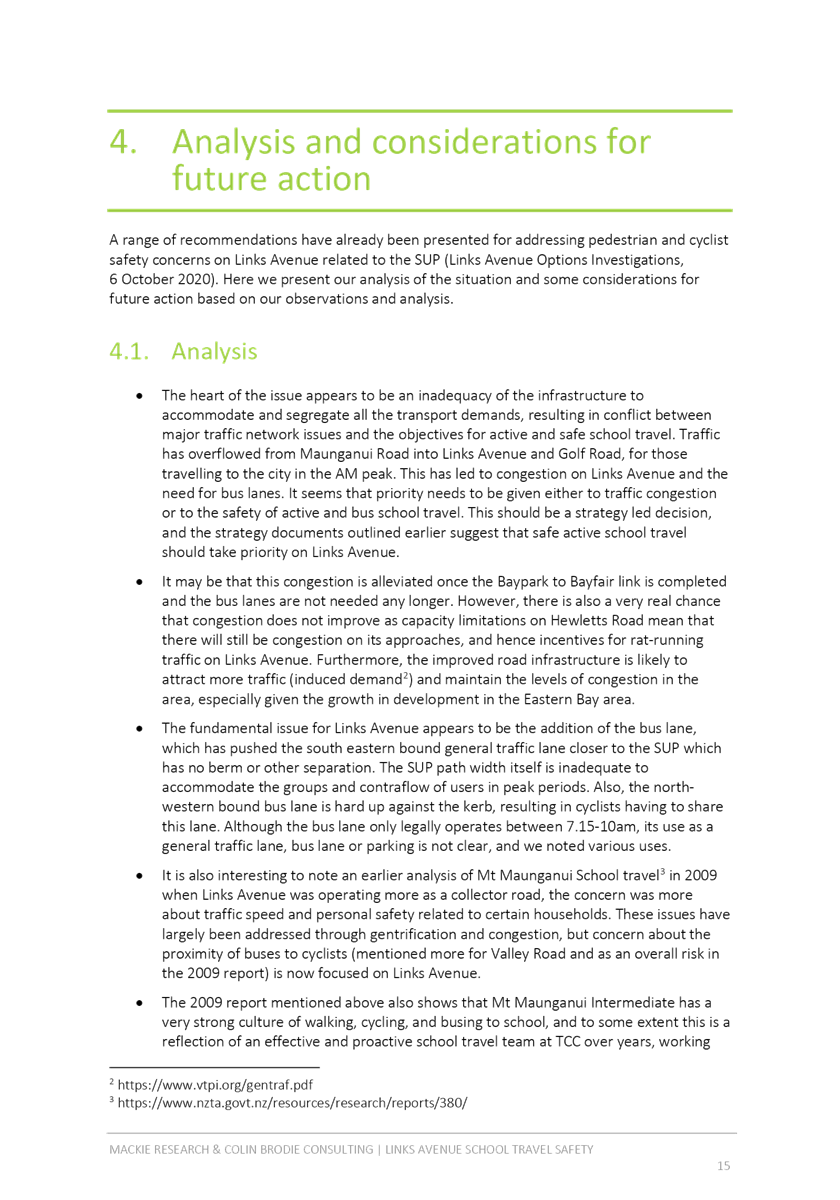
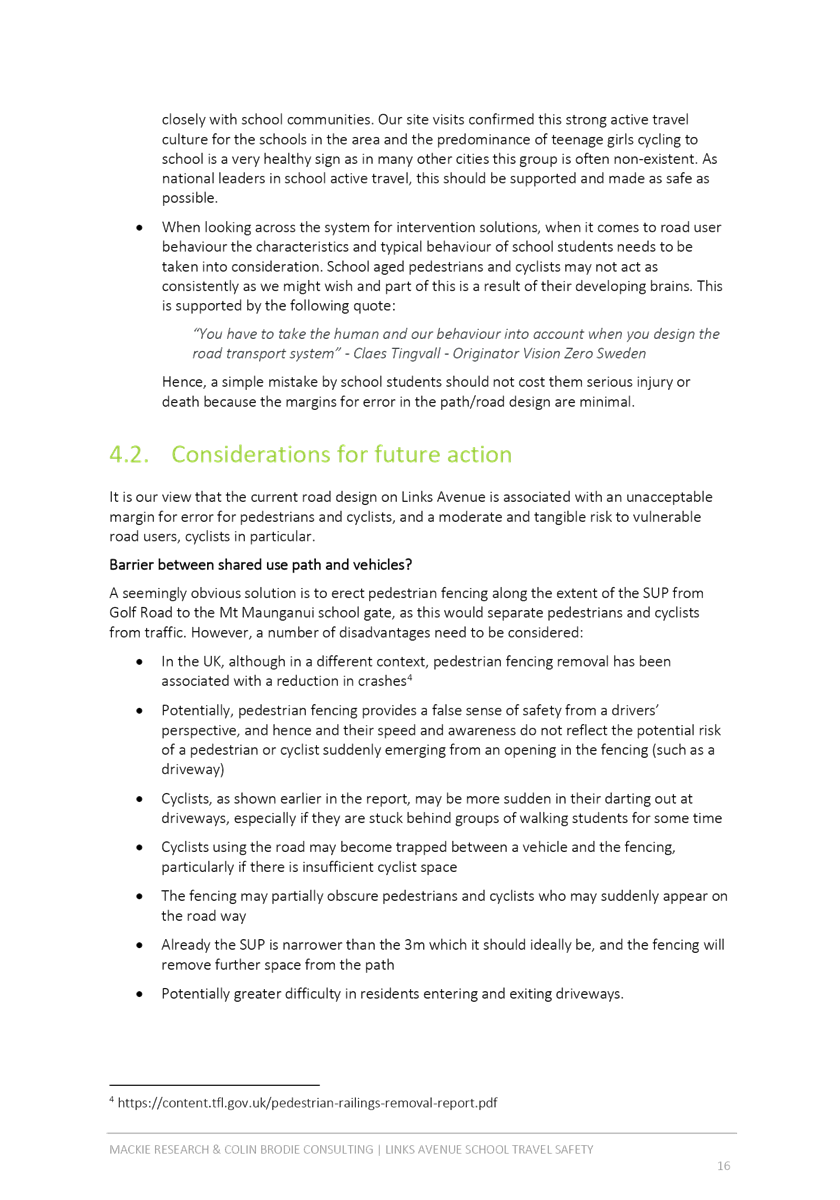
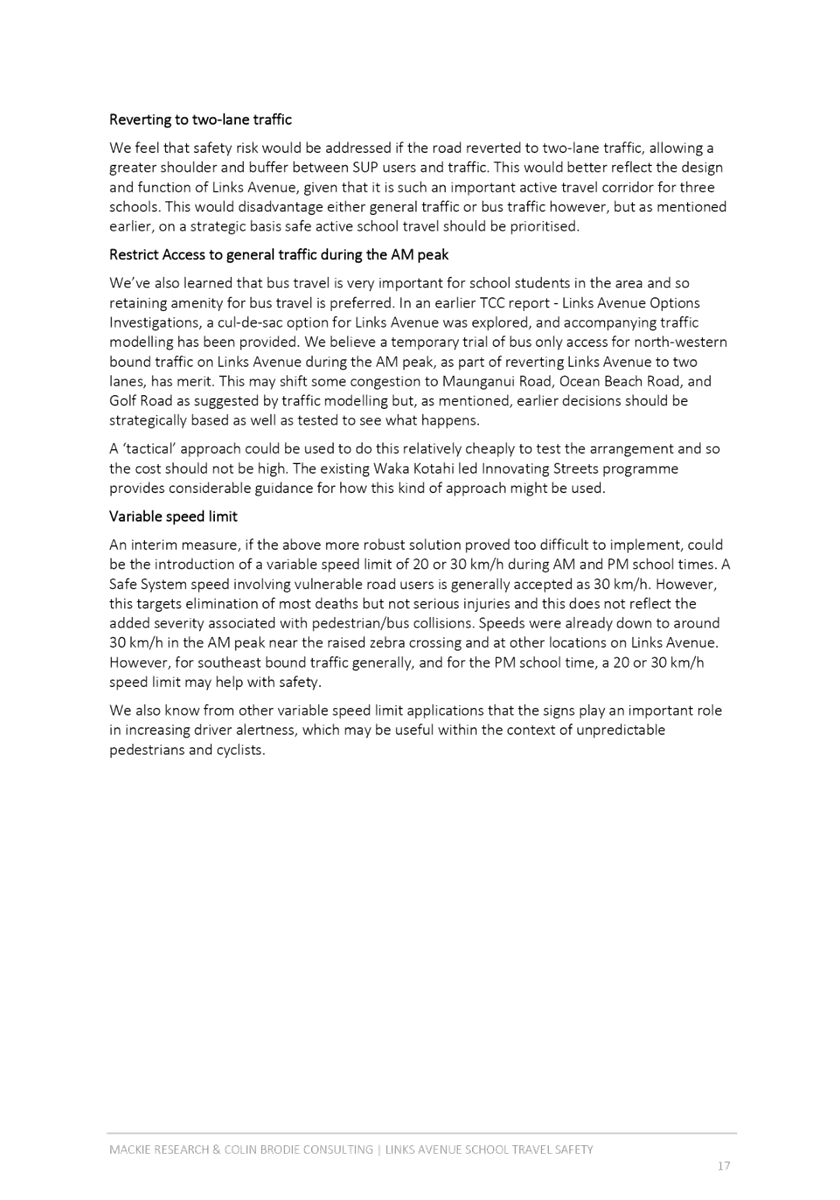
|
Ordinary Council Meeting Agenda
|
21 June 2021
|
10.3 Links
Avenue Options Investigations
File
Number: A11850925
Author: Brendan
Bisley, Director of Transport
Authoriser: Nic
Johansson, General Manager: Infrastructure
Purpose of the Report
1. The
purpose of this report is to report back to Council options for changes to
Links Avenue as requested by the Projects, Services and Operations Committee
(PSOC) after receiving a deputation from a group of Links Avenue residents
concerned about the safety of the road layout.
2. This
report presents options relating to changes that could be made to the street to
increase shared path widths, change the road layout as well as options to
reduce the volume of traffic and congestion along the street. The advantages
and disadvantages of each is included in addition to the costs and wider
impacts on the surrounding streets.
3. The
report contains a legal opinion on the powers of the Council in relation to the
routes used by passenger transport services and the setting of Passenger
Transport (PT) routes. The options considered by staff reflect the ability of
Council to have buses removed from Links Avenue.
|
Recommendations
That the Council:
(a) That
Council receives the report and recommends a shortlist of options to be
considered further by staff and consulted with the community.
|
Executive Summary
4. Staff
from the Tauranga City Council and the Regional Council have met with the
residents that presented at the recent PSOC meeting to better understand their
concerns and discuss options that could be implemented and the potential
impacts of each. Their primary concern is the safety of users on the shared
path and the separation from traffic between Golf Road and Ascot Road.
5. The
key issue in Links Avenue is the high traffic volume using the street as a rat
run to avoid the congestion on SH2 as a result of the NZTA Baylink to Bayfair
project. In the morning peak, traffic backs up along Links Avenue and this has
created issues for the other modes trying to use Links Avenue (pedestrian,
cyclists and PT users)
6. As
a result of the congestion and its impact on bus reliability, this Council
approved the implementation of the bus lane to allow buses to bypass the
morning peak queues and provide a better level of reliability for PT users into
the CBD and the schools in the area.
7. Links
Avenue has approximately 6,500 bus passengers that get on and off the buses
each month based off the Bee card data collected by the Regional Council. This
data also shows that approximately 2/3 of the users are school children going
to schools in the general area, so the PT service is an important service for
parents and students getting to and from school in the Papamoa and Mount
Maunganui area.
8. There
are several measures that could be implemented along Links Avenue to alter the
way it currently works and to reprioritise what modes are catered for. Each has
direct impacts on the street function, the residents who live on the street, PT
users and users of other modes as well as the surrounding streets due to
changes in traffic flows and potentially PT services. The changes could be
undertaken as standalone or as a combination.
9. In
some of the options, the issues being experienced in Links Avenue could be
simply transferred to another location so may not resolve the issue and may not
align with future intents of the TSP alignment for modes and routes.
Background
10. The
current road layout in Links Avenue was installed after the PT services were
relocated off SH2 due to significant congestion as a result of the NZTA Baylink
to Bayfair (B-B) project. The buses were routed along Links Ave to provide a
better reliability of service and to maintain a close proximity to the
destinations of passengers going to and from the schools in the area.
11. Links
Avenue is 10.5 to 11m wide along its length and has an estimated AADT of 5500
which is significantly higher than would be expected for a similar street
elsewhere. In 2013, prior to the B-B project, the volume was 2982, and
rose to 5130 in 2018 once the B-B works commenced. The traffic volumes have
almost doubled.
12. With
the traffic volumes, you would typically expect the peak hourly traffic to be
approximately 10% of daily volumes. In Links Avenue 25% of the daily traffic
volume is in the peaks which indicates the higher level of rat running along
the street.
13. The
key issue on Links Ave is the volume of traffic combined with the high number
of pedestrians and cyclists in the short peak periods at the drop off and
pickup times associated with the school. This occurs for approximately 40 weeks
a year during term times, and for half an hour in the morning and afternoon.
For the remaining 23 hours and during school holiday periods the issue is not
present.
14. In
2019 the current Council approved the installation of the bus lane to address
the buses being delayed by a large increase in rat running traffic through the
area also trying to avoid the congestion on SH2. Traffic had increased from an
AADT of 2982 to 5130 and bus travel times had increased by as a result as the
traffic queues on Links Ave extended about ¾ of the street at times.
These changes were made in February 2019.
15. The
bus lane was installed on the southeast side of Links Avenue to allow the buses
to travel from Concord Avenue to Golf Road past the queued traffic. The bus
lane required the removal of parking on the opposite side of the road and the
traffic lanes to be moved across to be adjacent to the foot path.
16. The
City Link and Hospital Link bus routes started in December 2018, approximately
two months before the bus clearway was installed on Links Avenue.
Comparing February 2019 with February 2020, patronage on these routes has gone
from 35,500 to 44,700 (an increase of 11,000 or 25%). Data for August
2020 shows that there were 5,168 people boarding buses on Links Avenue.
17. A
shared path has been installed from Golf Road to Ascot Road and along a section
from Concorde to just pass the Links Avenue Reserve. Which then connects to the
bus lane for cyclists.
18. The
TCC travel safe teamwork with the Mount Manganui Intermediate School to educate
the children how to safely use the cycle facilities to and from the school and
nearby destinations such as Bayfair Mall. This work is ongoing as new groups of
students start school each year. This service provides a high level of
education for students to remain safe on the facilities in the general area.
19. After
the installation of the bus lane, some residents have expressed concern about
the safety of pedestrians and cyclists using the street, especially with the
buses.
20. In
response to the resident’s concerns, the following safety reviews have
been undertaken:
· TCC
traffic engineering staff have reviewed the site layout
· A
safety audit was undertaken by independent safety experts
· NZTA
have had an onsite review undertaken by an internal safety expert based in
another region of New Zealand.
21. These
reviews have identified some minor changes, and these have been gradually
implemented.
22. Residents
have reported some non-injury accidents between buses and infrastructure as
well as buses and cyclists. Each of these has been investigated by the Regional
Council at the time, but no changes have been required to the road layout as a
result of those investigations. One of these accidents was related to a school
bus service and was not related to the services run by the Regional Council.
23. Bus
drivers have implemented a voluntary 30km/h speed limit when travelling in the
bus lane on Links Ave to increase safety and decrease the chances of any
accident leading to serious injuries.
24. Attached
to this report are the previous reports considered by Council and the accident
investigations undertaken by the Regional Council. Also attached is a memo from
the Regional Council providing data on the bus service patronage.
Options Analysis
25. The
options investigated in this section are a review of options to address the
issues of large traffic volumes, limited space and a need to increase the
available space for pedestrians and cyclists along the route. Each option has
the advantages and disadvantages listed as well as the impacts on the
surrounding community. The indicative cost to undertake the works is also
identified.
26. The
options have been grouped around achieving a specific change as detailed below:
27. Traffic
Volume Reduction
28. The
key issue on Links Avenue is the volume of traffic as this has resulted in
delays for buses which then required the installation of the bus lane. The
traffic volume is high as there are limited options to travel between Papamoa
and the Mount through this section and there are only 3 streets that connect
(Ocean Beach Road, Links Ave and SH2). With the construction underway on the
B-B project by NZTA, traffic has diverted to the remaining two connections and
the volume has increased significantly along Links Ave.
29. Cul-de-sac
option - To reduce this volume the street could be made into a cul-de-sac.
This could be done at either end or in the middle and would reduce traffic to
only residents. In this scenario, buses could be allowed to remain travelling
along the street by forming a short bus lane through the cul-de-sac. With the
low traffic volumes, the bus lane would no longer be required. To improve
safety, a 30km/h speed limit could be implemented as traffic speeds would
increase with the lowered traffic volumes.
30. Advantages
– the street functions as a residential street rather than a collector,
residents have less traffic, noise and air quality will be improved, it will be
safer for pedestrians and cyclists due to lower traffic volumes and the ability
to remove the bus lane. The bus lane could be removed as buses would no longer
need to bypass the traffic queues and would be able to achieve reliable travel
times along Links Avenue.
31. Disadvantages
– Residents that live in Links Ave and streets that come off it will need
to drive further to get to and from their homes, there will be a significant
increase in traffic on Ocean Beach Road as through traffic diverts off SH2,
traffic speeds in Links Ave will increase when we have the peak students
numbers even with a 30km/h speed limit as currently the congestion is resulting
in slow traffic speeds in the peak hours.
32. Indicative
Cost – The costs to install a cul-de-sac will be dependent upon its
location, but costs could range from $500,000 to $1million.
33. Increased
space for pedestrians and cyclists
34. With
the current shared path, the width is less than the recommended 4m due to power
poles along the road edge. This results in cyclists and pedestrians needing to
carefully travel along the path. To provide more space for pedestrians and
cyclists we have the following options:
35. Undergrounding
of the overhead services – If the existing overhead services
were undergrounded between Golf Road and Ascot Road, we could widen the shared
path to the recommended 4m.
36. Advantages
– The shared path meets the recommended width and the street aesthetic is
improved with removal of the existing overhead services.
37. Disadvantages
- The undergrounding will prevent the use of the existing shared path
while construction is underway, residents in the length being undergrounded
will be impacted as the services into their houses will also be undergrounded,
there will be no ability for residents to park on the berm as currently happens
at some houses, the path will cover the full width between the boundary and the
property fences so there will be no green space in the street and vegetation
will need to be trimmed to the fence. Residents exiting their property will
need to be more cautious as the shared path will be up against the boundary so
pedestrians and cyclists will be harder to see past fences.
38. Cost
– The cost to undertake the undergrounding and widen the shared path is
expected to be approximately $1-1.3million.
39. On
road cycle lanes and removal of the bus lane - If the bus lane was removed,
the road layout could be reconfigured. There are two options. Option 1 would
have a 1.8m cycle lane each side and a 3.5 to 3.6m vehicle lane. This would
create the 1.5m buffer space between vehicles and users of the shared path.
40. Alternatively,
we could create a 1.5m cycle lane, a 3.2m vehicle lane and a 1.5m flush median
down the centre of the road.
41. In
both options there would be no parking on road the entire length of Links
Avenue and on both sides.
42. Advantages
– This is the lowest cost option as it is only road marking changes.
Option 2 would have the lowest vehicle speeds due to the narrower vehicle lanes
slowing vehicles and the flush median would allow for residents to turn into
their houses without holding up traffic along the street.
43. Disadvantages
– Buses will be slowed as they are unable to bypass the congestion in the
street, residents on Links Ave will be impacted by having no on street parking
for visitors or trade people etc, it is highly likely that people will park in
the cycle lanes and partially over the shared path to drop-off and pickup. This
will force cyclists into the live traffic lane and may lead to conflicts
between car doors and users of the shared path.
44. Costs
– The road markings could be reconfigured for approximately
$50,000-$75,000
45. New
shared path on opposite side of Links Ave – A new shared path could
be constructed along the south side of Links Ave between Golf Road and the
school to increase the space allocated for pedestrians and cyclists in this
section. This would allow the larger groups to use both sides and avoid the
congestion sometimes observed.
46. Advantages
– There is enough space to build a widened footpath that could be used,
there is an existing pedestrian crossing at the school, so students have a way
to cross to the opposite side of the road and use a shared path.
47. Disadvantages
– The pedestrians and cyclists desire line may not want them to cross the
road to use a path on the opposite side resulting in limited use.
48. Costs
– A new path would cost approximately $300,000.
49. Widening
of the roadway – The existing street is only 10.5 to 11m wide which
is relatively narrow. If the kerb and channel was replaced on the south side
between Golf Road and Ascot Road, we could widen the road by 1-1.5m and create
a buffer zone for the shared path on the school side of Links Ave.
50. Advantages
– This section of Links Ave is the section with the highest volume of
users of the shared path. The increased with will allow a buffer zone between
the path and the vehicle lane.
51. Disadvantages
– The work will require the temporary removal of the bus lane and will
impact on the bus reliability during that time. The change will also narrow the
footpath and berm on that side of the road, but it will still be 3-3.5m in
width so can accommodate the footpath. Some underground services under the
footpath may need to be lowered as part of the widening project.
52. Costs
– The estimated costs for this are $600,000-$800,000 depending on the
number of services that need lowering
53. Alternative
Routes
54. There
are large peak volumes of pedestrians and cyclists walking along Golf Road to
the Mt Maunganui Intermediate school. These kids and parents can conflict with
the high school students that catch the bus on Golf Road as both peaks can
occur at the same time.
55. The
students catching the bus are on Links Ave as they are catching a city to
Papamoa service that comes along Hewitt’s and Golf Road. Previously the
stops were near the over bridge, but we had students running across the road
and through the planting areas where traffic were unable to see them as they
got close to the road. The stop was shifted to Links e to improve safety.
56. Pedestrians
and Cyclists use Lodge Avenue to access the school off Golf Road – Lodge
Avenue is a short cul-de-sac that goes from Golf Road into the back of the
school. If Pedestrians and cyclists used this entrance, they would not need to
use Links Avenue, and this would avoid the conflict with the bus users and the
traffic volumes. Discussions would be required with the school to create
appropriate paths to connect to bike storage etc, but it would be significantly
safer.
57. Lowered
speed limits
58. The
speed limit could be lowered in this area as part of the upcoming city-wide
speed limit review. A lower speed limit would reduce the severity of any
injuries that occur when traffic volumes are lower and traffic is able to
travel at normal speeds, and will increase the opportunity for vehicles to stop
if a cyclists was to fall off their bike or a pedestrian stepped into the road
space in front of them.
59. With
the current congestion in the peak hours, traffic is travelling slowly and
therefore any lowering of speed limits will be make an impact during those
times.
60. Permanent
Speed Limit Change - a speed limit of 30 or 40km/h could be implemented
although it should be noted that in the peak hours speeds along Links Ave are
below 20km/h due to the congestion and traffic volumes. Buses are also operating
at a voluntary 30km/h speed limit along the bus lane.
61. Advantages – a lower speed
limit is more appropriate for a congested corridor and will reduce the severity
of injuries if accidents were to occur.
62. Disadvantages
– Without enforcement, it is unlikely traffic would stick to an isolated
lower speed limit when the street is not congested, a new speed limit would
need to be consulted with affected residents, NZTA and other statutory
authorities and they may not approve unless they feel the road environment has
been changed to reflect the lower limit.
63. Costs
– A speed limit change is the lowest cost option as it only requires new
signs. The indicative cost is between $5,000 and $10,000 depending on where the
new speed limit is applied.
64. Narrowing’s
and vertical changes (road humps, platforms) - Measures could be installed
along the street to slow traffic in addition to a lower speed limit being
installed. These measures could be road humps or platforms at regular spacings
along the street to slow vehicles as they travel along the street. This would ensure
that speeds are kept lower outside of the peak congestion periods.
65. Advantages
– speeds are kept lower at all times; it is more likely a lower speed
limit would be approved by NZTA.
66. Disadvantages
– road humps and platforms create more noise for residents as vehicles
travel over them, vehicles are likely to speed up and then brake between the
vertical road humps and platforms so while the average speed is lower, there
are higher peak speeds between the humps and platforms, the humps and platforms,
and associated signage are visually intrusive in the streets, bus passengers
may experience a poor ride quality along Links Avenue.
67. Platforms
and humps are more difficult for larger vehicles to use due to their longer
wheelbase, so if they were not installed in the bus lane it is highly likely
vehicles would simply bypass the hump by driving in to and out of the bus lane.
This would endanger any cyclists that was riding along the bus lane.
68. Costs
– The costs for this option could be approximately $500,000 depending on
the number of narrowing’s, humps and platforms installed.
69. Fencing
70. To
improve the separation between the shared path and the traffic lane between the
school and Golf Road, a fence could be installed along the path edge so users
of thee shared path are not able to fall into the road. This will prevent a
path user from falling into the path of an oncoming vehicle.
71. At
residential driveways there would be gaps in the fence to allow vehicles to
enter and exit the properties.
72. Advantages
– The fence will prevent users being able to fall into the road which
will increase the safety for users.
73. Disadvantages
– The fence will reduce the available path width as it needs to be placed
approximately 300mm from the edge of the road and the fence will be
approximately 75-100mm wide. There will be gaps in the fence at the driveways,
so it is possible for a user on the shared path to end up in the live traffic
lane at those locations. The fence would change the visual aspects of the street
and may make it harder for residents to enter and exit their properties.
74. Costs
– A pool style fence would cost approximately $250/m so the costs to
install the fence between Golf Road and Ascot Road would be $100,000-150,000.
75. Alternative
Bus Routes
76. The
bus route could be changed to use another street. The alternatives are either
SH2, where it previously ran, or Ocean Beach Road.
77. Links
Avenue is currently served by two major urban routes:
· Hospital
Link (Bayfair – Mount Maunganui – Tauranga CBD – Hospital)
which runs every 15 minutes Monday to Friday and every half hour at weekends /
public holidays.
· City Link
(Bayfair – Tauranga CDB – Mount Maunganui) which runs every 15
minutes Monday to Friday and every half hour at weekends / public holidays.
78. These
two routes provide a combination of 8 services per hour on Links Avenue in each
direction on Mondays to Fridays (4 per hour in each direction weekends / public
holidays). In addition, there are various school contract services
transporting pupils to the Intermediate school on Links Avenue and the nearby
Mount Maunganui College.
79. Data
for August 2020 shows that there were 5,168 people boarding the bus on Links
Avenue.
|
Fare Type
|
Boardings
|
|
Adult
|
837
|
|
Child
|
3,899
|
|
Tertiary
|
212
|
|
Supergold
|
211
|
|
Infant (under 5)
|
9
|
|
TOTAL
|
5,168
|
· Approximately
1,512 of these boardings were on the City Link route.
· Approximately
1,600 of these boardings were on the Hospital Link.
· 2,650
boardings were on dedicated school services.
80. The
existing bus services could be changed to use another parallel road. The
alternatives are either SH2, where it previously ran, or Ocean Beach Road.
81. There
are three options:
· Re-route all
urban services via Concord Avenue and SH2;
· Re-route all
urban services via Concord Avenue, Ocean Beach Road and Golf Road; or
· Re-route
eastbound services via SH2 and Spur Road so that they avoid the western section
of Links Avenue.
82. The
pros and cons of each option are summarised as follows:
|
Option
|
Advantages
|
Disadvantages
|
|
Concord Avenue and SH2
|
Buses will be removed entirely from Links Avenue and
safety concerns addressed
|
Safety concerns for passengers alighting from westbound
services having to cross four lanes of traffic on SH2 (which would mean no
services could stop)
Potential objections from the NZ Transport Agency for
stopping buses on the State Highway
Buses will be caught up in congestion during the Baypark
to Bayfair works
Passengers who live north of Links Avenue will have
further to walk to catch their bus (at least another five minutes)
No safe way for school students to access urban bus
routes, possibly resulting in additional cost to provide more school buses
Significantly reduces travel options for residents of
Links Avenue
Currently unable to turn right out of Concord Avenue onto
SH2
|
|
Concord Avenue, Ocean Beach Road and Golf Road
|
Buses will be removed entirely from Links Avenue and
safety concerns addressed
Passengers who live closer to Ocean Beach Road will have
less far to walk to catch their bus
|
The route is longer and less direct than Links Avenue, and
could add another 5-10 minutes to journey times
Passengers who live on or closer to Links Avenue will have
to walk further to catch their bus (at least another 5 minutes)
No access to Mt Maunganui Intermediate from urban bus
routes
Oceanbeach Road is just as congested with peak traffic,
and this option will just move the buses from one residential street to
another
|
|
SH2 and Spur Road
|
Enables eastbound bus services to avoid the section of
Links Avenue that is of most concern to local residents (between Golf Road
and Spur Road)
Removes 8 buses an hour from the eastbound side of Links
Avenue and effectively halves the number of buses on this section of Links
Avenue.
Retains the bus clearway and enables commuters to still
have the advantage of a faster and more reliable trip to the Tauranga CBD in
the mornings.
|
Passengers who live on or near the section of route from
Golf Road to Spur Road will have to walk further along Links Avenue to catch
an eastbound bus
Creates confusion for passengers by having services using
different routes in each direction
Would require additional school bus services for pupils
from Mount Maunganui College who currently catch the urban service at the
eastbound stop nearest to Golf Road
|
83. The
Regional Council is of the view that all the above options have significant
disadvantages from a service operational and passenger convenience
perspective. It is worth noting that the majority of passengers are
children and expecting them to walk further to catch a bus could expose them to
additional risk from having to cross busy roads.
84. Making
buses less attractive by increasing both in-vehicle travel time and walk time
to a bus stop will not deliver council objectives of increasing levels of bus
patronage as set out in the Urban Form and Transport Initiative (UFTI)
Programme Business Case.
85. However,
the Regional Council is also concerned to ensure that road safety issues are
addressed where feasible and will be able to undertake further work to
investigate potential service changes.
Financial Considerations
86. Due
to the short time frames available to prepare the report, the costs included
are indicative and high-level estimates that need to be further refined.
Costs are based on typical rates per metre abut are likely to be +/- 50% due to
the lack of detailed investigation.
Legal Implications / Risks
87. A
legal review was undertaken of the powers of the Council regarding bus lanes.
The following information has been provided by Simpson Grierson.
TCC does not have any power to directly determine (or
change) a bus route in its district. Subject to any lawful traffic
restrictions (see below) and road user rules, buses may travel on any roads in
the district, including when they’re being used for passenger
transport. The public bus services (including routes) are managed by the
Regional Council, under contracts with the bus operators pursuant to the Land
Transport Management Act 2003 (LTMA). (In saying this, I assume
there has been no transfer of public transport responsibilities from the
Regional Council to TCC).
TCC cannot force the Regional Council to change the
routes. However, one of the statutory principles applying to public
transport services in the LTMA (s 115(1)(a)) is for regional councils and
public transport operators to collaborate with territorial authorities to
deliver the necessary public transport services, and this should extend to
cooperating to address any public safety issues arising out of the contracted
bus services and their routes. The Bay of Plenty Regional Transport Plan
2018 refers to an annual performance review of individual services but in our
opinion aspects of a service could be reviewed outside of that timeframe if
they are not meeting the needs of the community, which could include review
because of route safety issues. Section 8.2 of that plan refers to a
variation of a plan that is not significant, and therefore under s 126 of the
LTMA can be undertaken without consultation under s 125 - though the views of
the route operator would need to be taken into account. This suggests
that the Regional Council could make a route change quite quickly if it
accepted the need to do so.
Although TCC cannot require that a route change be made, the
Regional Council and the relevant operator should at least be open to
cooperatively discussing and hopefully addressing any TCC concerns, which could
then be promptly implemented if accepted.
Where TCC does have power is in relation to control and
management of the road. In its capacity as road controlling authority (RCA),
TCC might be able to take steps under the Land Transport Act 1998 (LTA),
and its Traffic and Parking Bylaw made under the LTA, which influence the
availability and/or suitability of Links Ave for buses and especially passenger
transport buses. These regulatory steps would have to be taken on proper
and reasonable traffic management grounds, and may not be factually or legally
justifiable in the present circumstances. They would also have to follow
the normal stakeholder engagement, presumably including the affected operator
and the Regional Council. But in principle TCC could consider:
· removal of the bus
lane. This would not prevent use of the road by buses but may make it
practically undesirable for scheduled services. On the other hand it may
make the road less safe if it is continuing to be used by buses;
· removal of the
vehicle stands (bus stops) - I assume there are bus stops along the length of
the road;
· introduction of no
stopping zones along the road, including no stopping by certain vehicles at
specific times.
Any of these changes above could be achieved through passing a
resolution under the Traffic and Parking Bylaw.
Another theoretical TCC power would be to prohibit or
restrict the use of the road to buses, perhaps at certain times. This
requires a bylaw (s 22AB(1)(c) Land Transport Act – so an amendment to
the Traffic and Parking Bylaw, which does not presently cover this type of
prohibition). The statutory precondition for making the bylaw is that the
vehicle or class of vehicles “by reason of its size or nature of the
goods carried…is unsuitable for use on the road”. It is
unclear whether that precondition would be met where the issue seems to be
buses being used in conjunction with high numbers of schoolchildren, rather
than the size of the vehicle per se, but again it could be considered.
We set out the above to illustrate possibly relevant TCC powers,
and we are not suggesting such steps would necessarily be justified in the
present situation. This would require further investigation and in any
event would presumably follow attempts to resolve the matter collaboratively
with the Regional Council and bus operators, in accordance with the LTMA.
Consultation / Engagement
88. All
of the options considered above will require consultation with the community
(residents, bus users and commuters) as there will be impacts that affect them.
This will need to be undertaken prior to any changes being implemented.
89. A
speed limit change is a statutory process, and this would need to be followed
prior to a new limit being installed.
Significance
90. The
options discussed above will impact on residents and users of Links Avenue so
need to be discussed with the affected residents, the school, the wider
community and bus users that would be impacted by any route changes.
Next Steps
91. Staff
will develop more detailed options to engage with the community over once
preferred options are known.
Attachments
1. 2020-09-23
BOPRC Links Ave Memorandum - A11878240
11.7 Consultation
Summary for Futureproofing Cameron Road to Date
File
Number: A12594093
Author: Brendan
Bisley, Director of Transport
Authoriser: Nic
Johansson, General Manager: Infrastructure
Purpose of the Report
1. To provide the Commissioners
as requested with a summary of engagement to date for the Futureproofing
Cameron Road project including feedback received during the consultation period
between 10 March and 10 April 2021.
|
Recommendations
That the Council:
(a) Receives the information
contained in the report: Consultation Summary for Futureproofing Cameron Road
to Date
|
Executive Summary
2. Engagement
for the Futureproofing Cameron Road project has been ongoing with business
owners and residents of Cameron Road from Harington Street to Seventeenth
Avenue since December 2018, to provide more viable transport choices for people
moving across and along Cameron Road with the view to:
· Make
Cameron Road safer
· Provide
more ways to travel
· Make
Cameron Road more attractive
3. The
engagement undertaken can be identified by two different categories:
· Before
and during preliminary design, before and during application for funding from
Crown Infrastructure Partners
· During
detailed design and post successful application for funding from Crown
Infrastructure Partners
4. Attached
to this report are two executive summaries detailing different tranches of
engagement and summarising the feedback received – pre December 2018,
February-April 2021 (including the consultation period), and a summary of the
engagement undertaken to date.
Background
5. The Futureproofing
Cameron Road Project is the first of many projects to be rolled out in line
with the Te Papa Spatial Plan (adopted by Council in October 2020). The
Te Papa Spatial Plan is a 30-year plan, providing a coordinated and integrated
approach to:
· the
way we move around (transport)
· where
we live (urban form)
· where
we work (economy)
· where
we play (open space, community facilities)
· how
we are supported (health, social services, commercial activity, education)
· who
we are (culture, identity).
6. The Futureproofing
Cameron Road Project also aligns with the larger transport strategy set out in
the Bay of Plenty Transport System Plan (TSP) that was designed to do the
following:
· support
quality urban growth by improving access to social and economic opportunities
like schools, GP clinics, shops etc by different transport modes (walking,
cycling, buses, vehicles)
· increase
use of public transport, cycling and walking to help reduce transport-related
greenhouse gas emissions
· maintain
off-peak travel time predictability for freight via road and rail
· contribute
to an outcome where no one is killed or seriously injured in road crashes.
Strategic / Statutory Context
7. As
laid out in background above.
Options Analysis
8. The
feedback received through the consultation process has been used to inform and
refine the design for the project. The summary found in attachment B of
this report
Financial Considerations
9. Funding
provided by Crown Infrastructure Partners is dependent on the meeting of
deadlines for the project. These include but are not limited to:
· Starting
of early works for the project on or by 1 May 2021
· Starting
of main works for the project on or by 1 September 2021
· Completion
of works by 23 October 2023
Consultation / Engagement
10. Once
received, the Cameron Road Summary Document (Attachment 3 to this report) will
be made public. It will be sent to the Community Liaison Group and Key Stakeholders,
and put on the project website. All submitters will be contacted and
advised of the publication on the website.
Significance
11. The
Local Government Act 2002 requires an assessment of the significance of
matters, issues, proposals and decisions in this report against Council’s
Significance and Engagement Policy. Council acknowledges that in some
instances a matter, issue, proposal or decision may have a high degree of
importance to individuals, groups, or agencies affected by the report.
12. In
making this assessment, consideration has been given to the likely impact, and
likely consequences for:
(a) the current
and future social, economic, environmental, or cultural well-being of the
district or region
(b) any persons who are likely to be
particularly affected by, or interested in, the issue.
(c) the capacity of the local authority to
perform its role, and the financial and other costs of doing so.
13. In
accordance with the considerations above, criteria and thresholds in the
policy, it is considered that the issue is of low significance.
ENGAGEMENT
14. Taking
into consideration the above assessment, that the matter is of low
significance, officers are of the opinion that no further engagement is
required prior to Council making a decision.
Note:
any engagement/consultation undertaken to date has been included in the
background section of the report with any issues identified during the
consultation included for discussion.
Click here to view the TCC
Significance and Engagement Policy
Next Steps
15. The design is currently over 60%
completed and is continuing to be developed. Works are required by CIP to
start by 1 September 2021.
Attachments
1. DRAFT_TCC
Engagement Summary Report - Feb to Apr 2021- V1) - Cameron Rd - A12633270 ⇩ 
2. TCC26271
Cameron Rd Summary Doc V03 - A12618332 ⇩ 
|
Ordinary Council
Meeting Agenda
|
21 June 2021
|
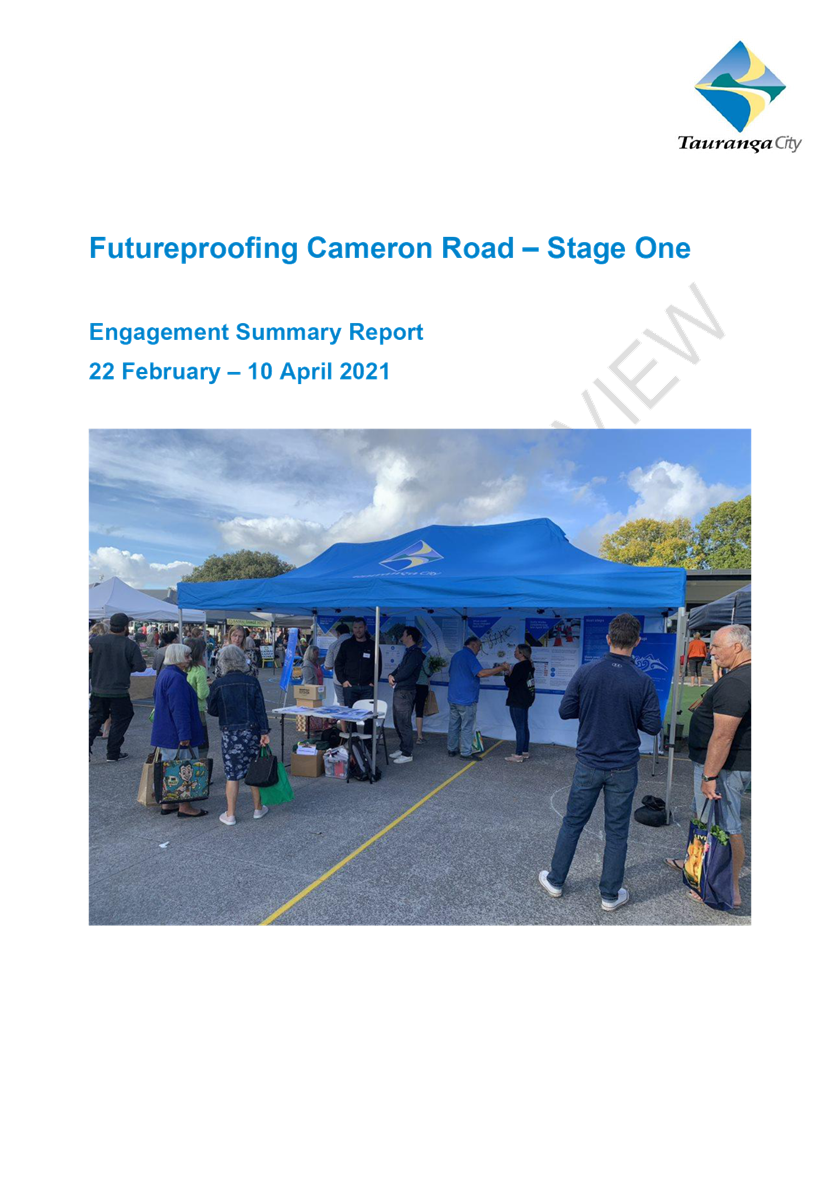
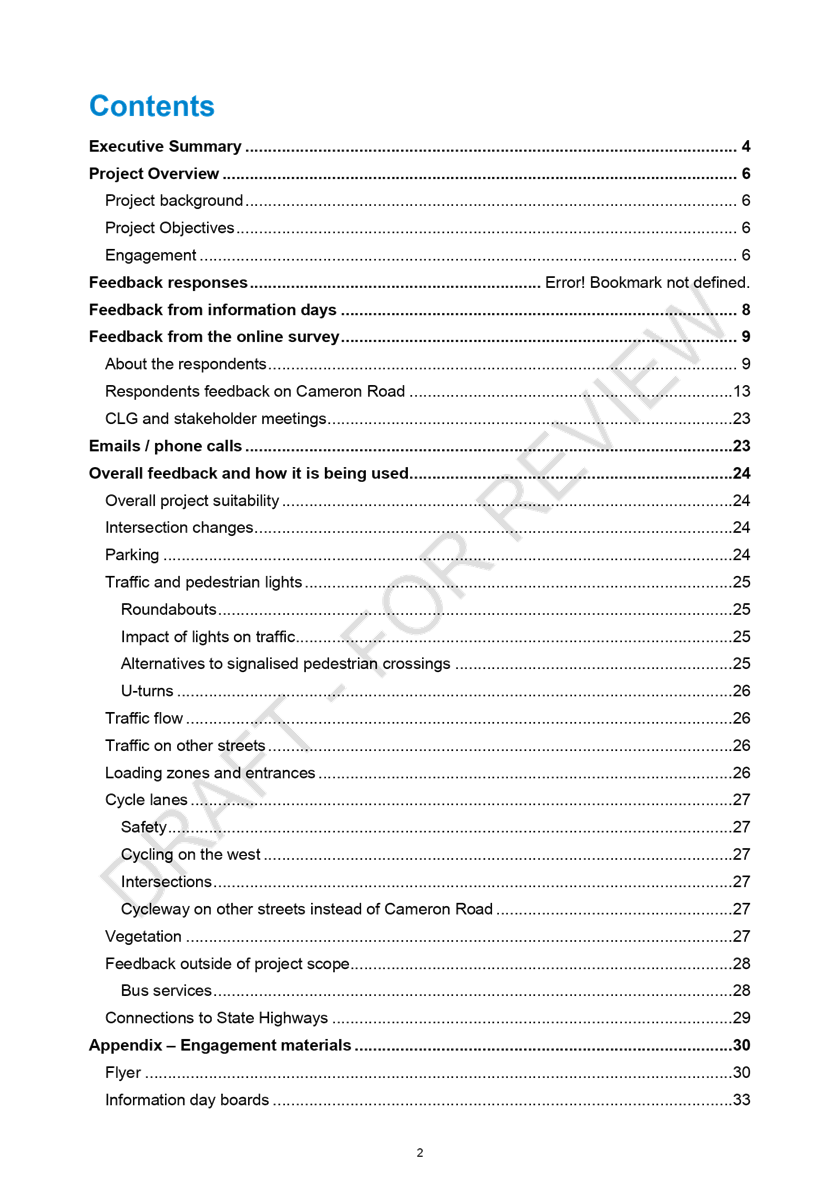
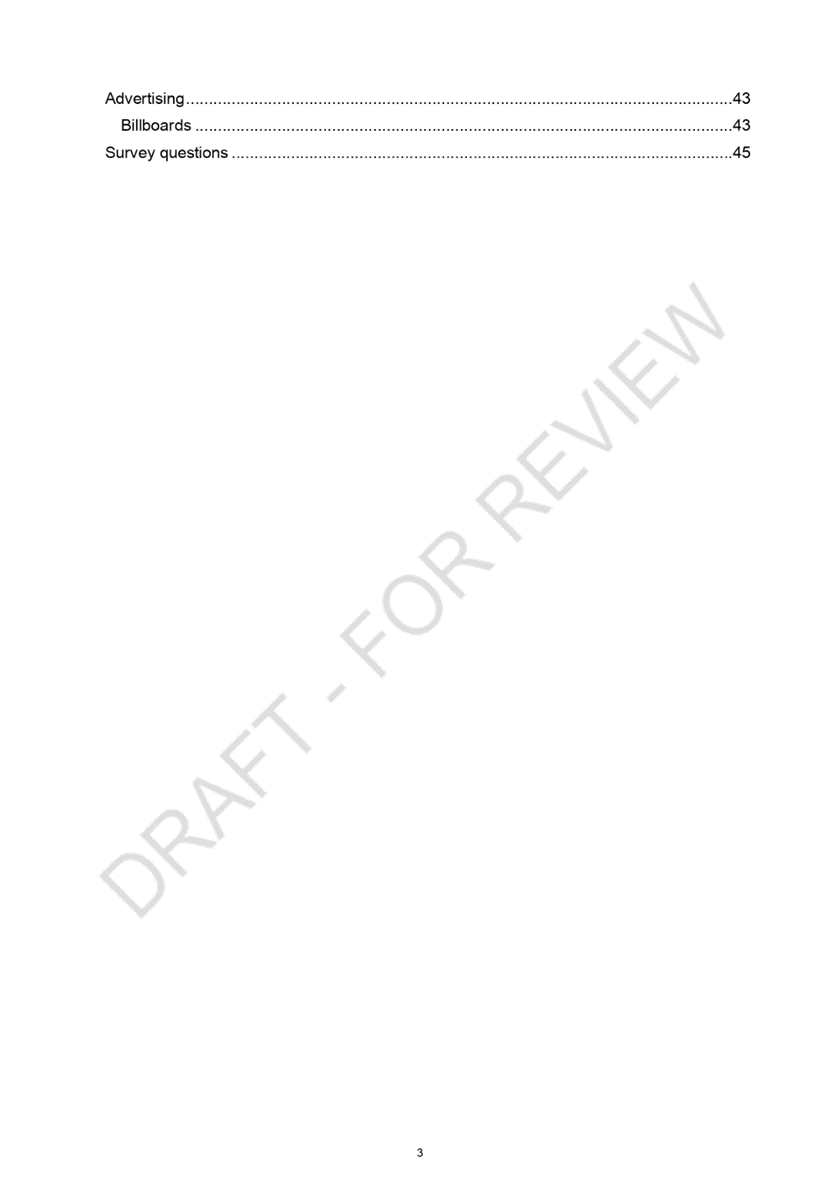
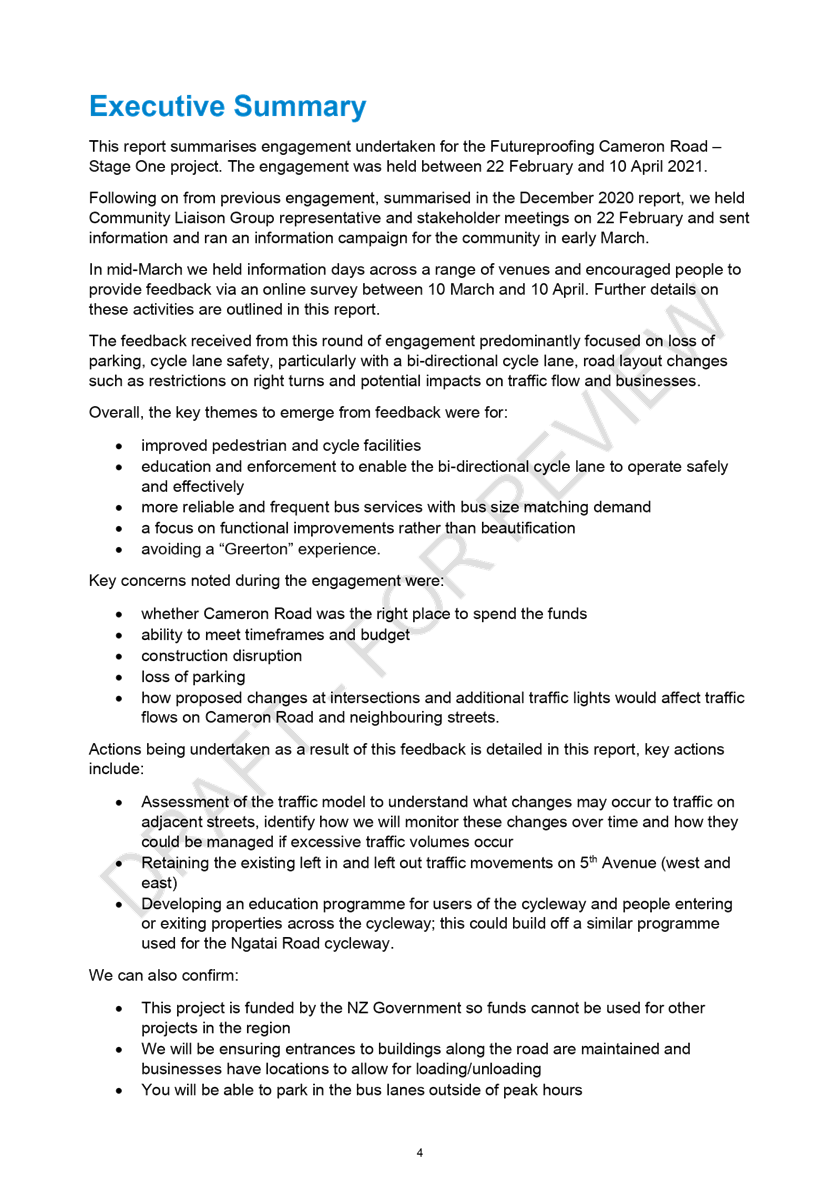
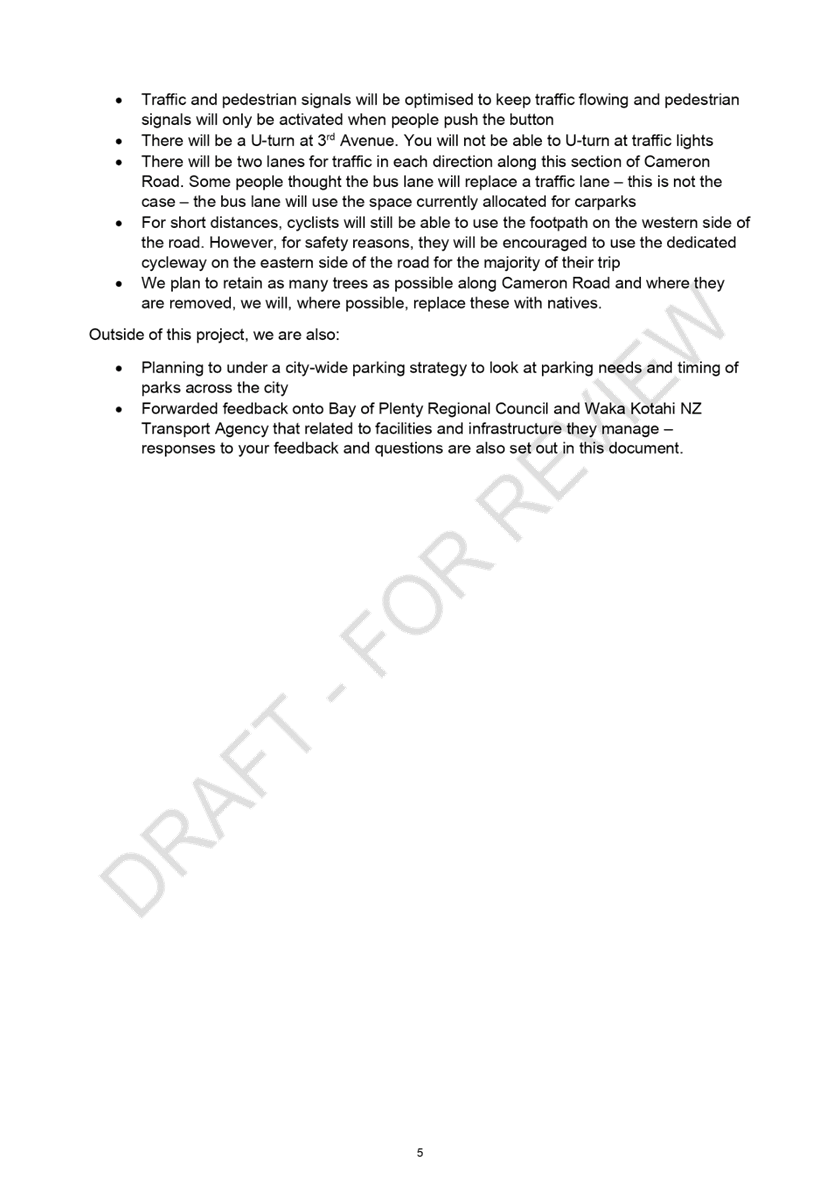
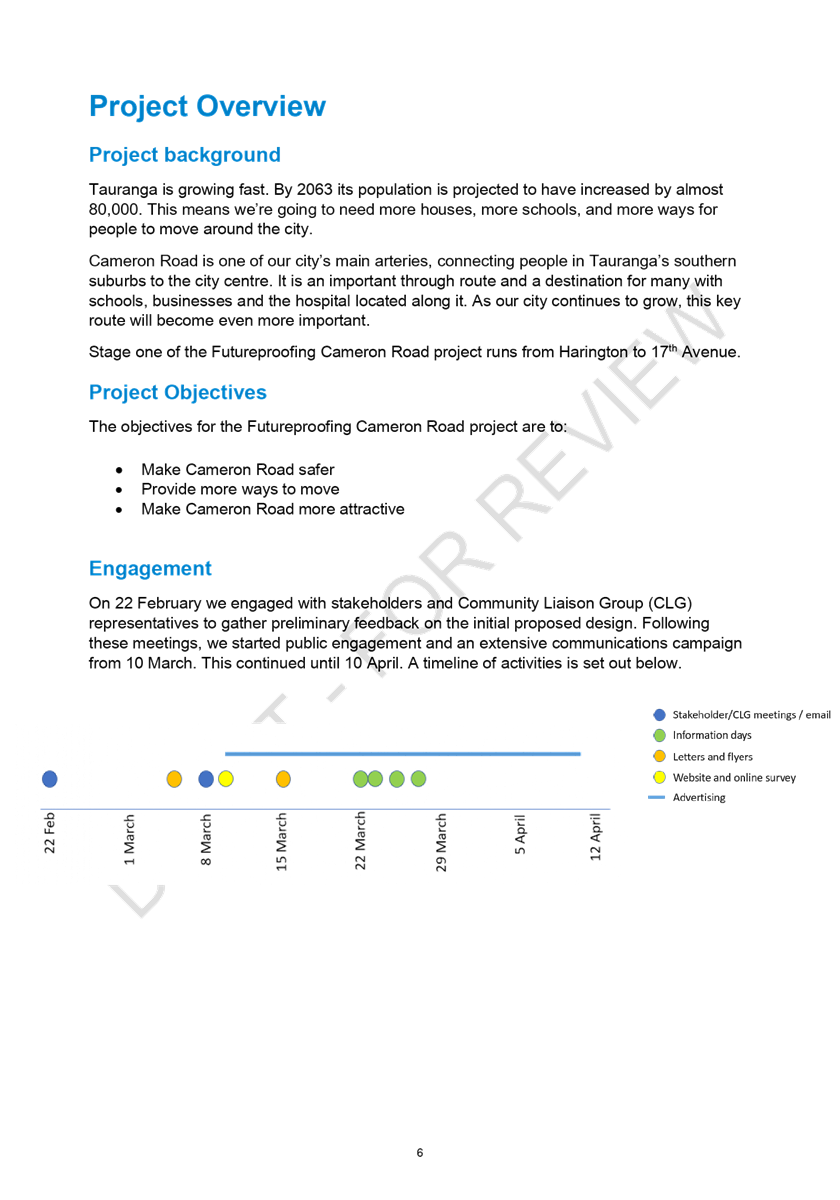
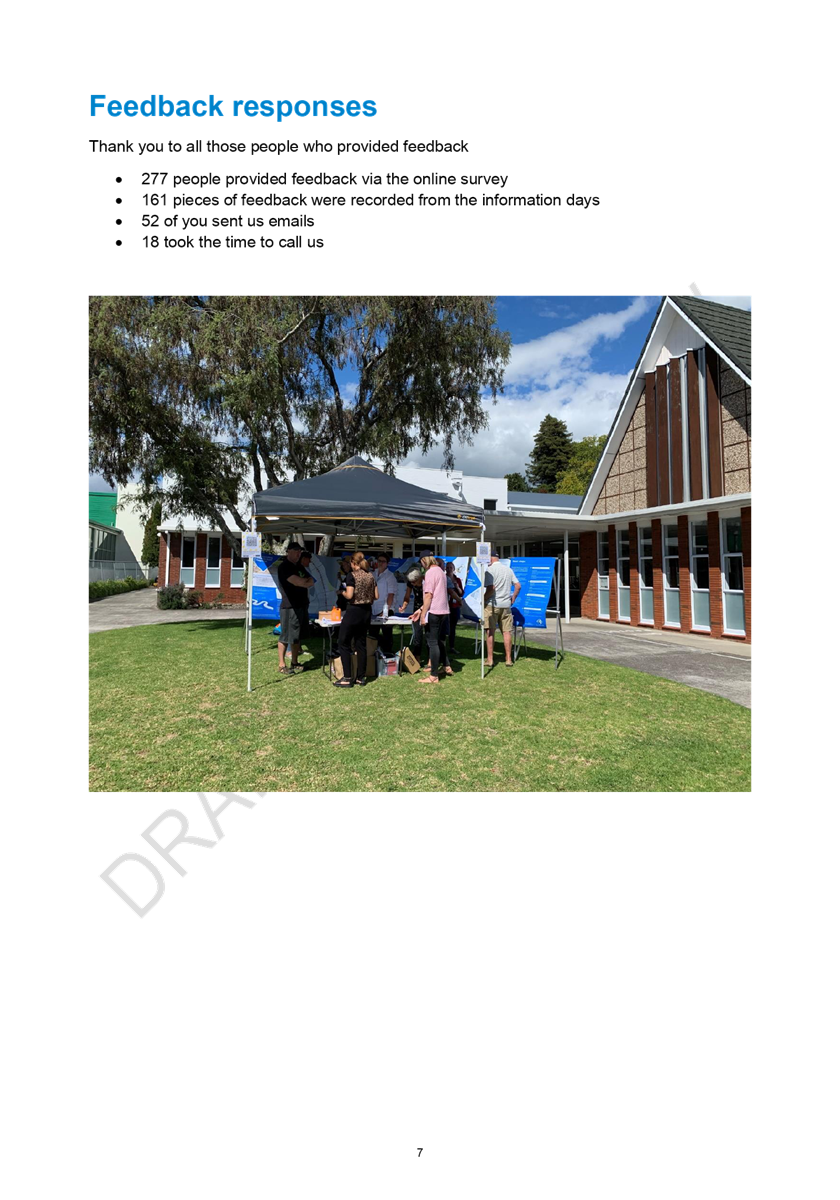
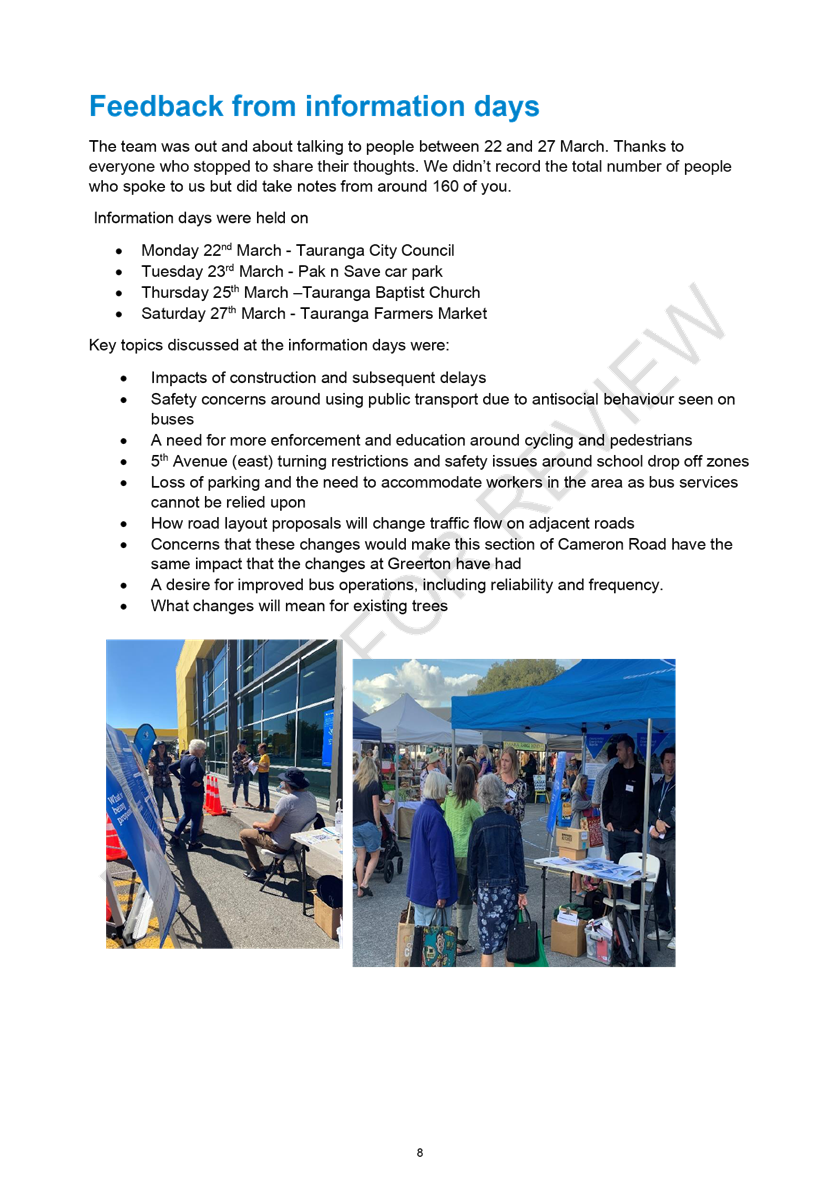
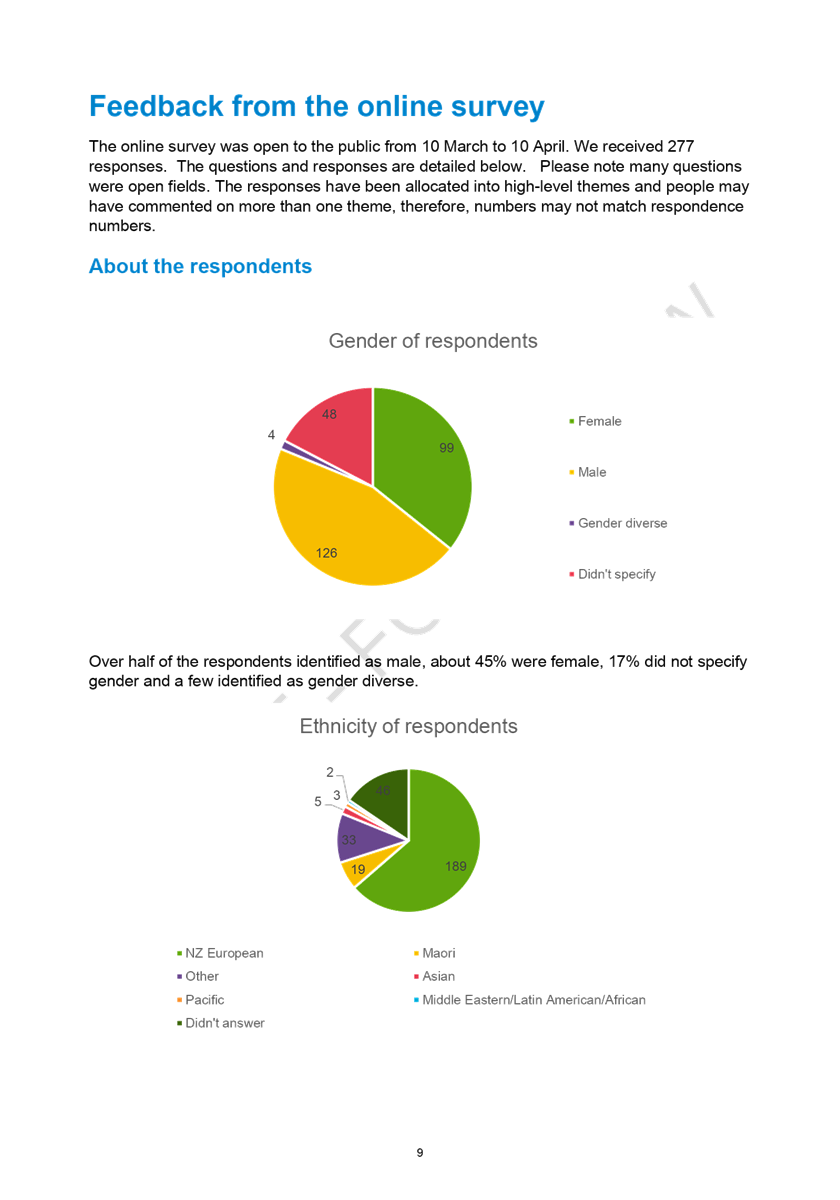
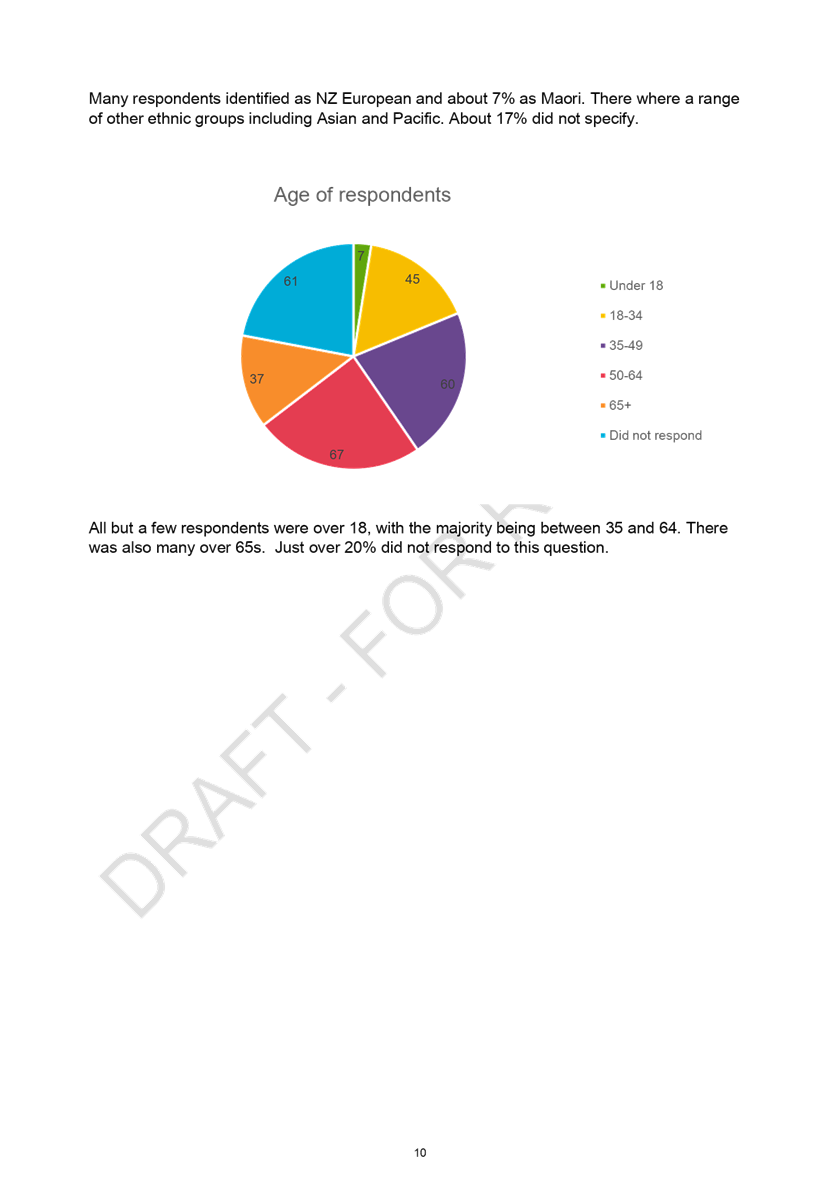
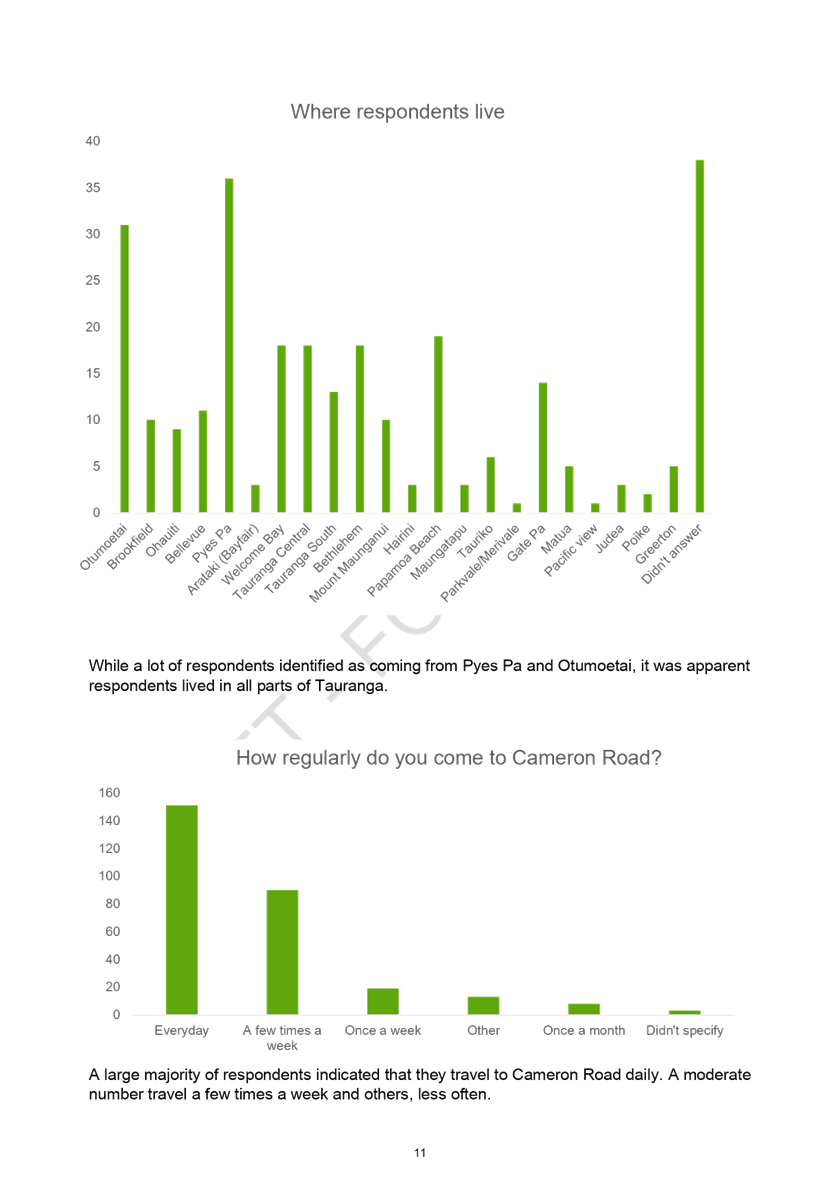
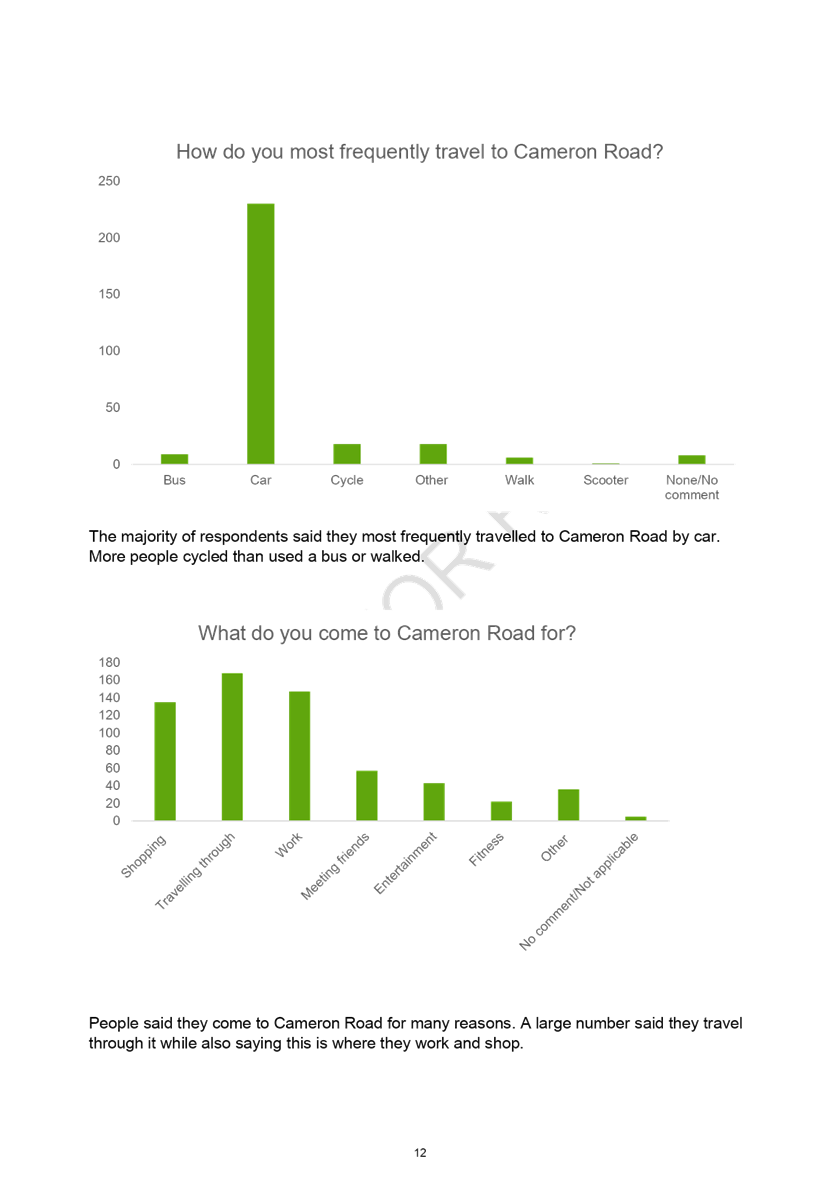
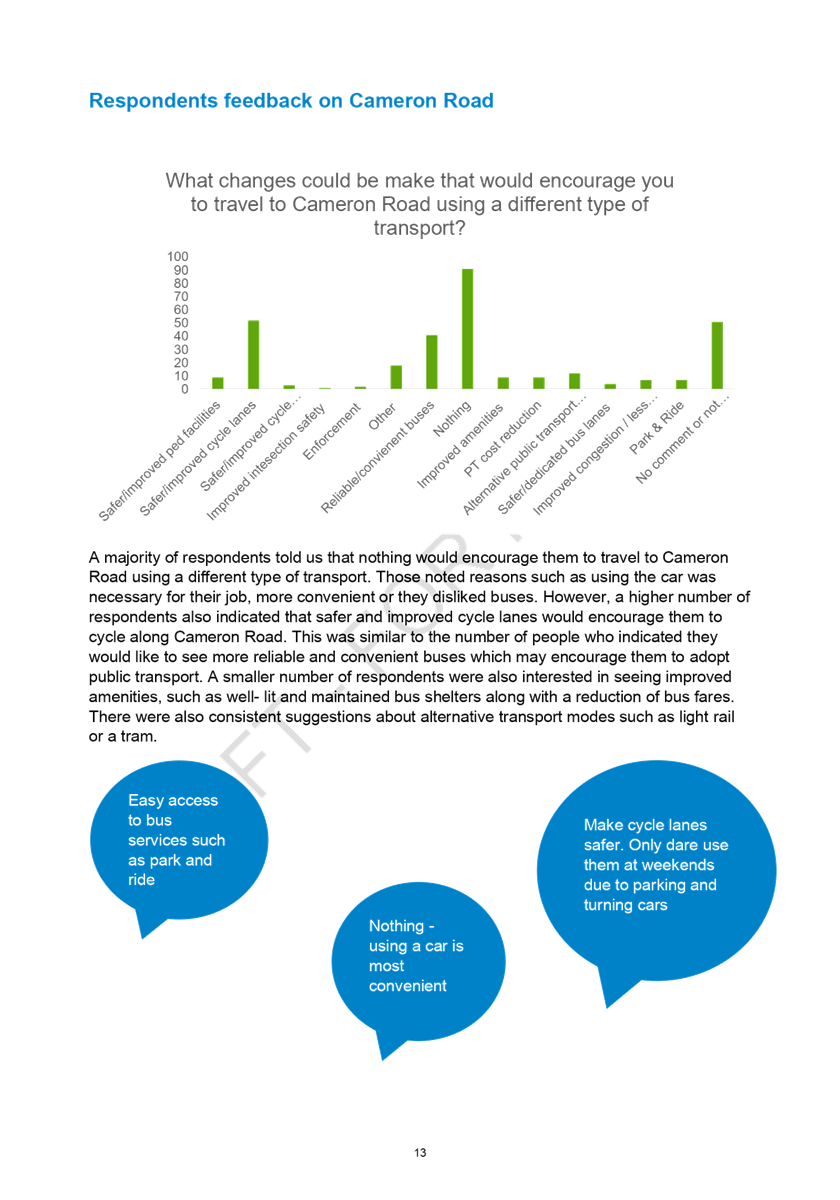
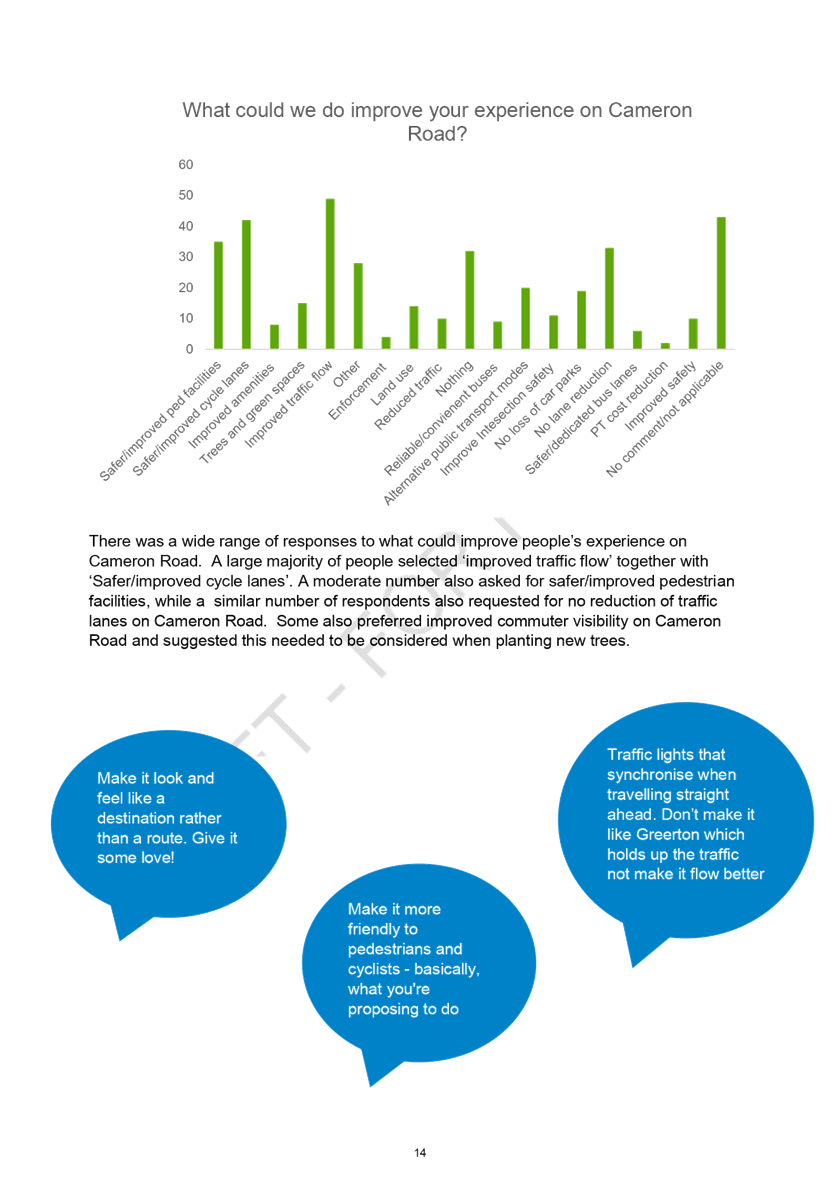
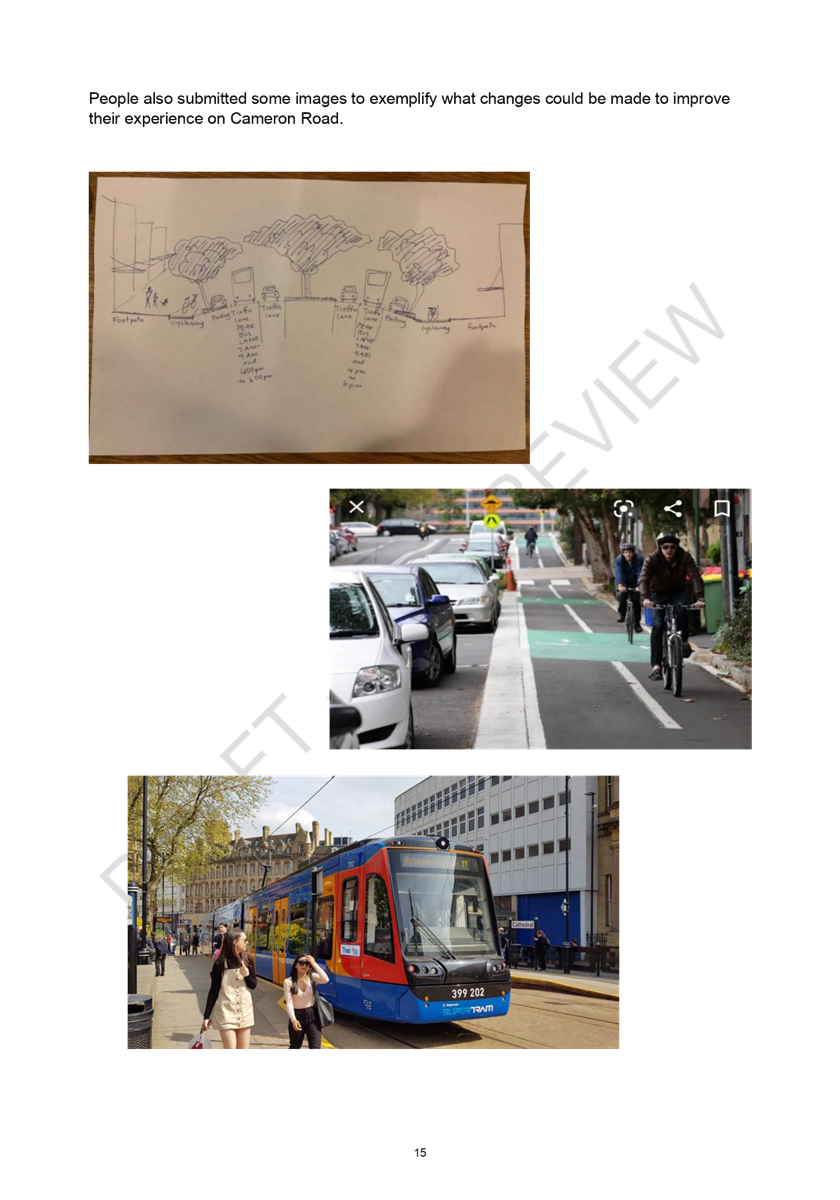
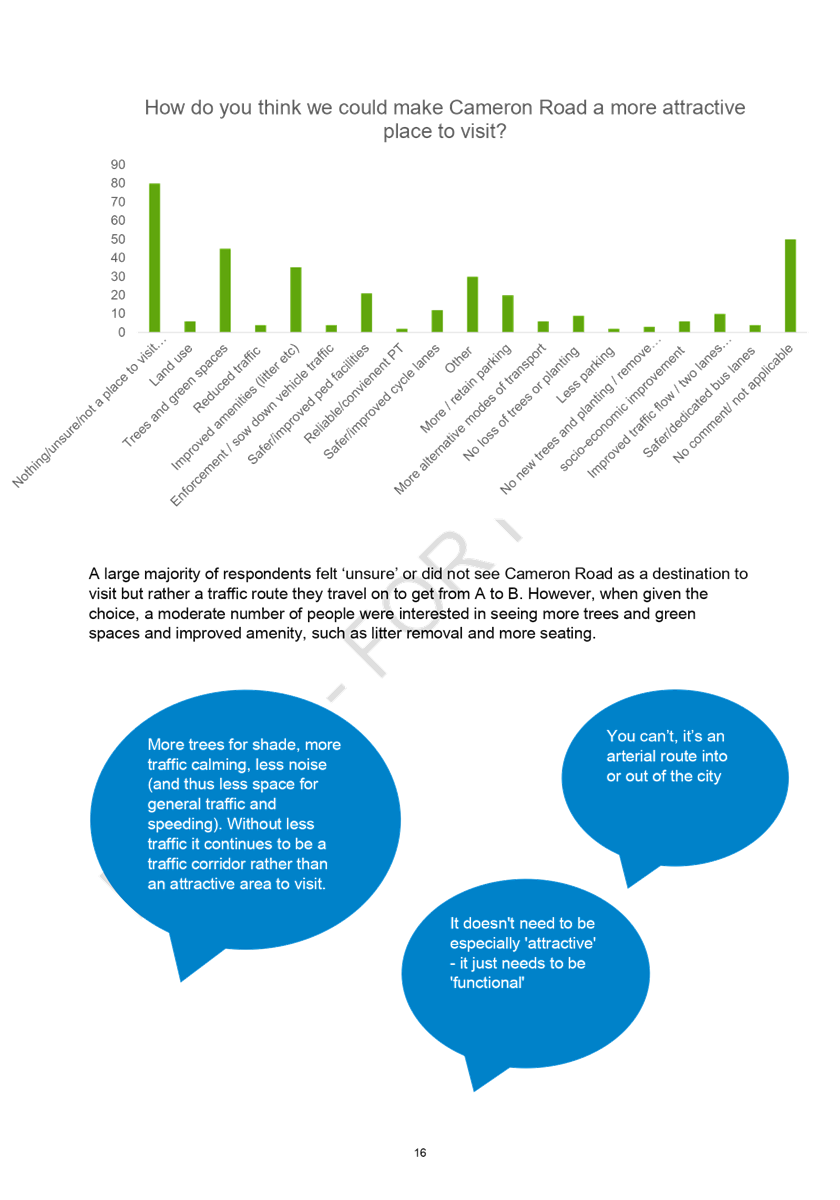
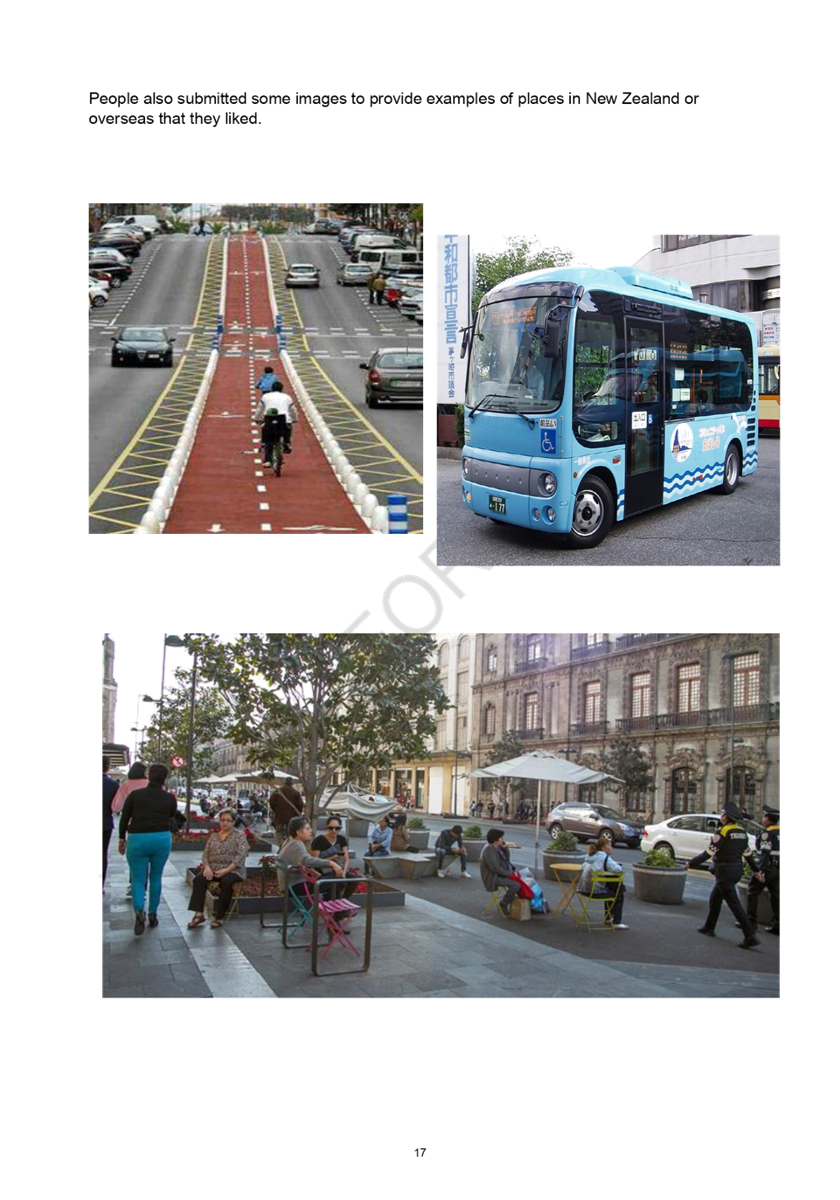
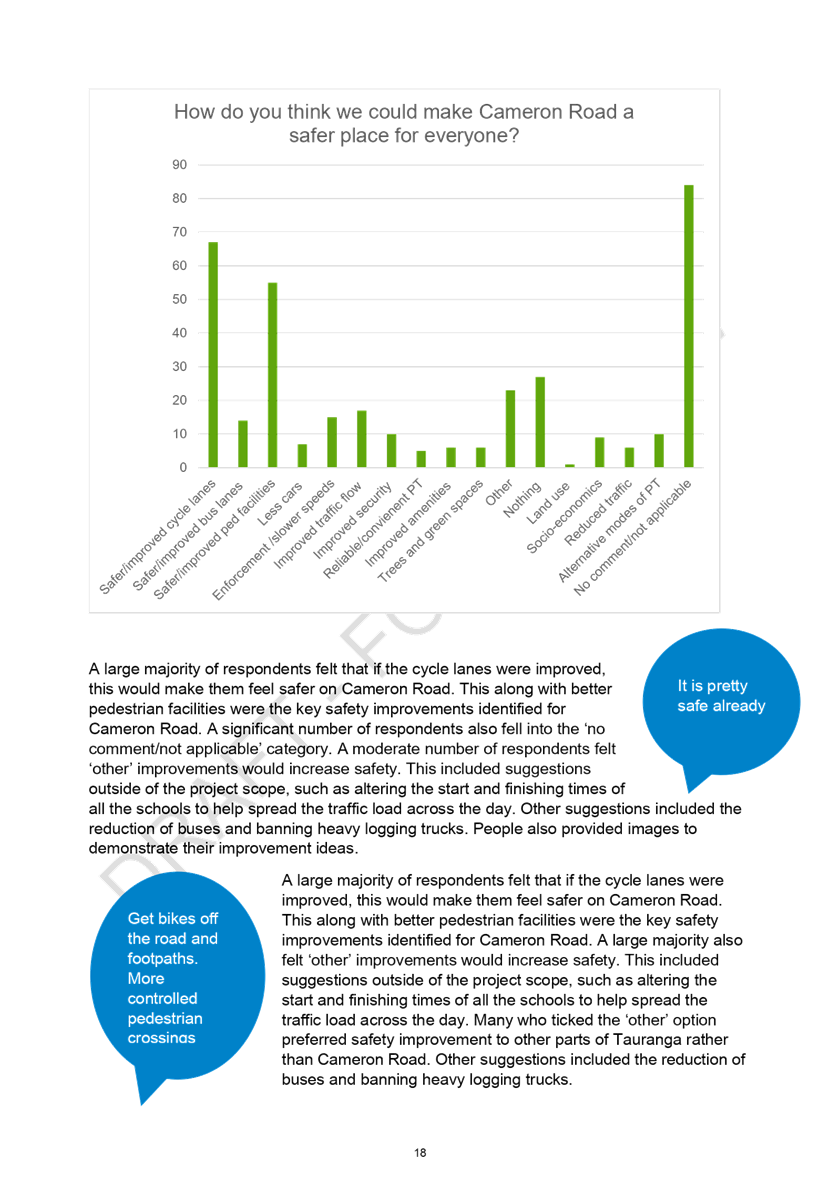
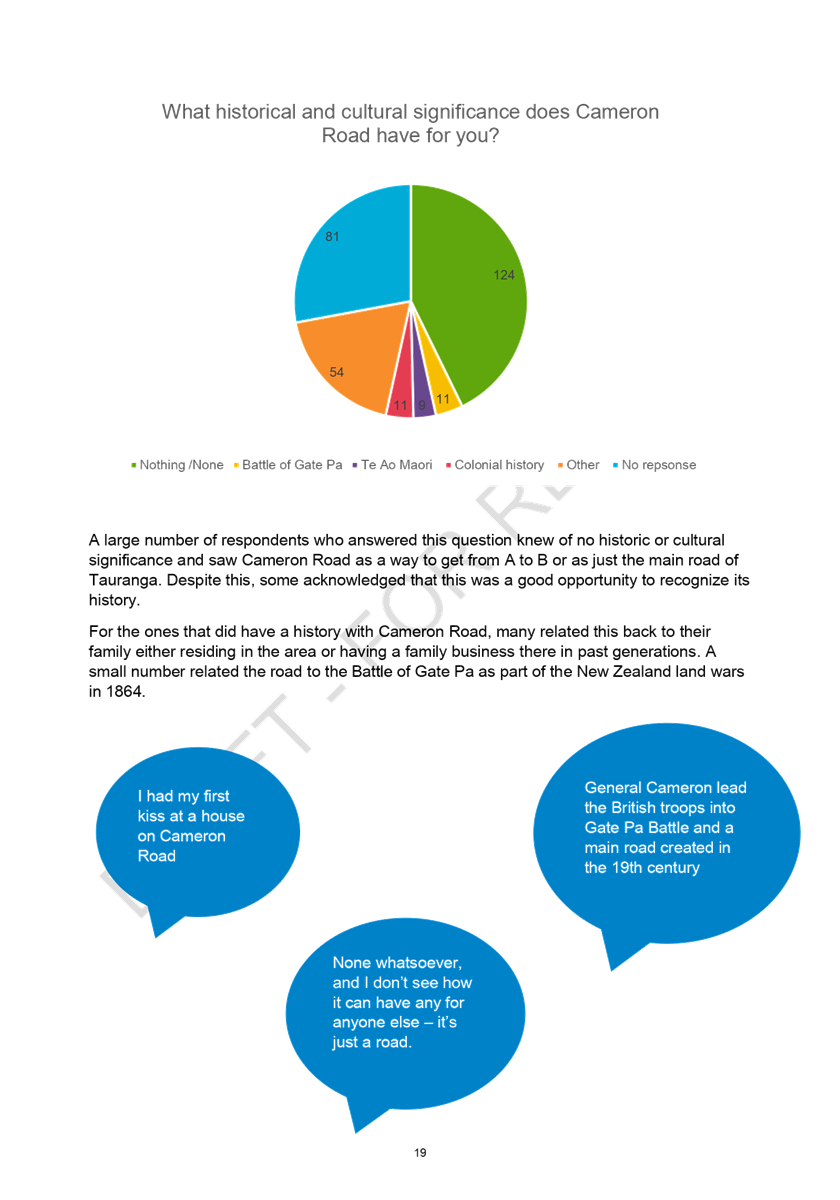
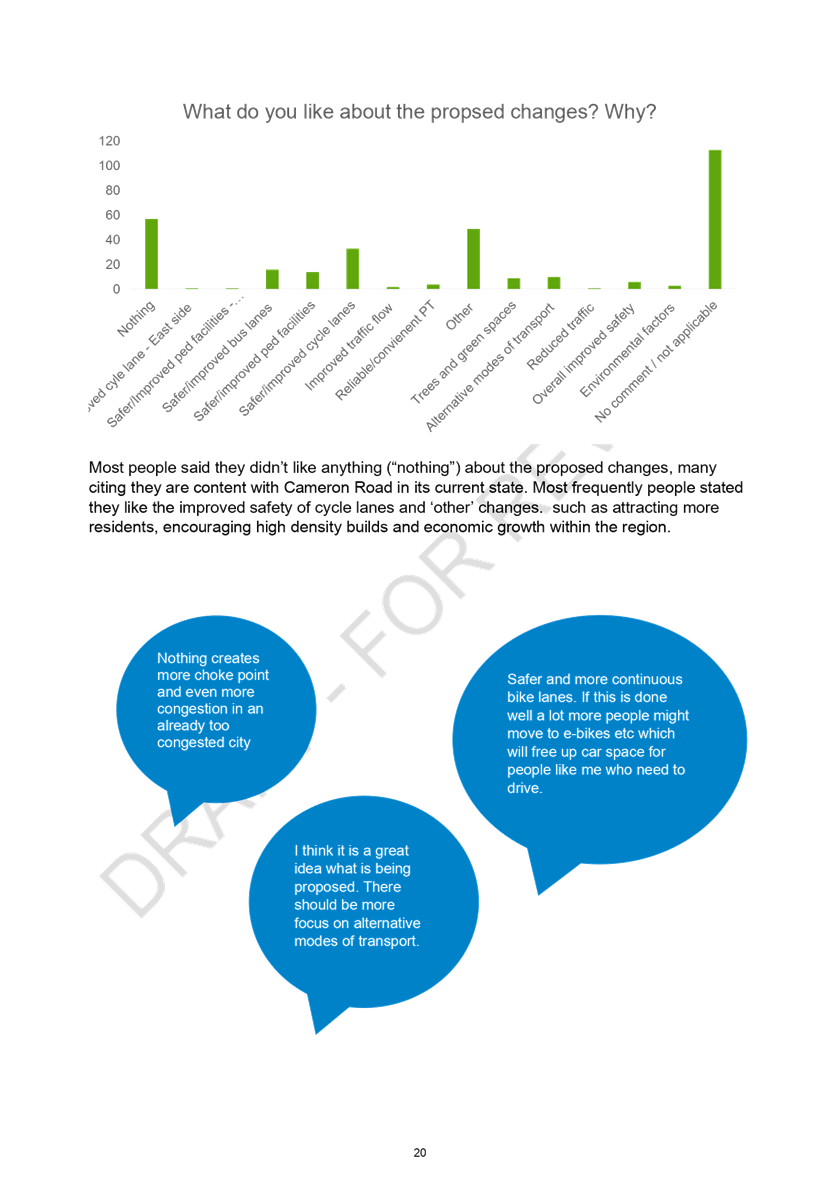
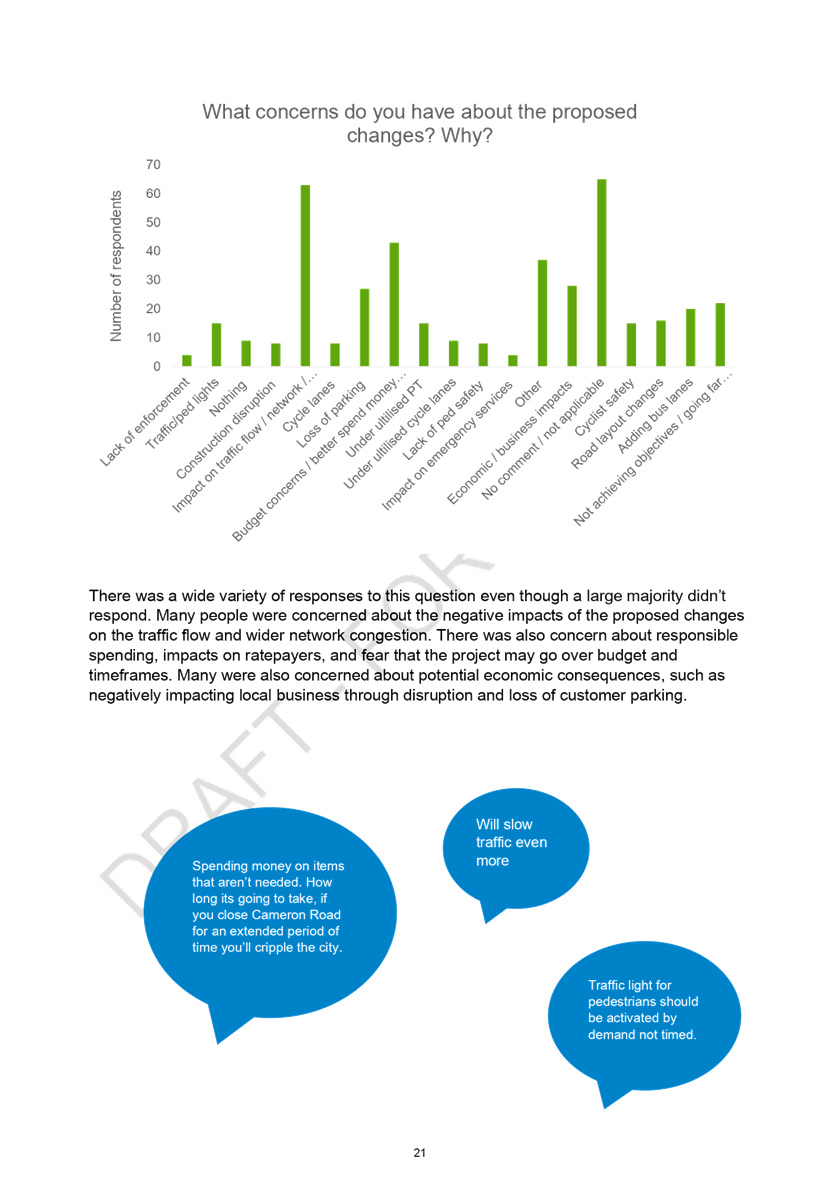
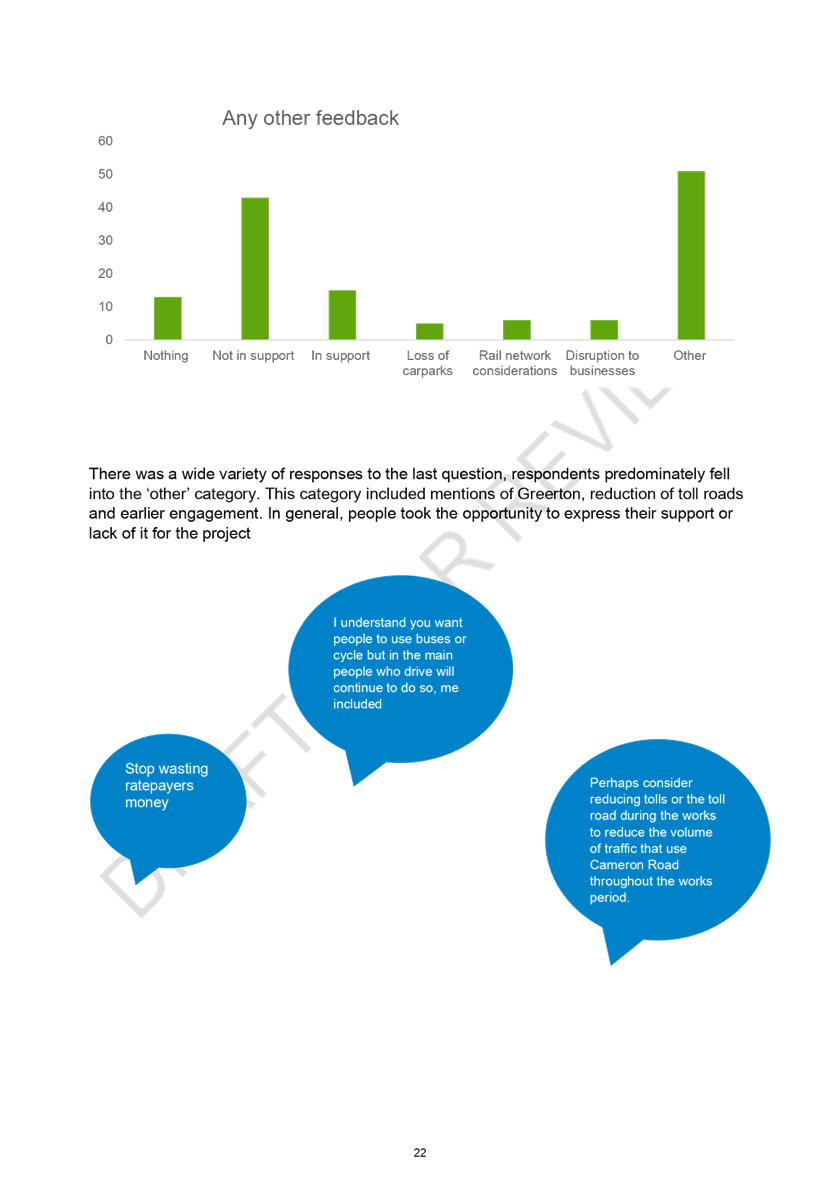
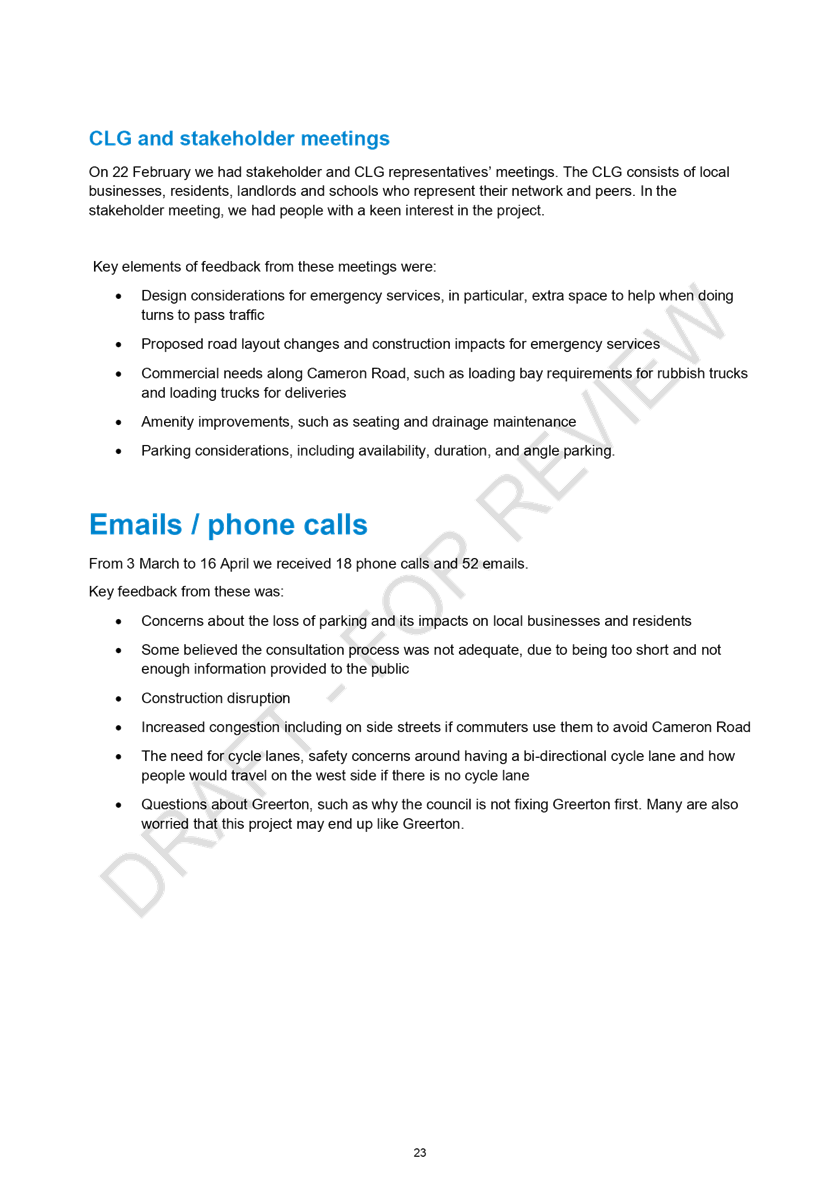
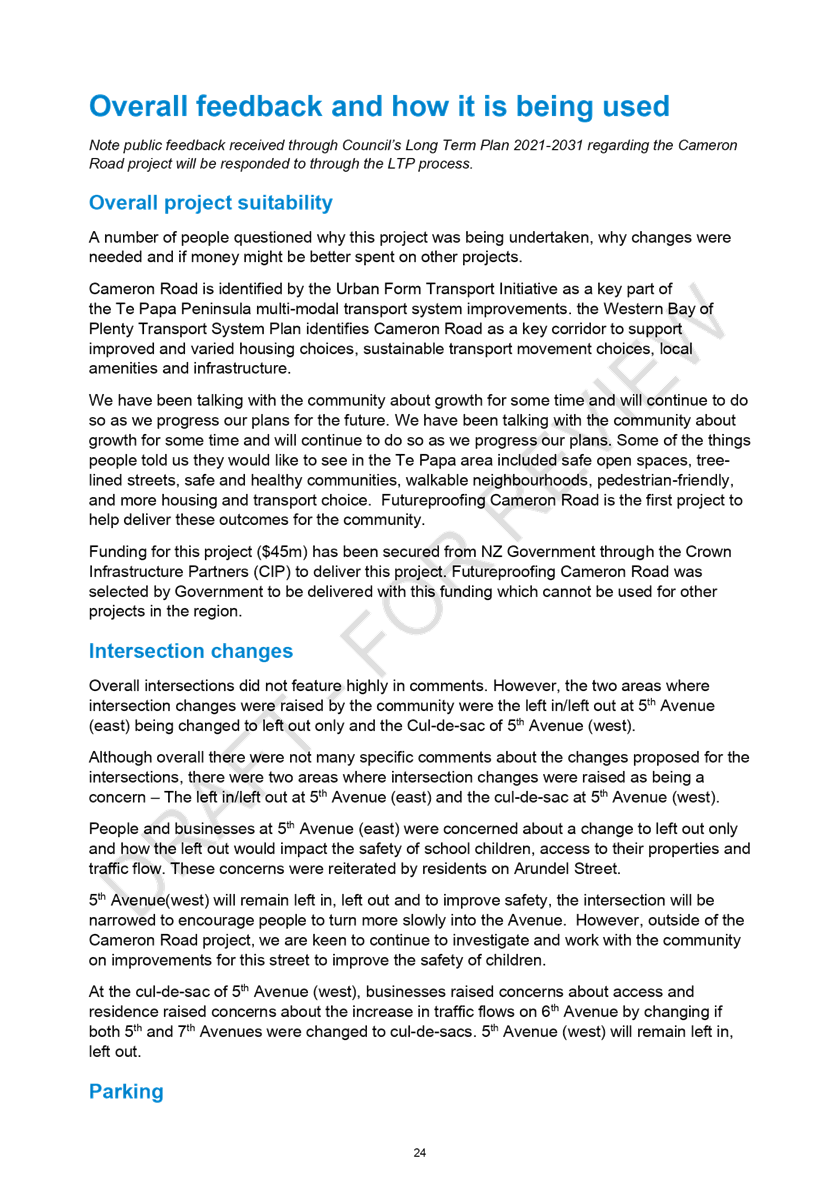
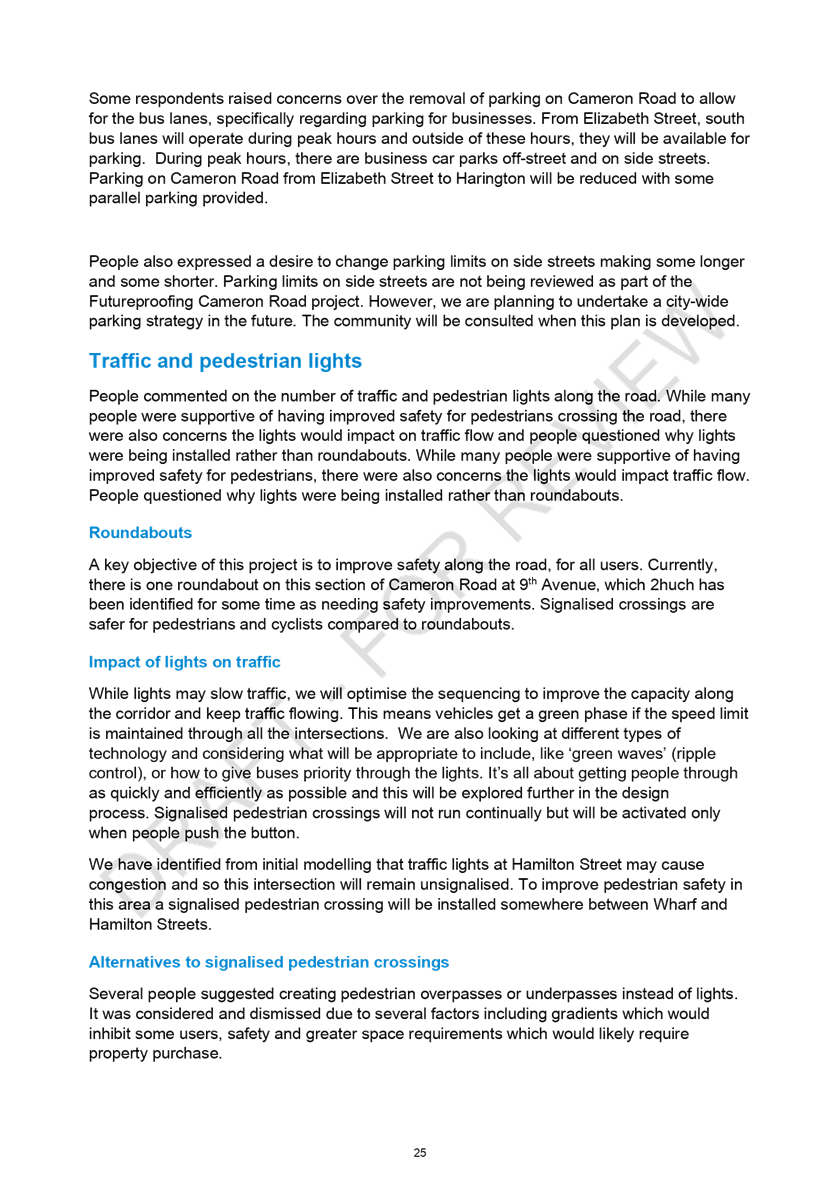
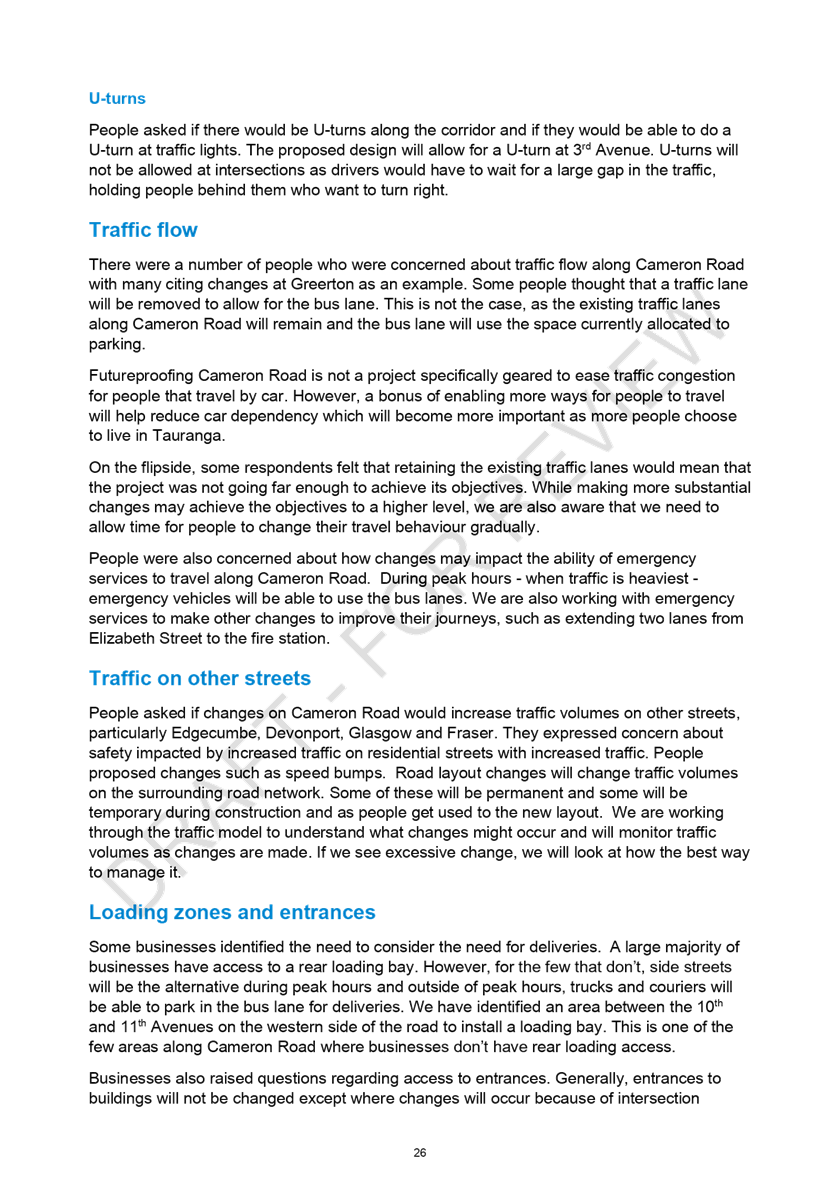
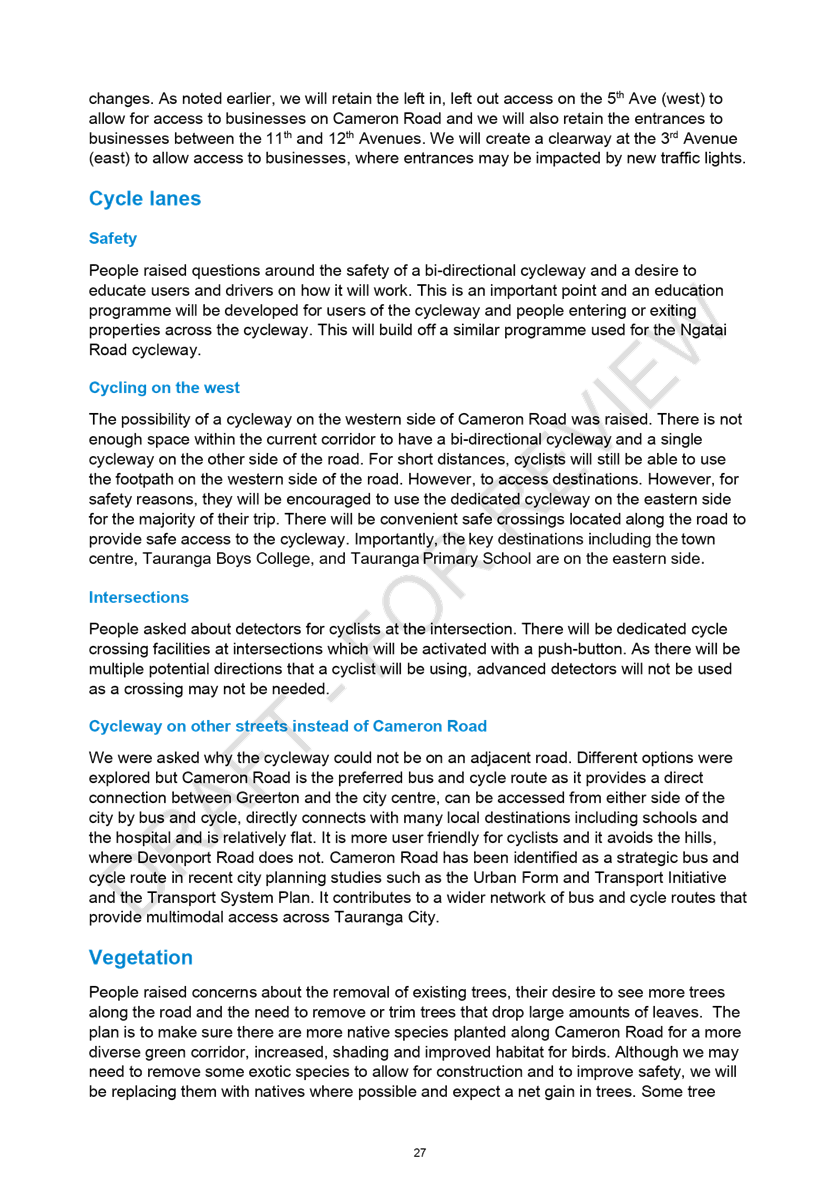
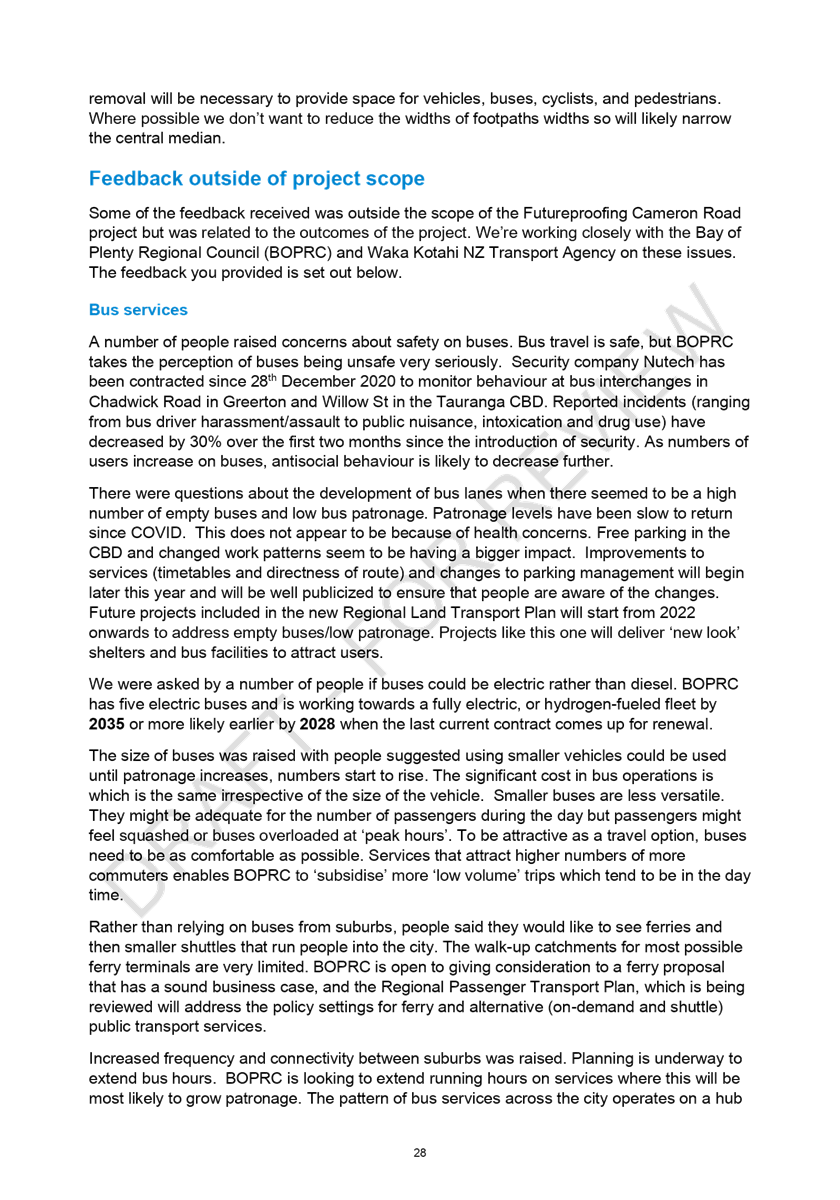
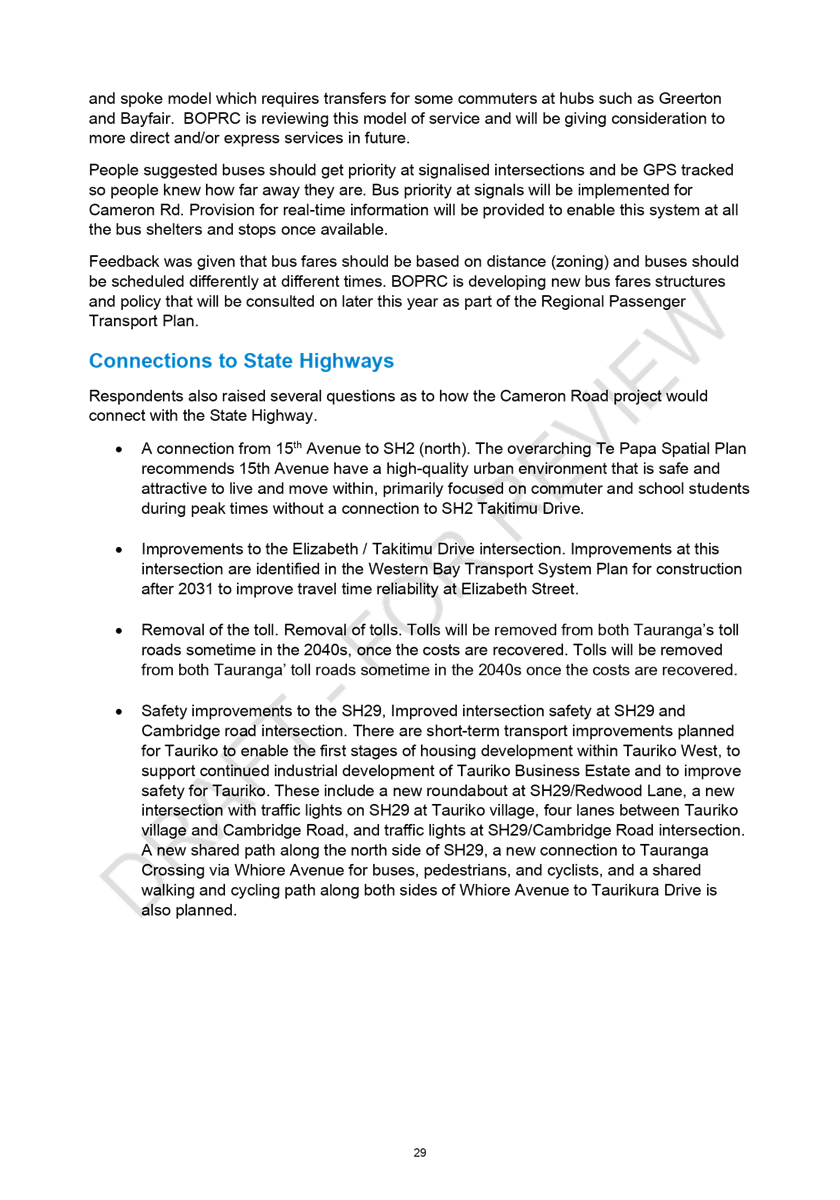
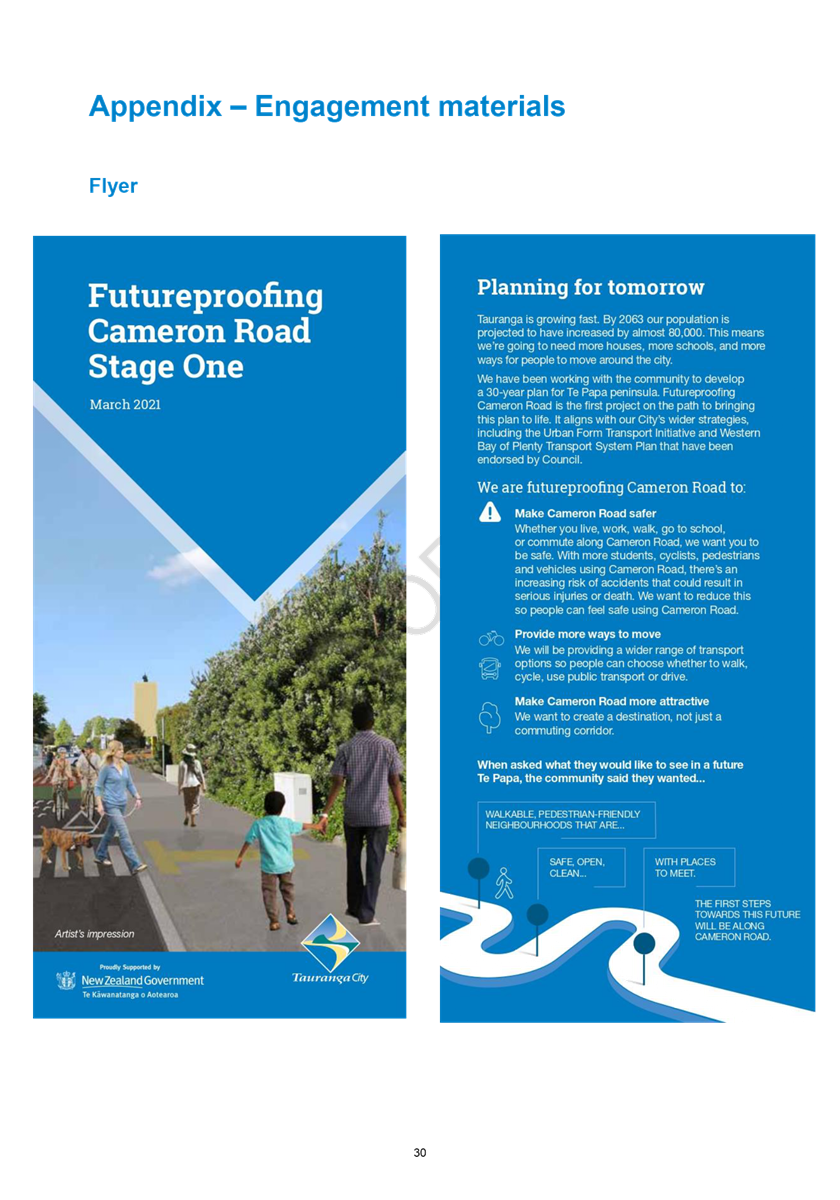
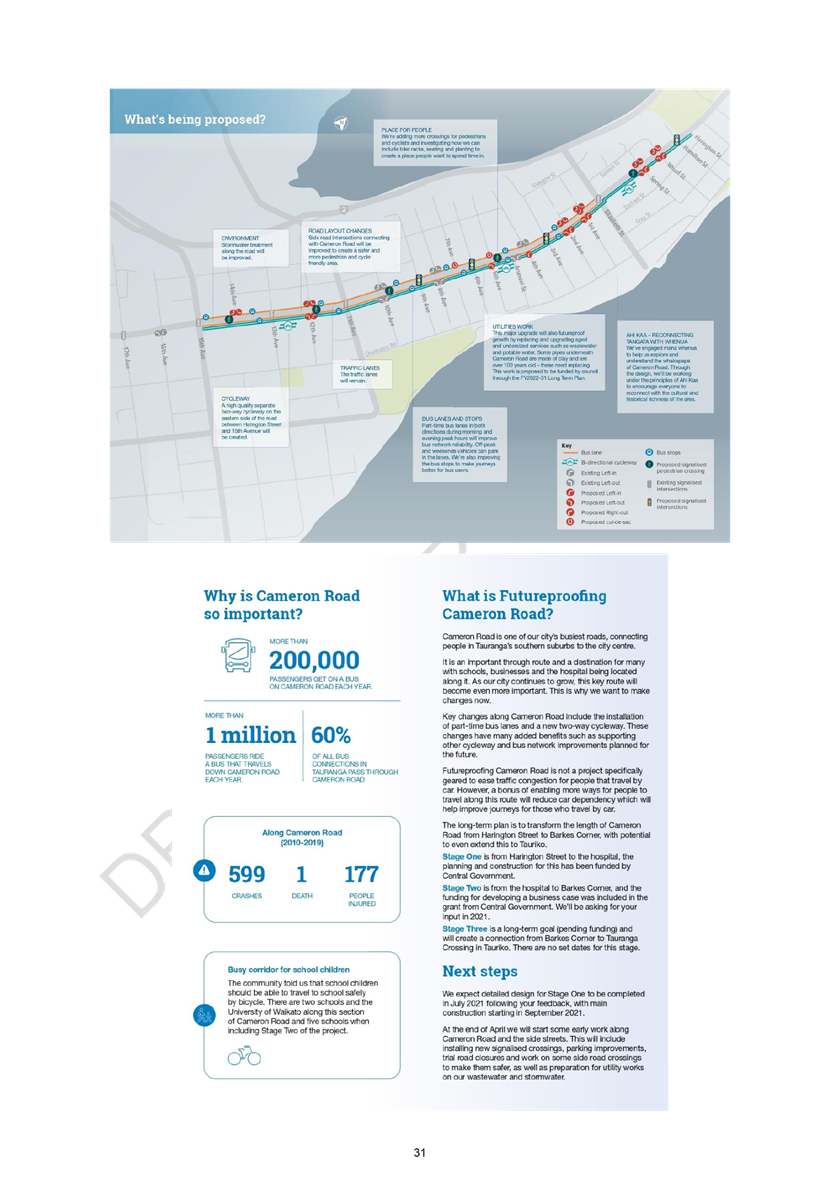
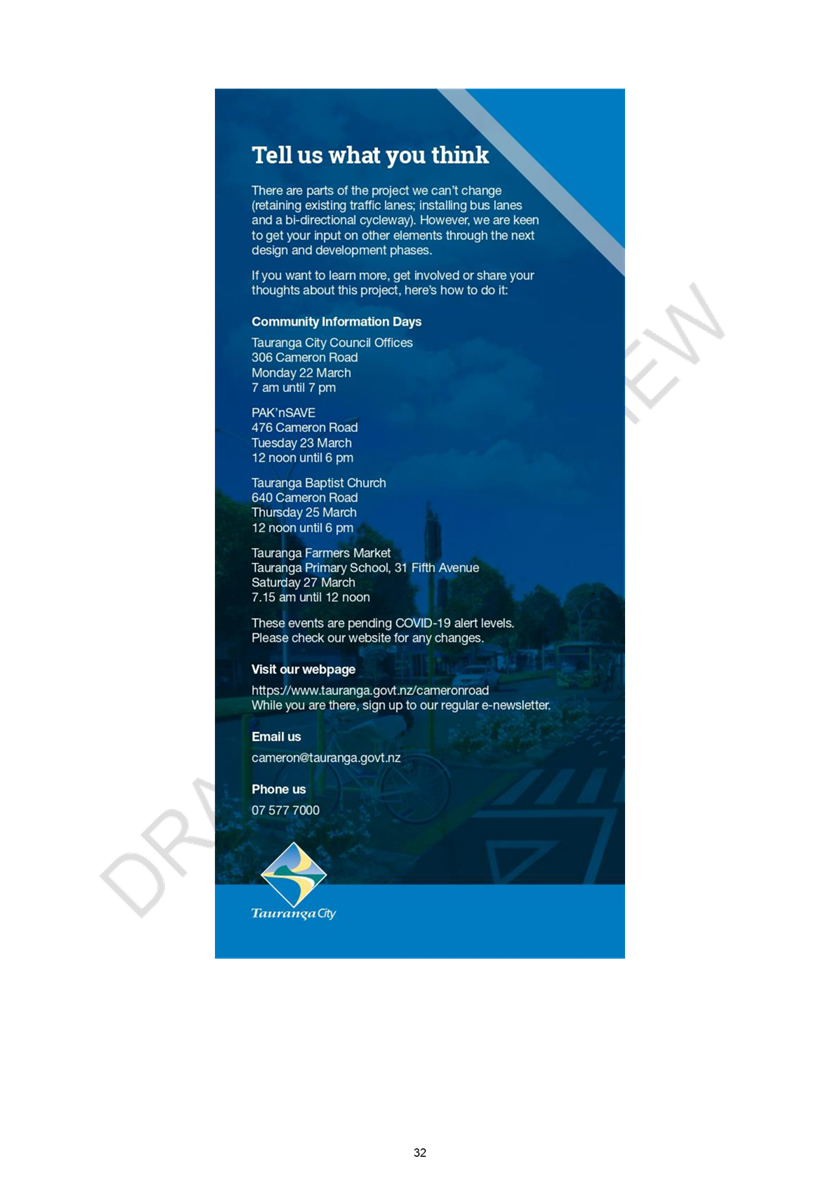
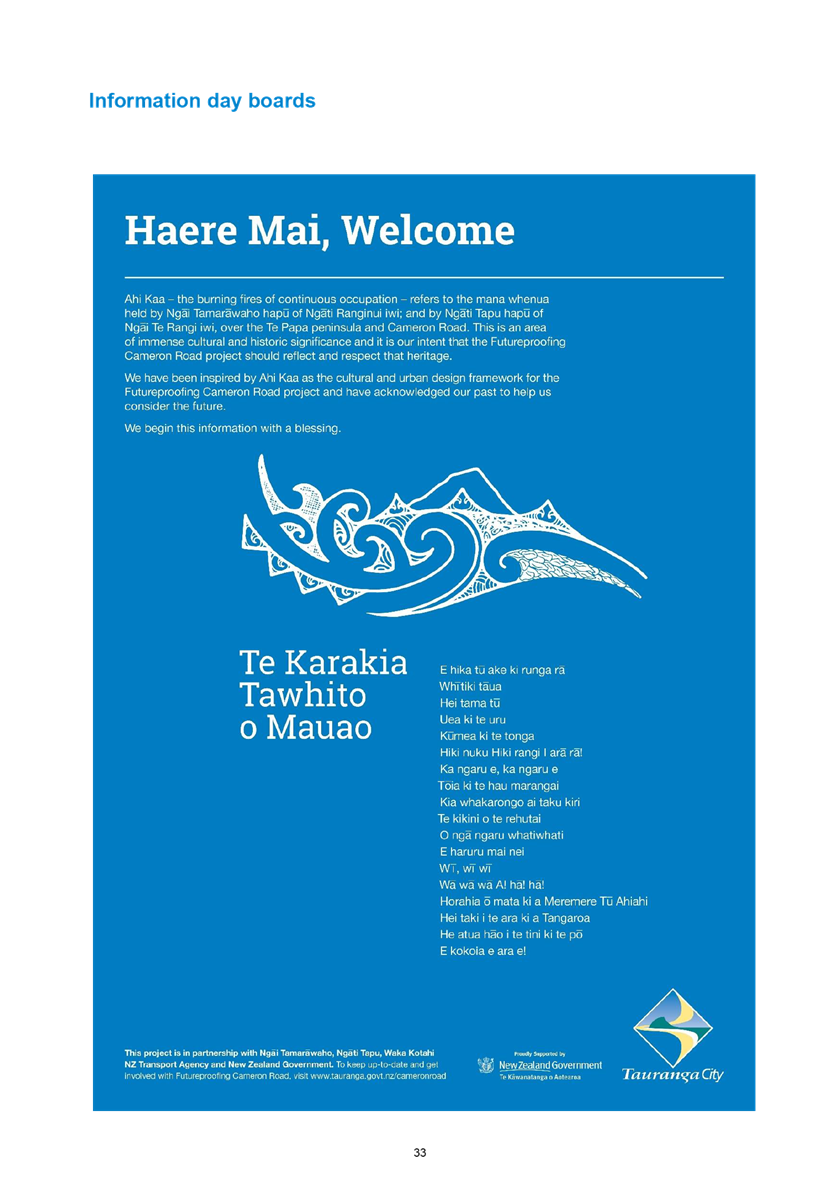
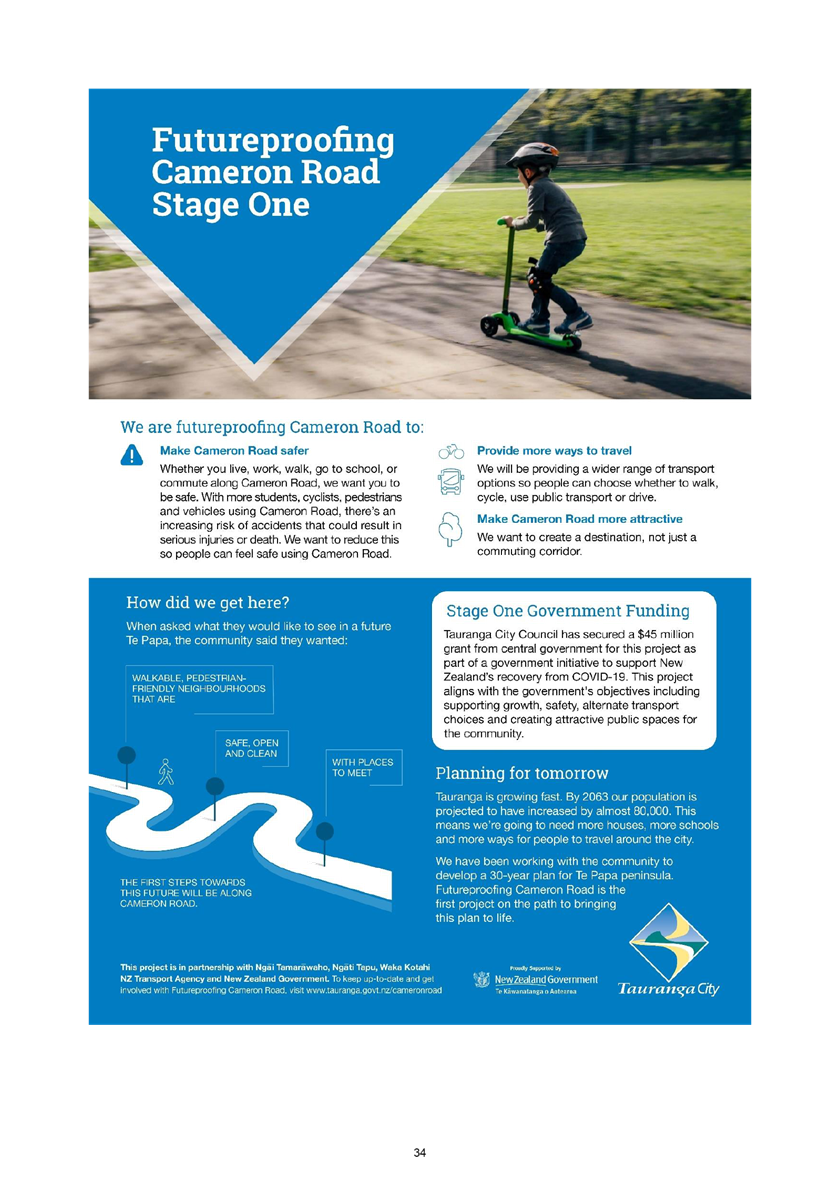
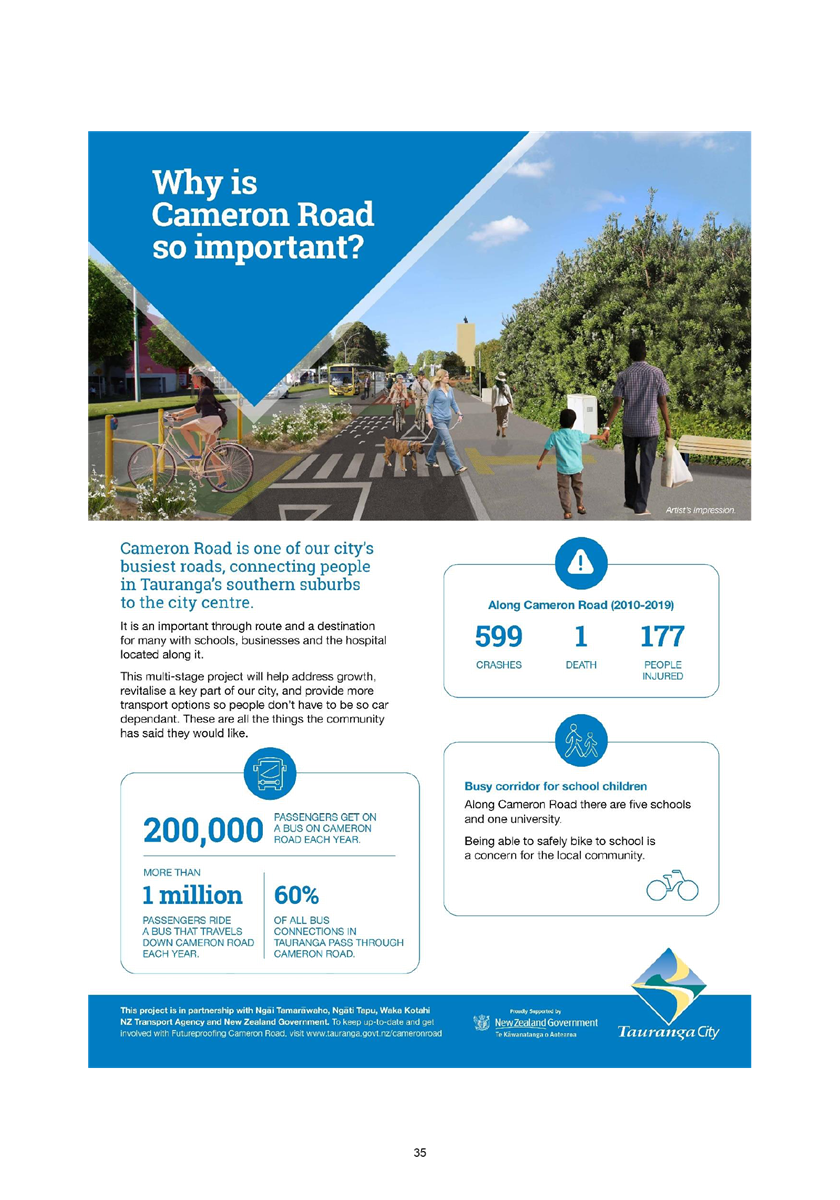
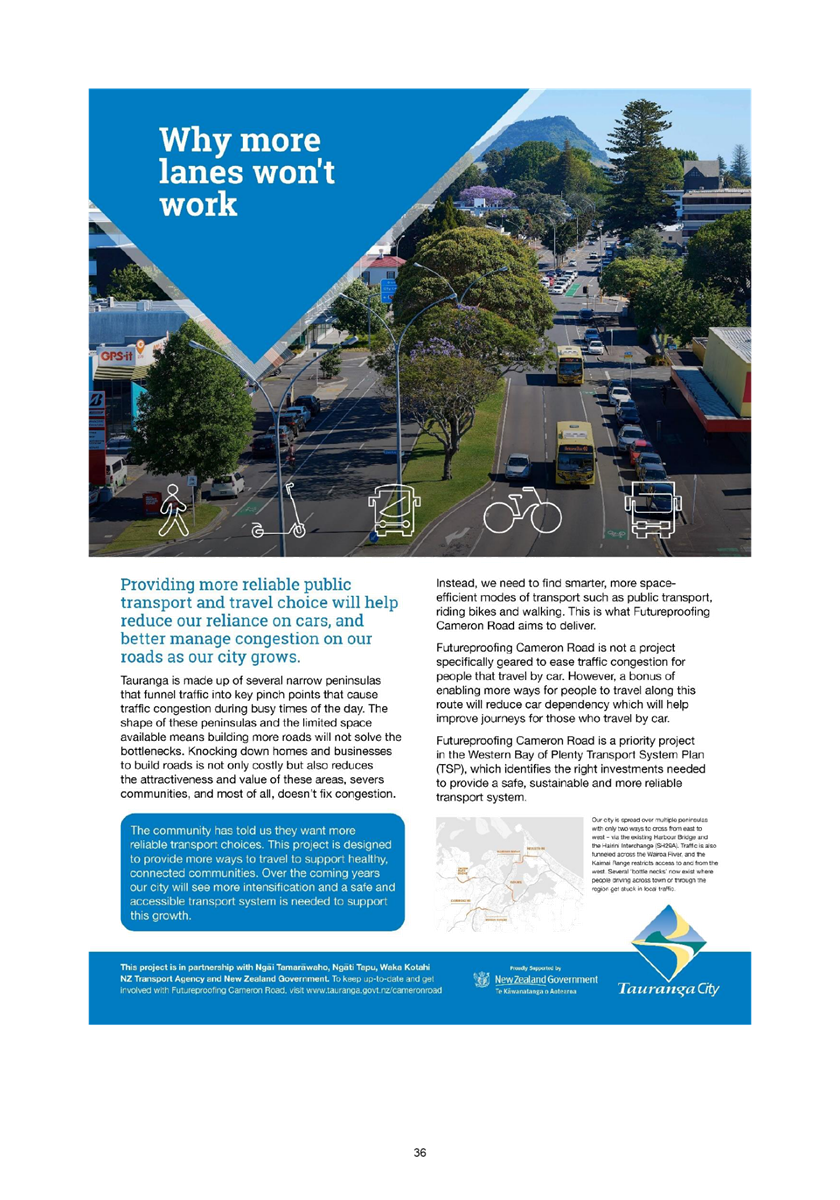
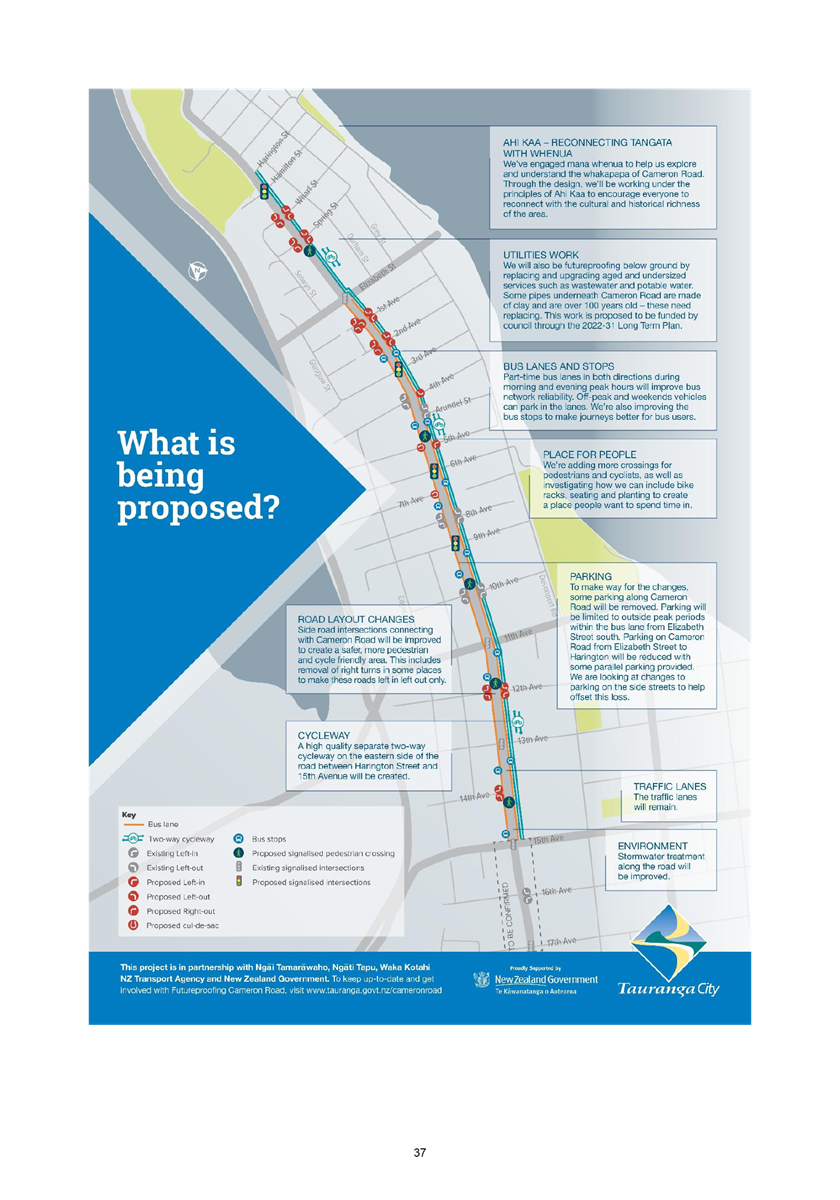
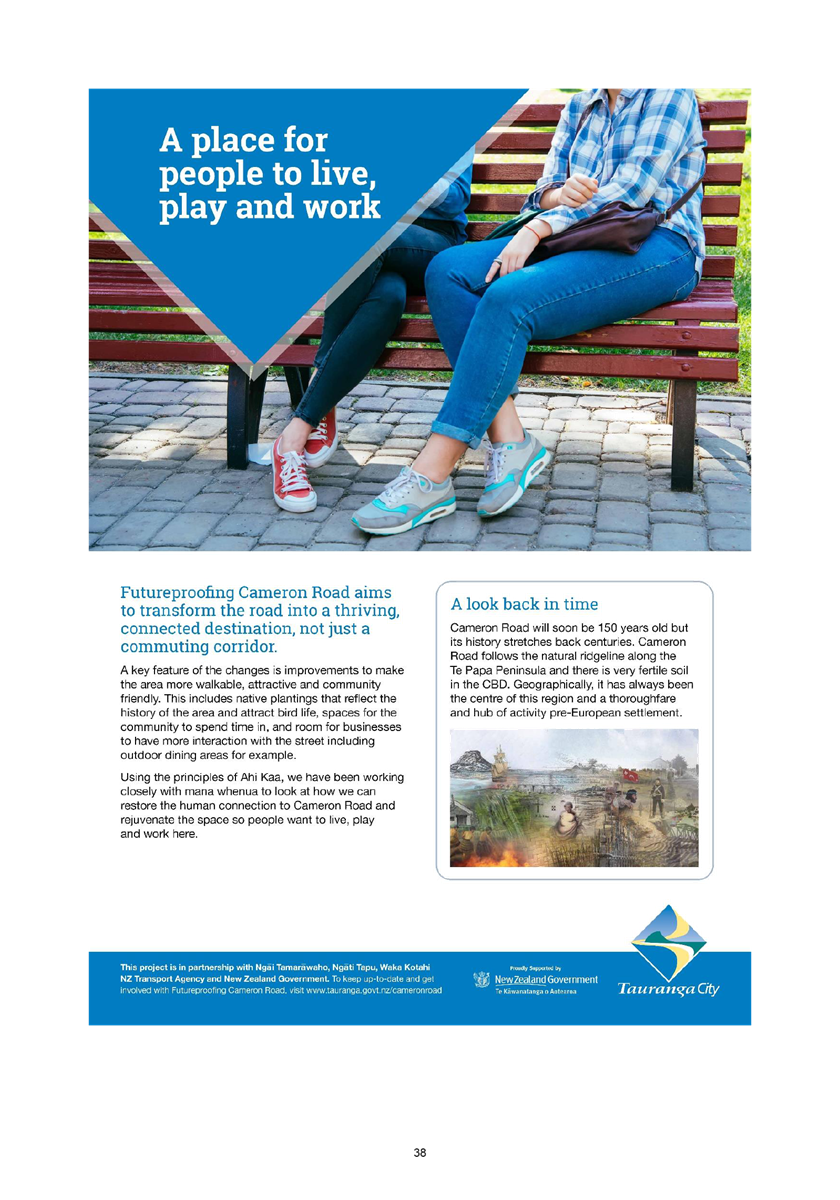
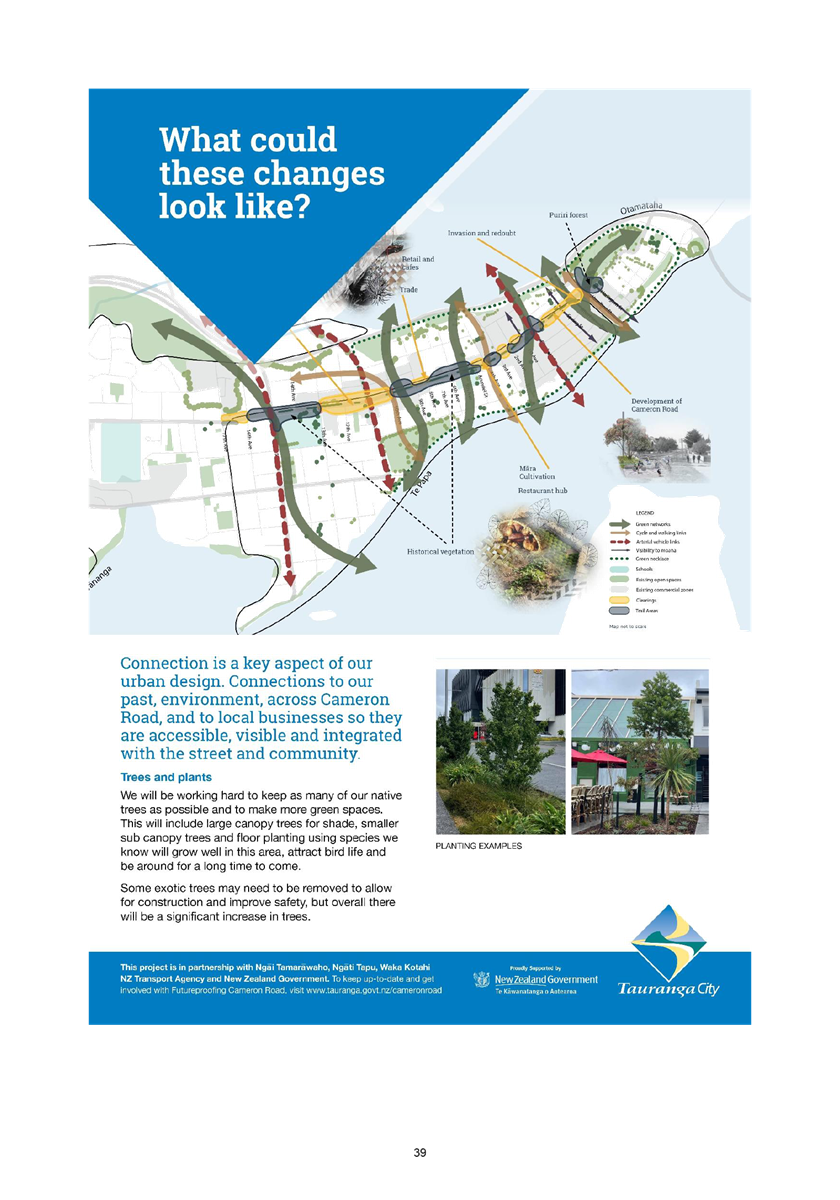
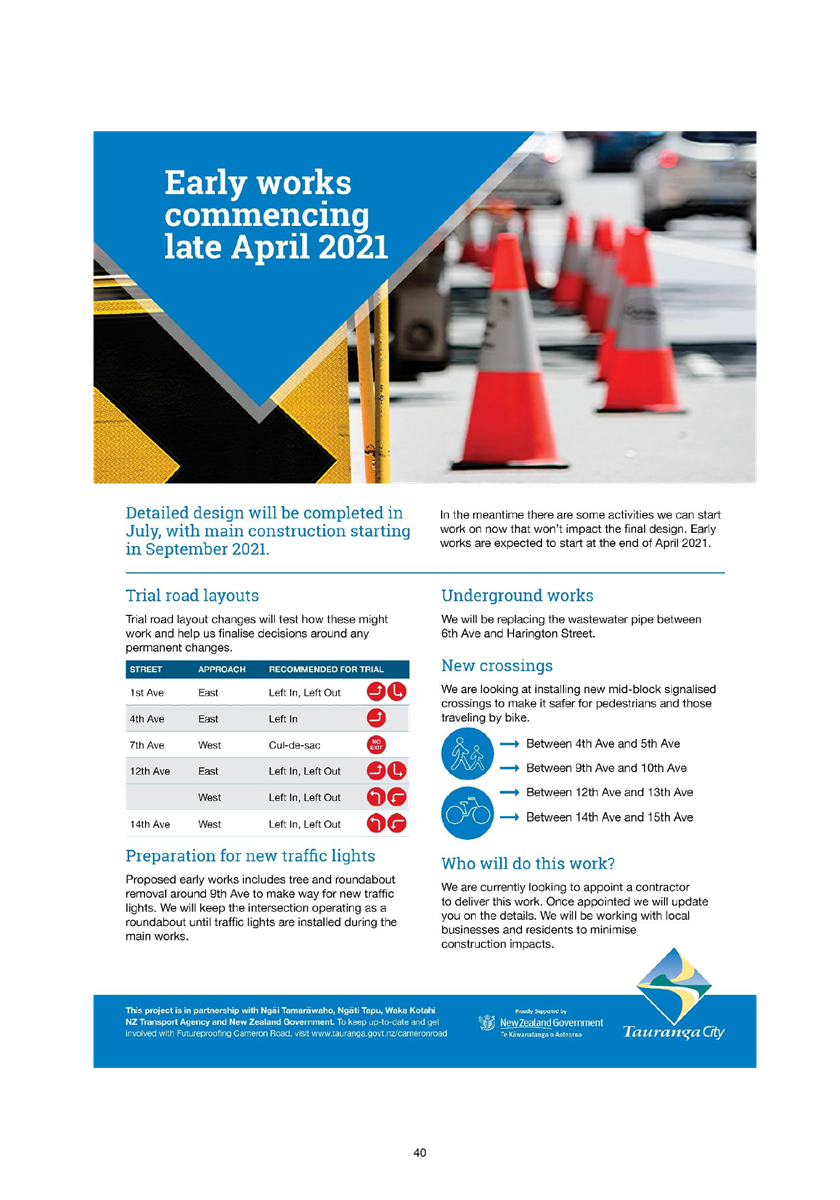
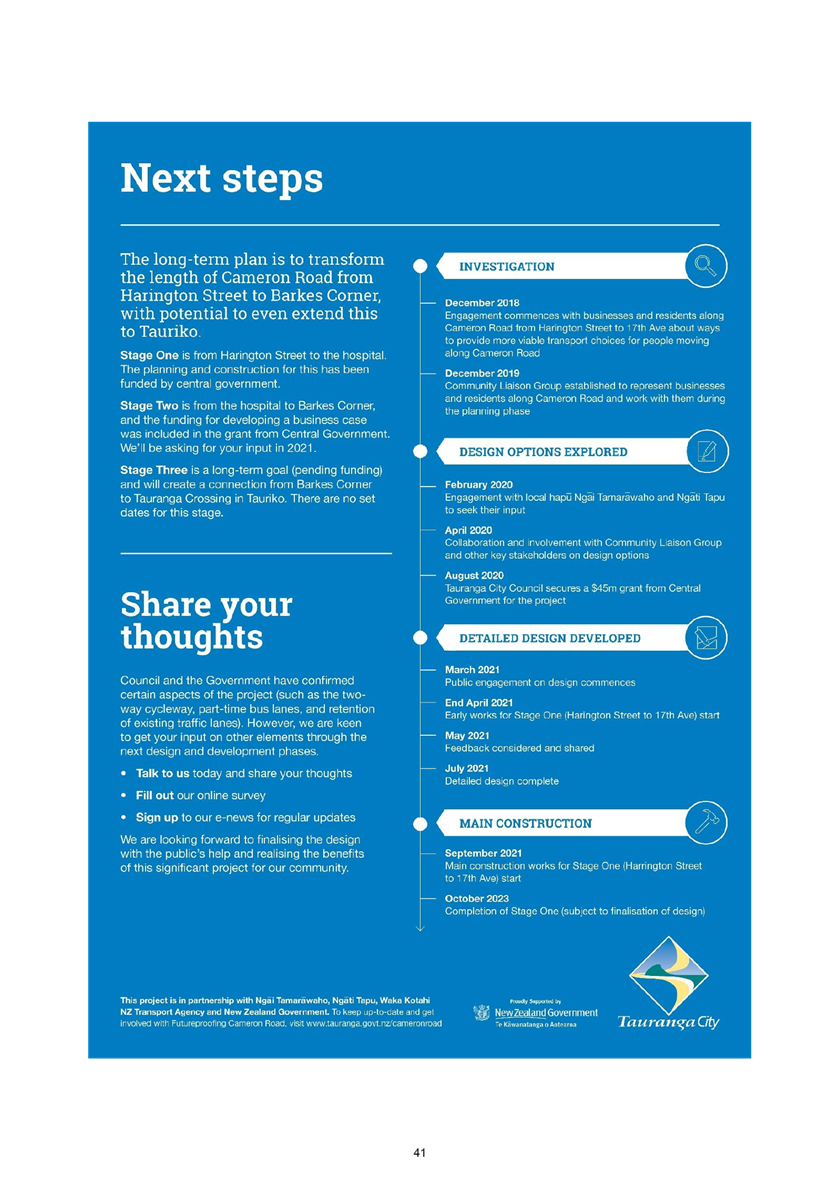
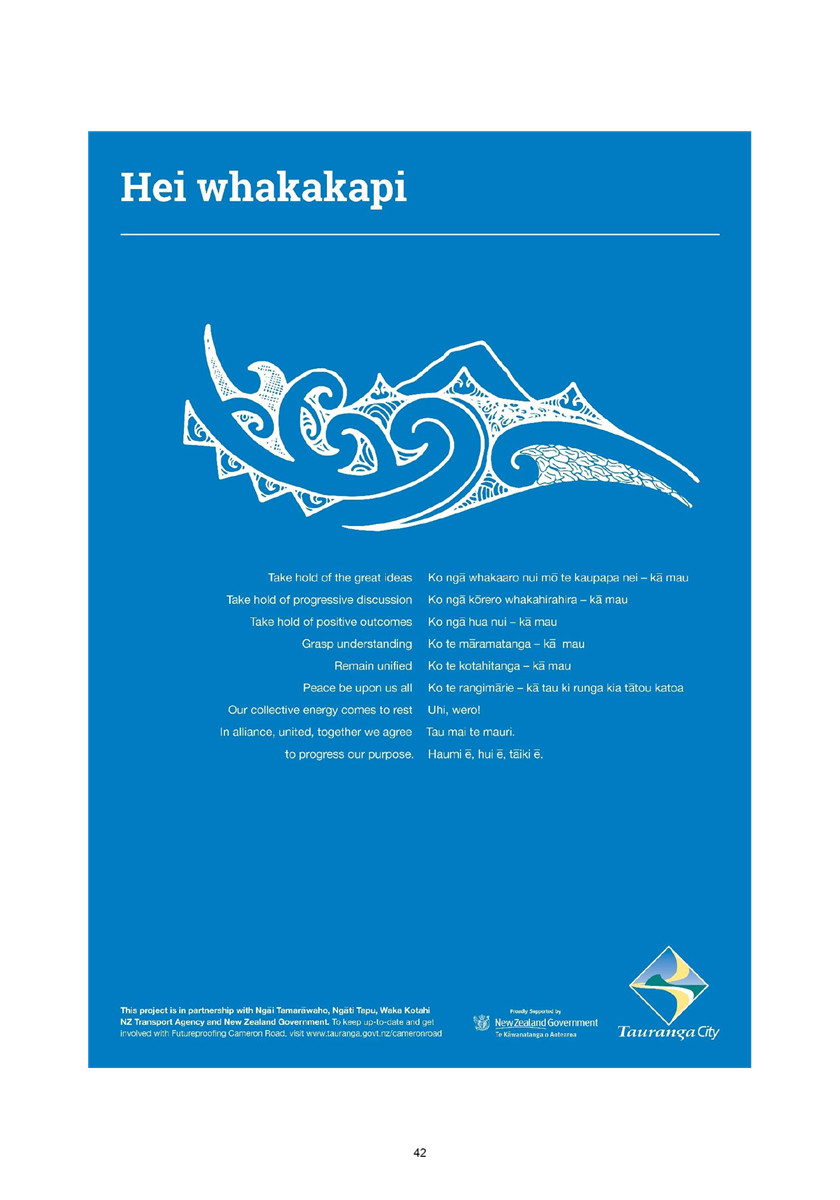
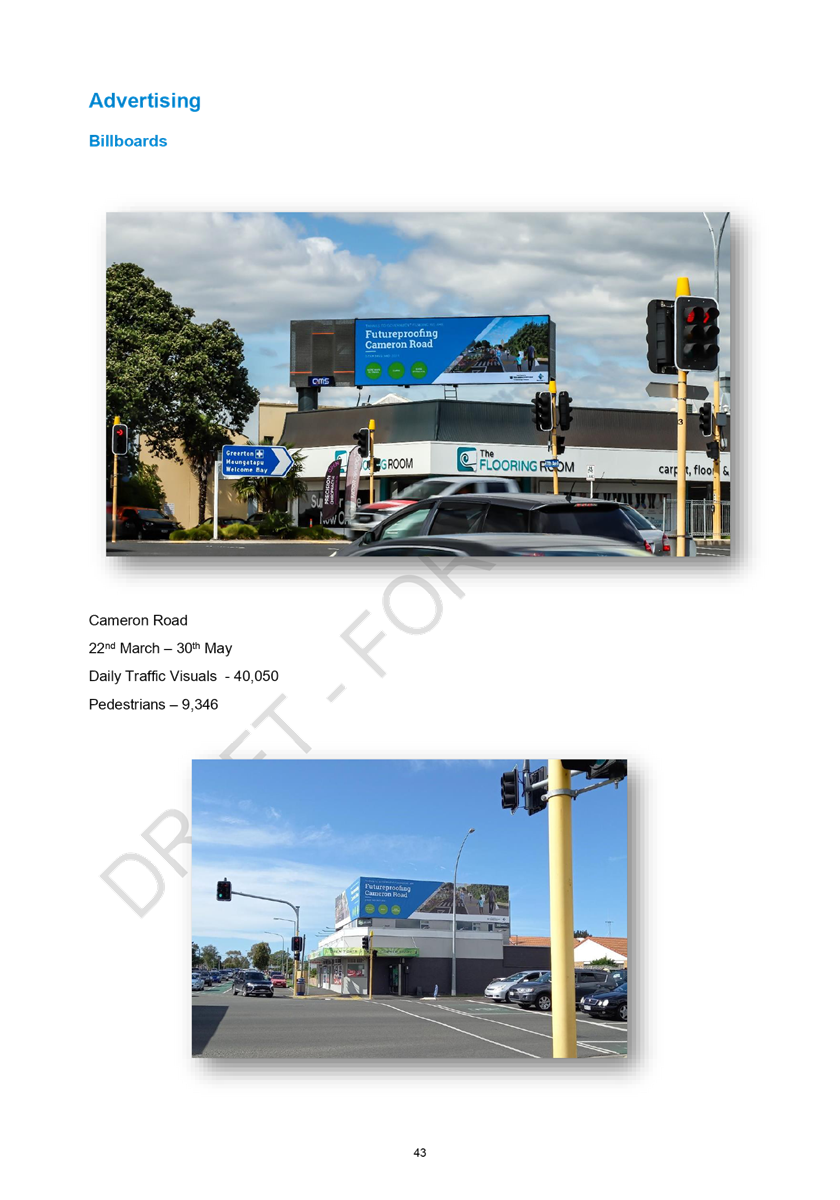
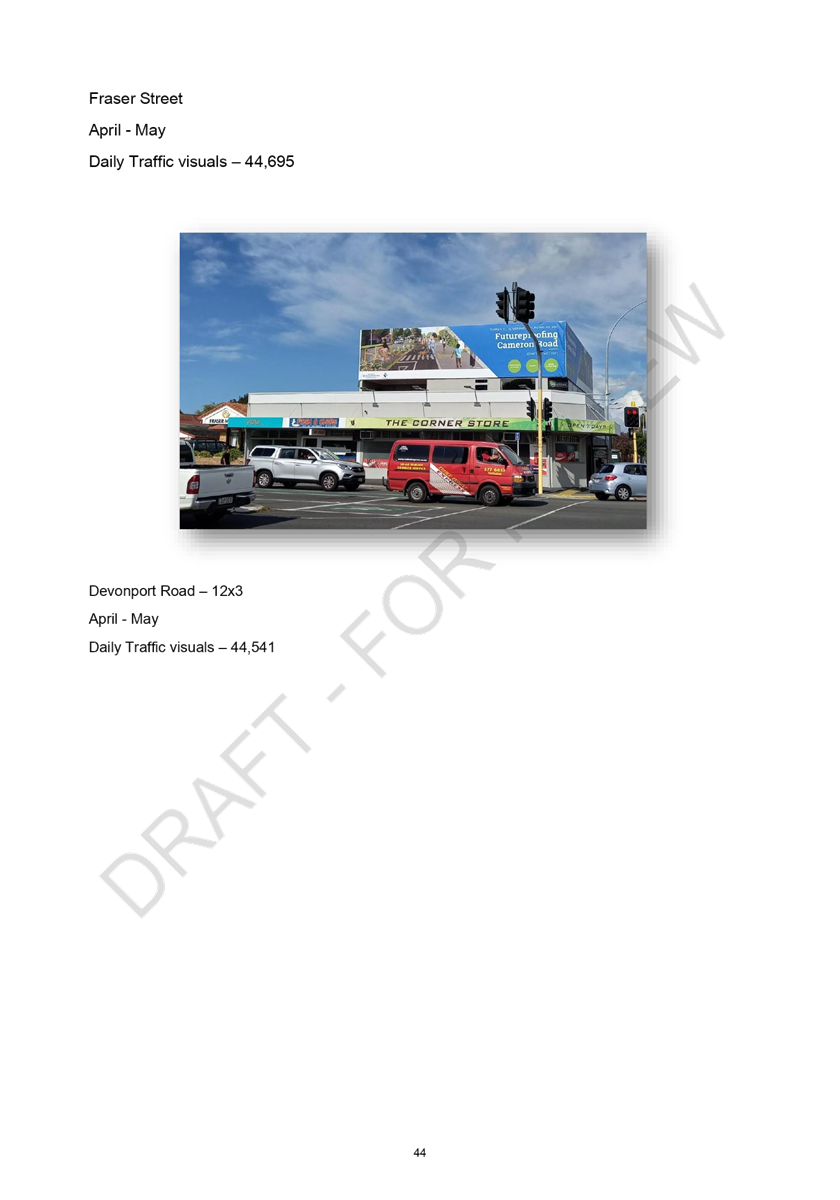
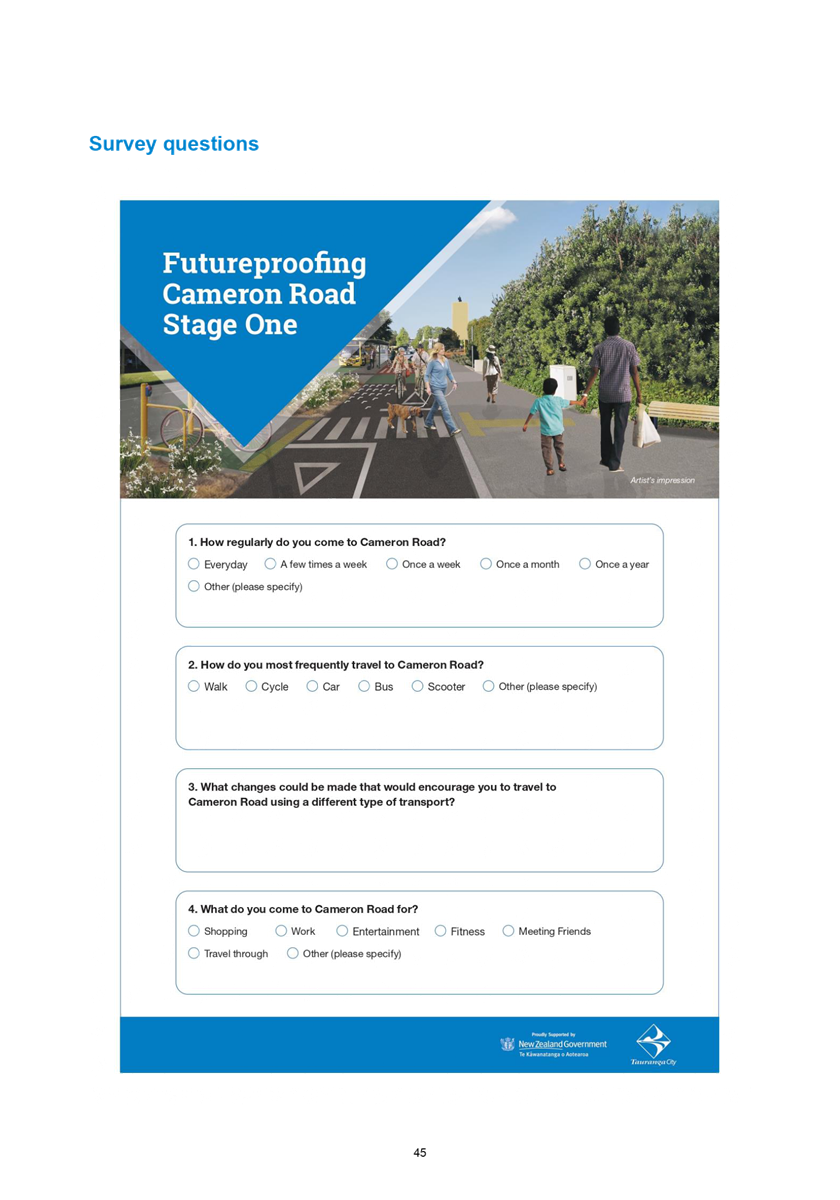
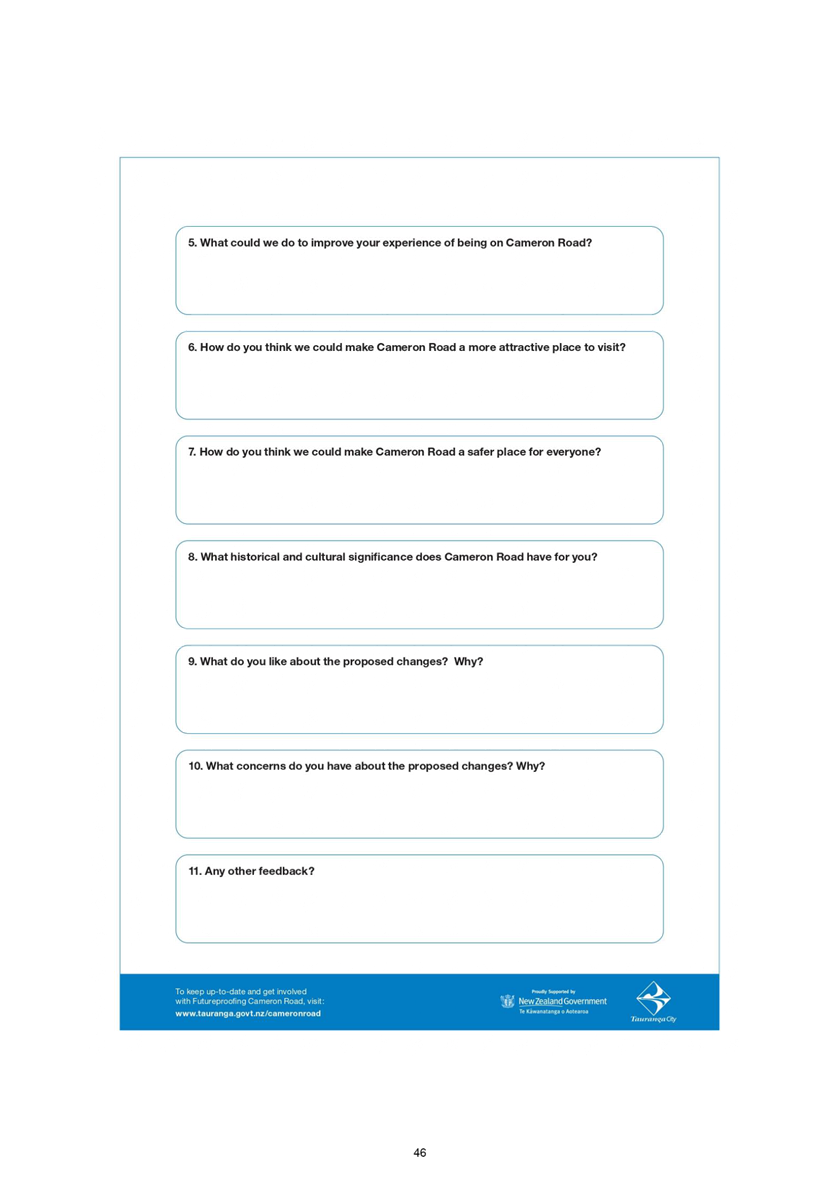
|
Ordinary Council Meeting Agenda
|
21 June 2021
|
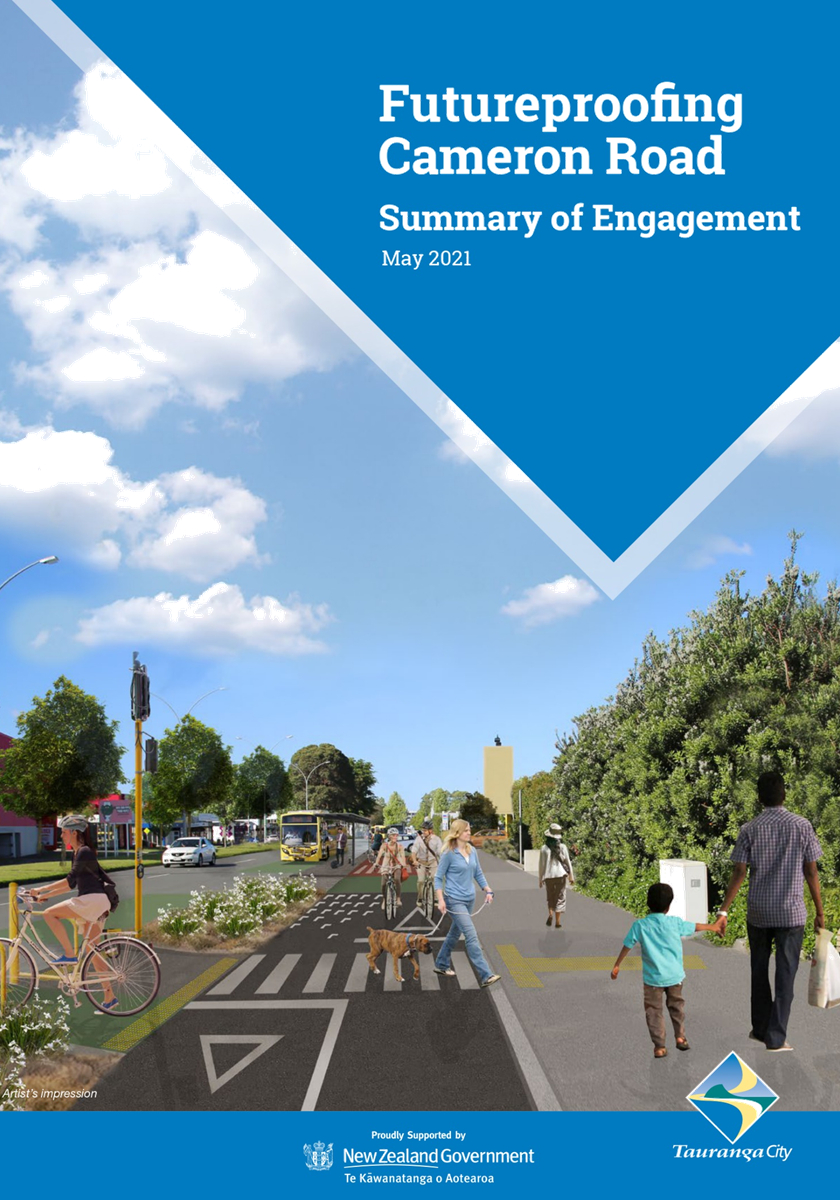
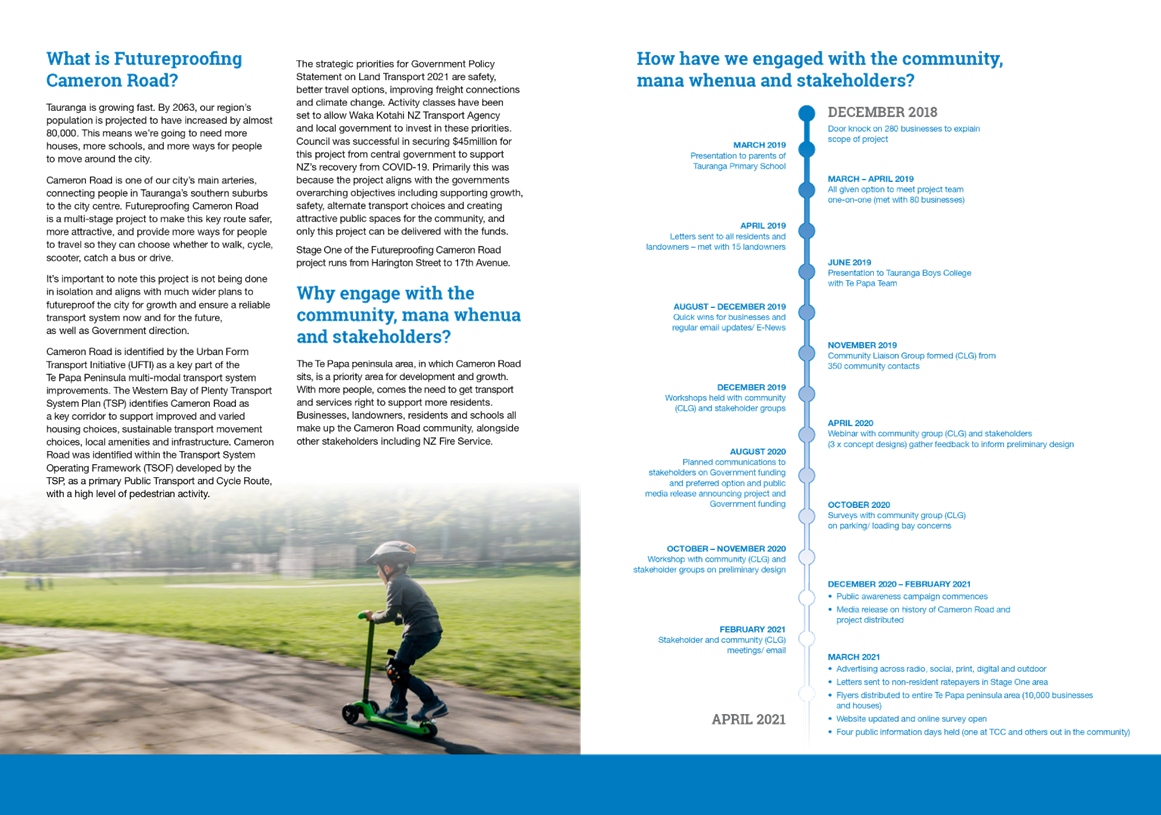
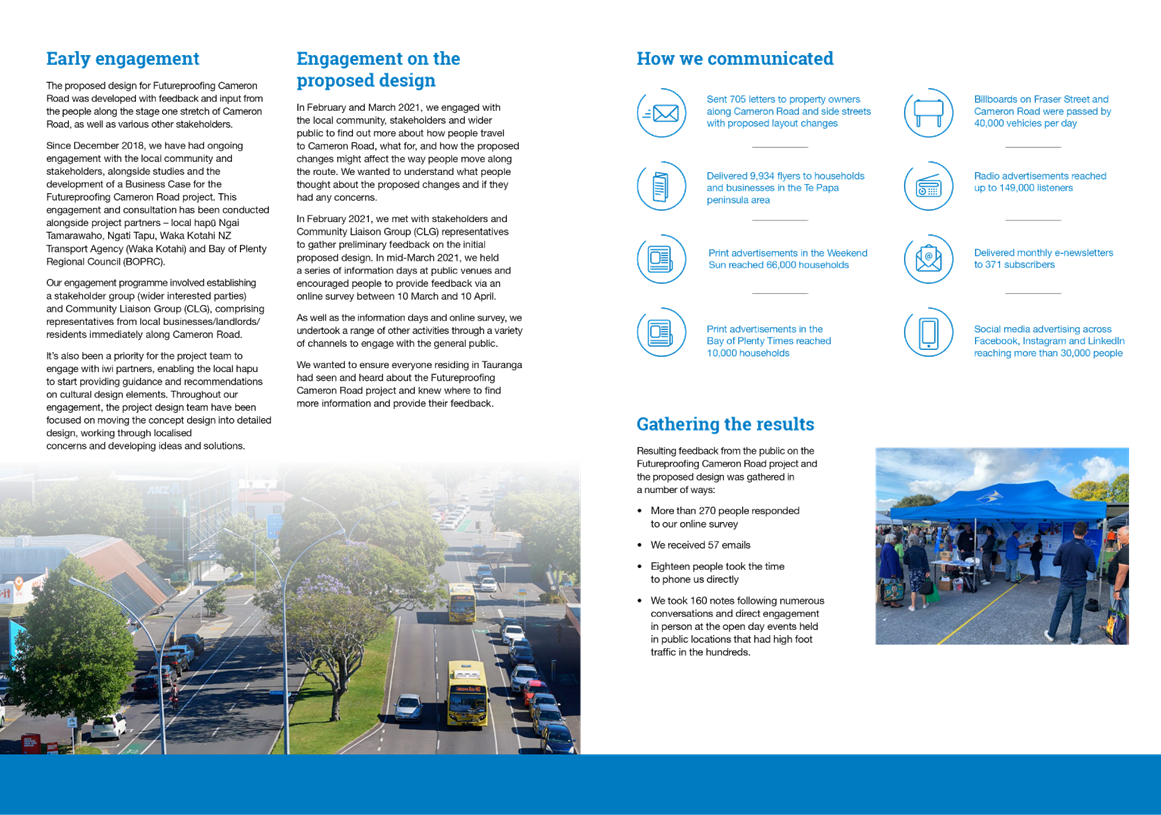

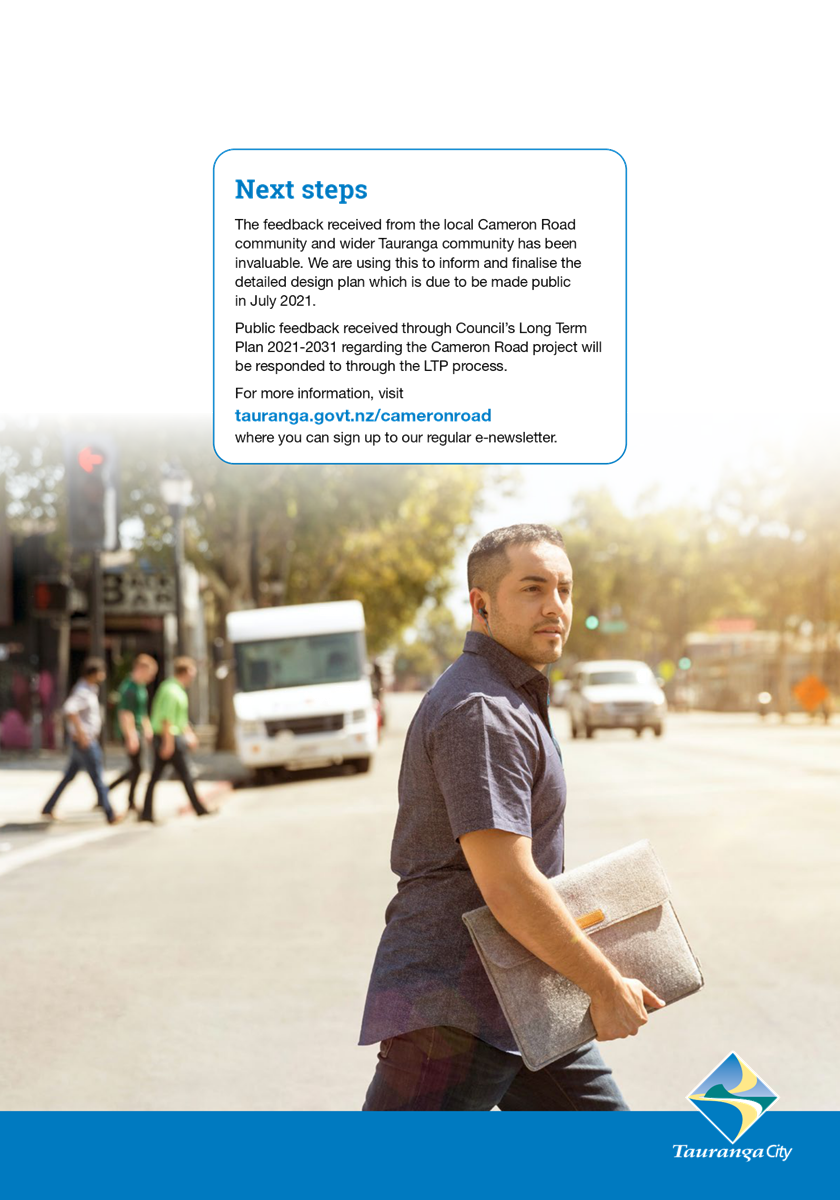
13 Public
Excluded Session
RESOLUTION TO EXCLUDE
THE PUBLIC
|
Recommendations
That the public be excluded from the following parts of
the proceedings of this meeting.
The general subject matter of each matter to be considered
while the public is excluded, the reason for passing this resolution in relation
to each matter, and the specific grounds under section 48 of the Local
Government Official Information and Meetings Act 1987 for the passing of this
resolution are as follows:
|
General subject of each matter to be
considered
|
Reason for passing this resolution in
relation to each matter
|
Ground(s) under section 48 for the
passing of this resolution
|
|
13.1 - 2021 Appointment of Directors
to the Board of Bay Venues Limited
|
s7(2)(a) - the withholding of the information is
necessary to protect the privacy of natural persons, including that of
deceased natural persons
|
s48(1)(a) - the public conduct of the relevant
part of the proceedings of the meeting would be likely to result in the
disclosure of information for which good reason for withholding would exist
under section 6 or section 7
|
|
13.2 - Marine Precinct Proposed Lot
Sale
|
s7(2)(b)(ii) - the withholding of the information
is necessary to protect information where the making available of the
information would be likely unreasonably to prejudice the commercial
position of the person who supplied or who is the subject of the
information
|
s48(1)(a) - the public conduct of the relevant
part of the proceedings of the meeting would be likely to result in the
disclosure of information for which good reason for withholding would exist
under section 6 or section 7
|
|
13.3 - Procurement of Cameron Road
Wastewater Renewals
|
s7(2)(i) - the withholding of the information is
necessary to enable Council to carry on, without prejudice or disadvantage,
negotiations (including commercial and industrial negotiations)
|
s48(1)(a) - the public conduct of the relevant
part of the proceedings of the meeting would be likely to result in the
disclosure of information for which good reason for withholding would exist
under section 6 or section 7
|
|
13.4 - Direct procurement for Cameron
Road and Fraser Street Pedestrian Crossings
|
s7(2)(h) - the withholding of the information is
necessary to enable Council to carry out, without prejudice or disadvantage,
commercial activities
|
s48(1)(a) - the public conduct of the relevant
part of the proceedings of the meeting would be likely to result in the
disclosure of information for which good reason for withholding would exist
under section 6 or section 7
|
|
14 Closing
Karakia



































